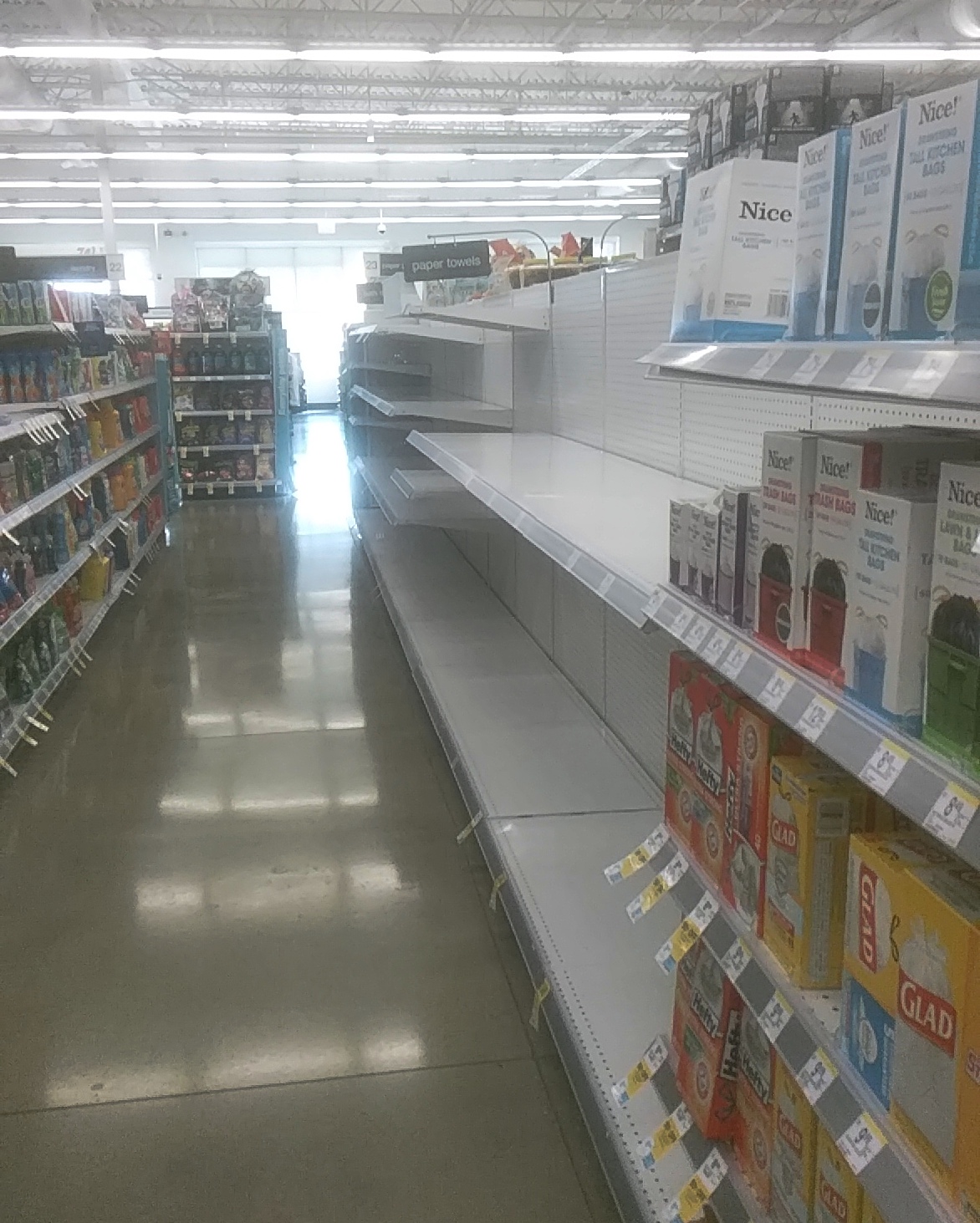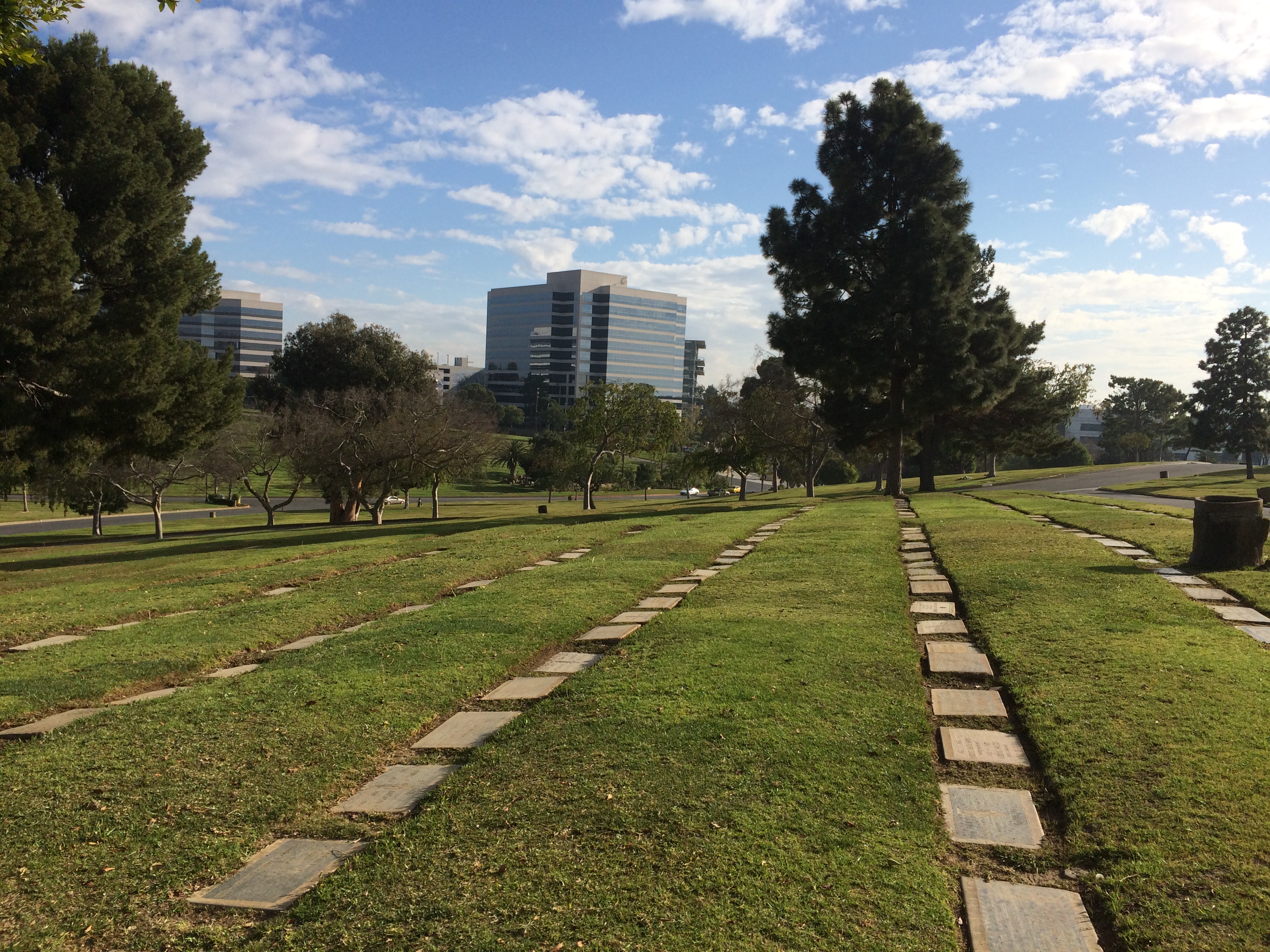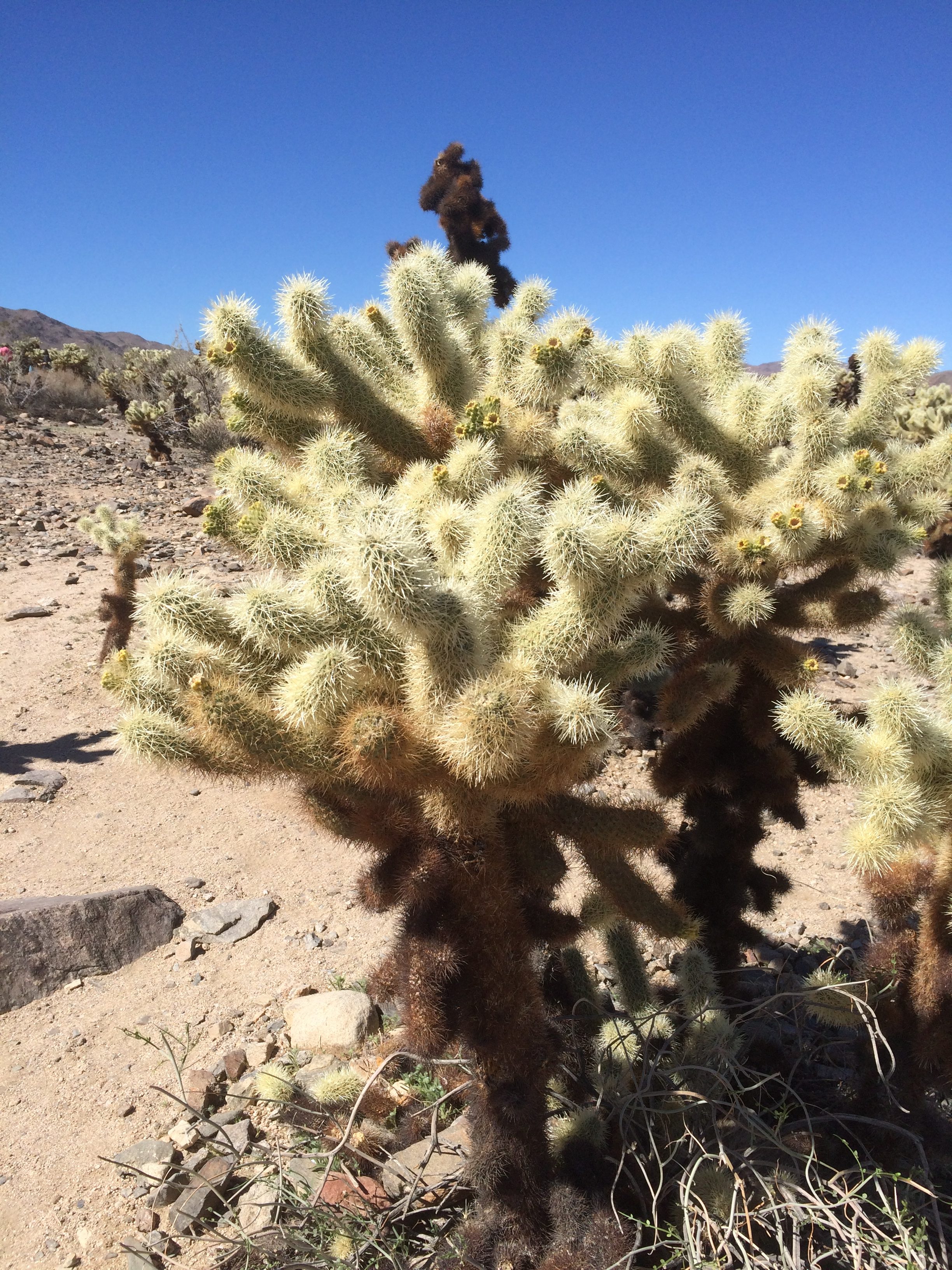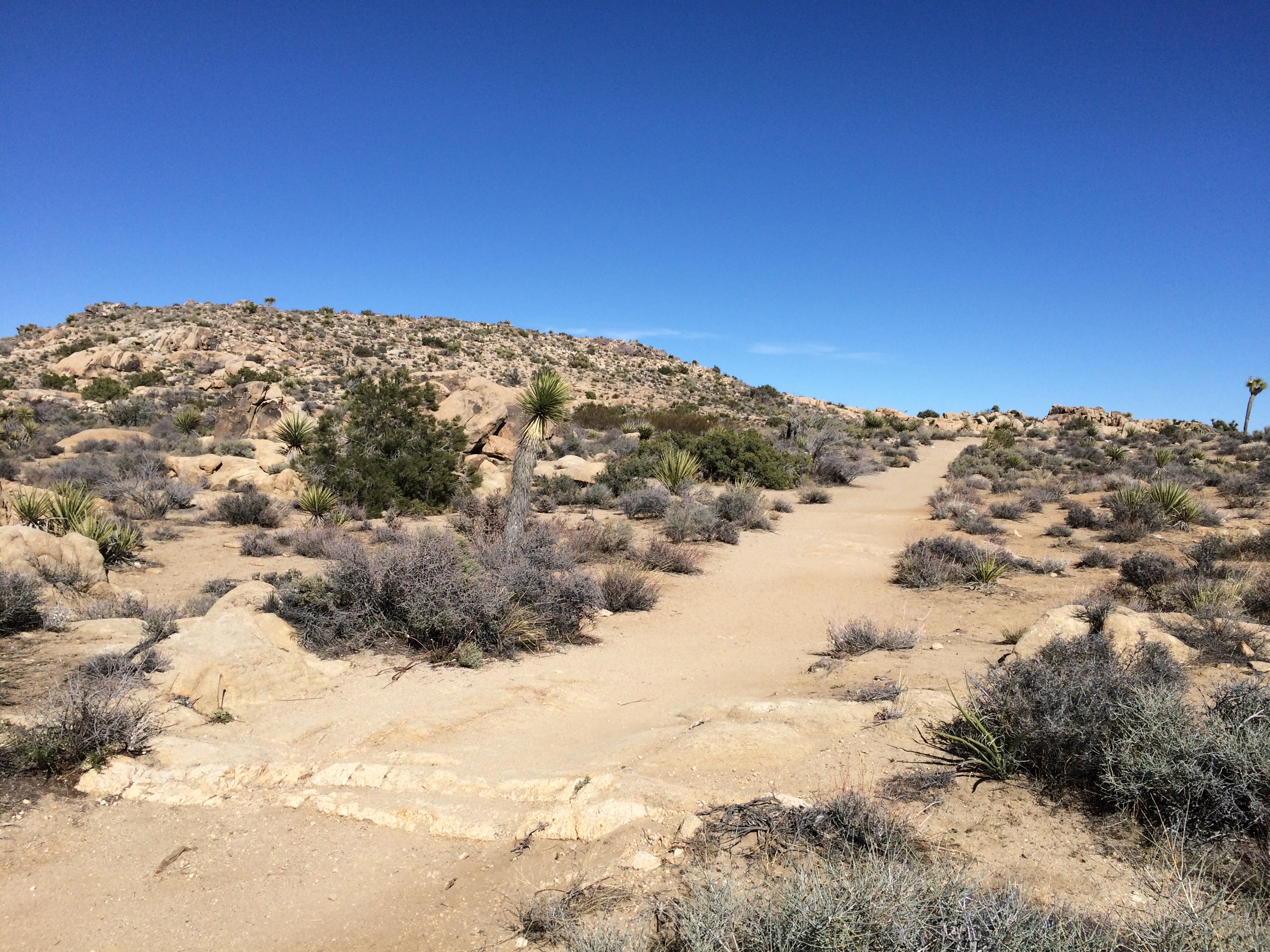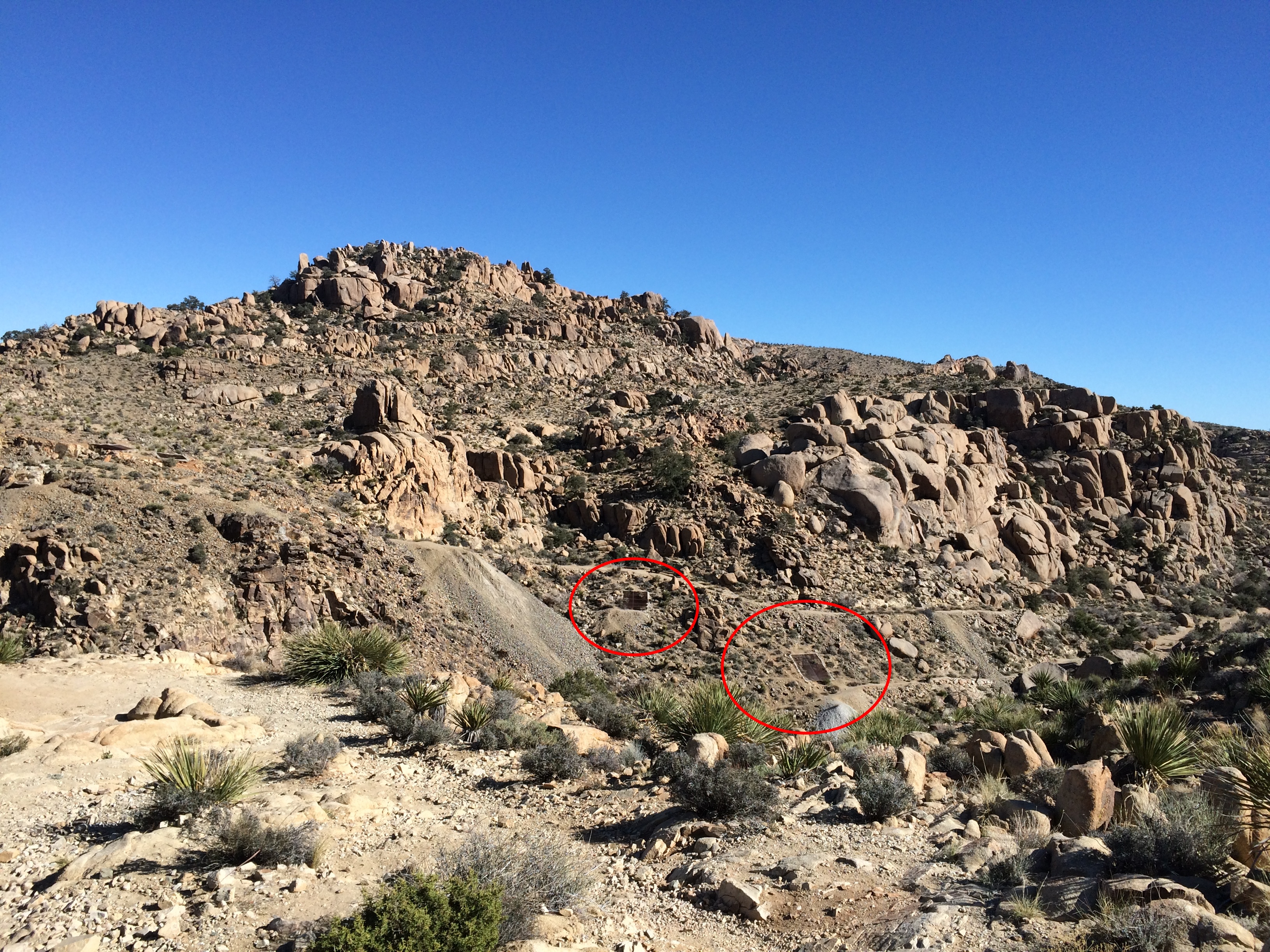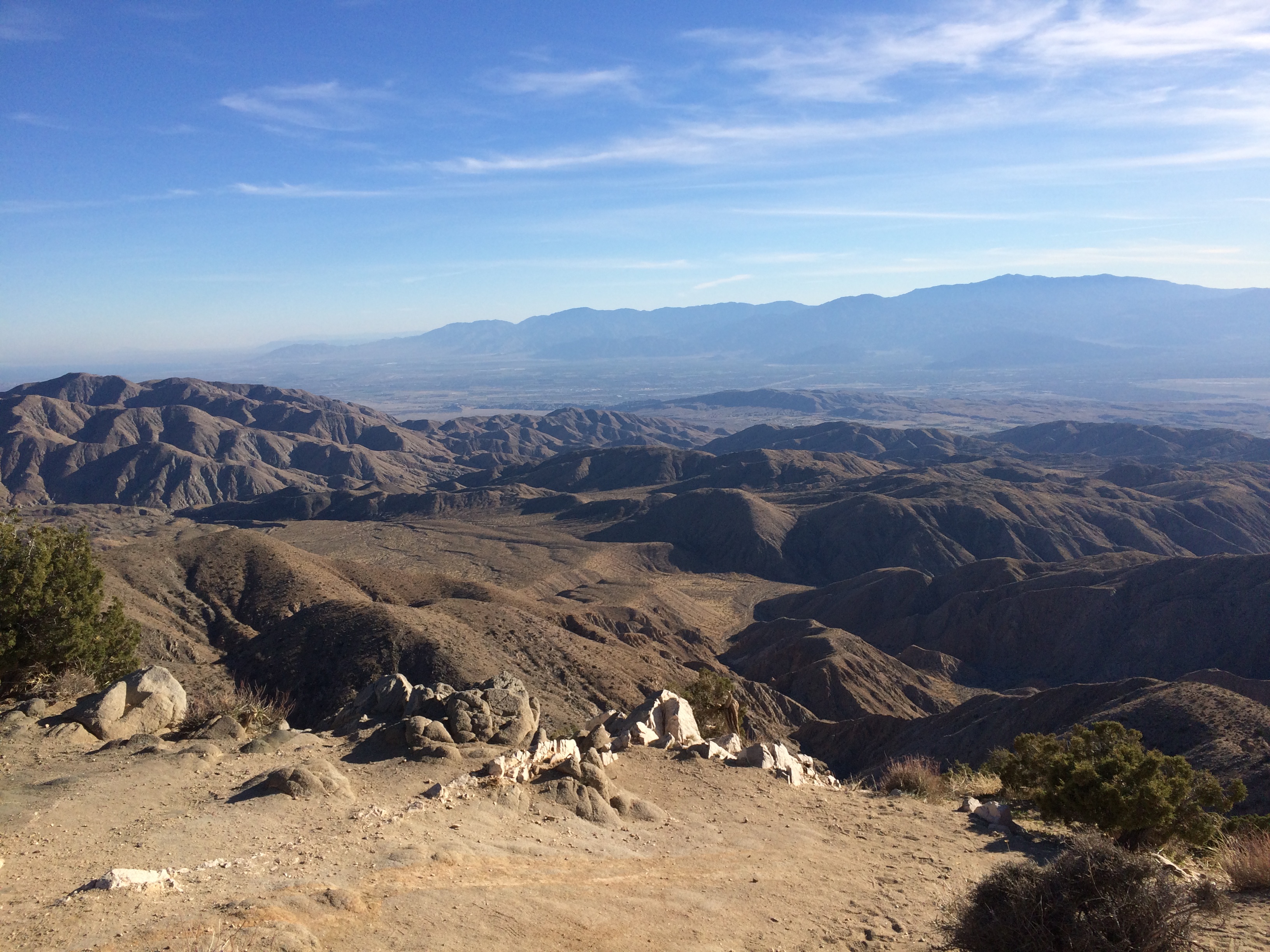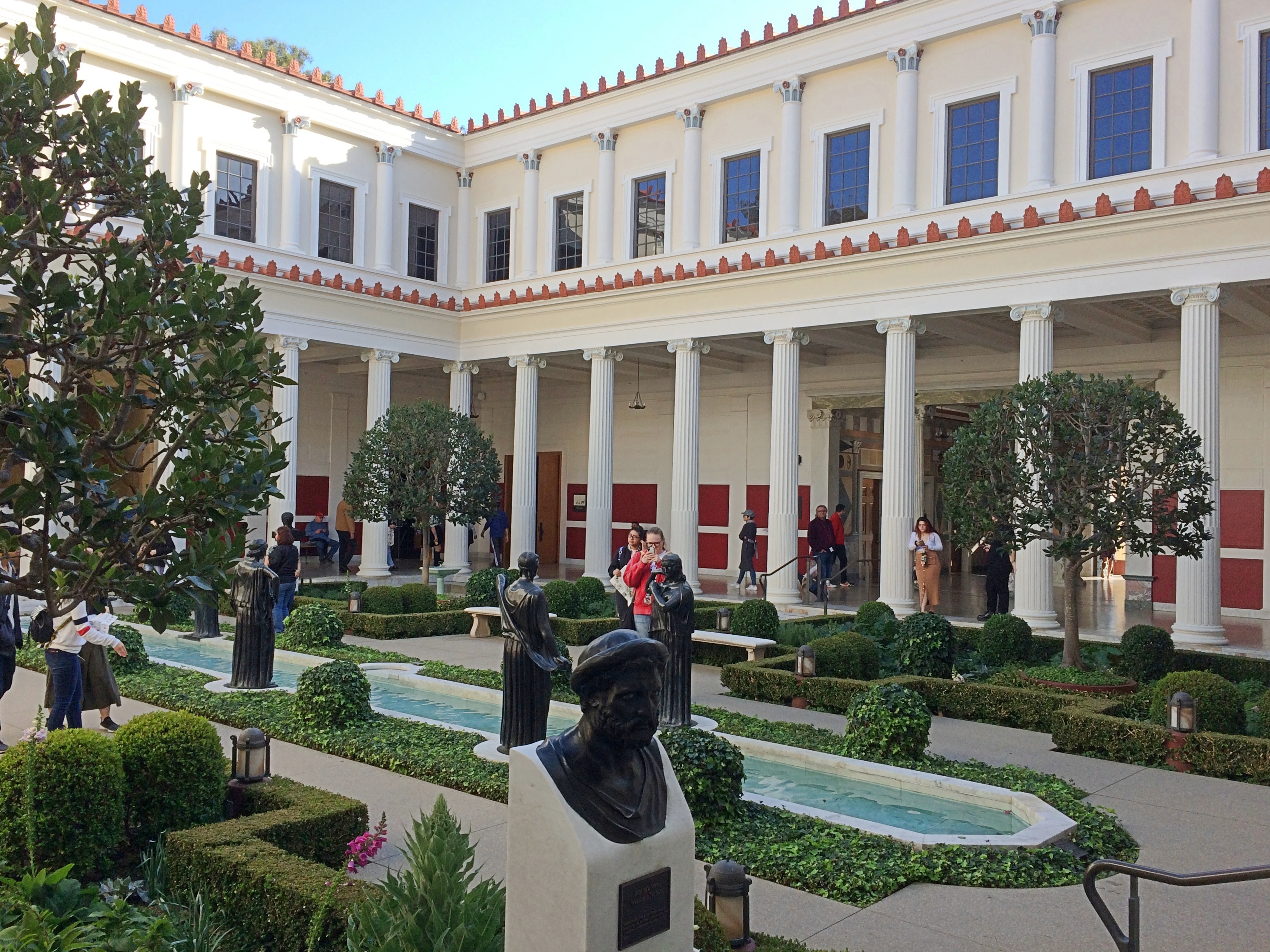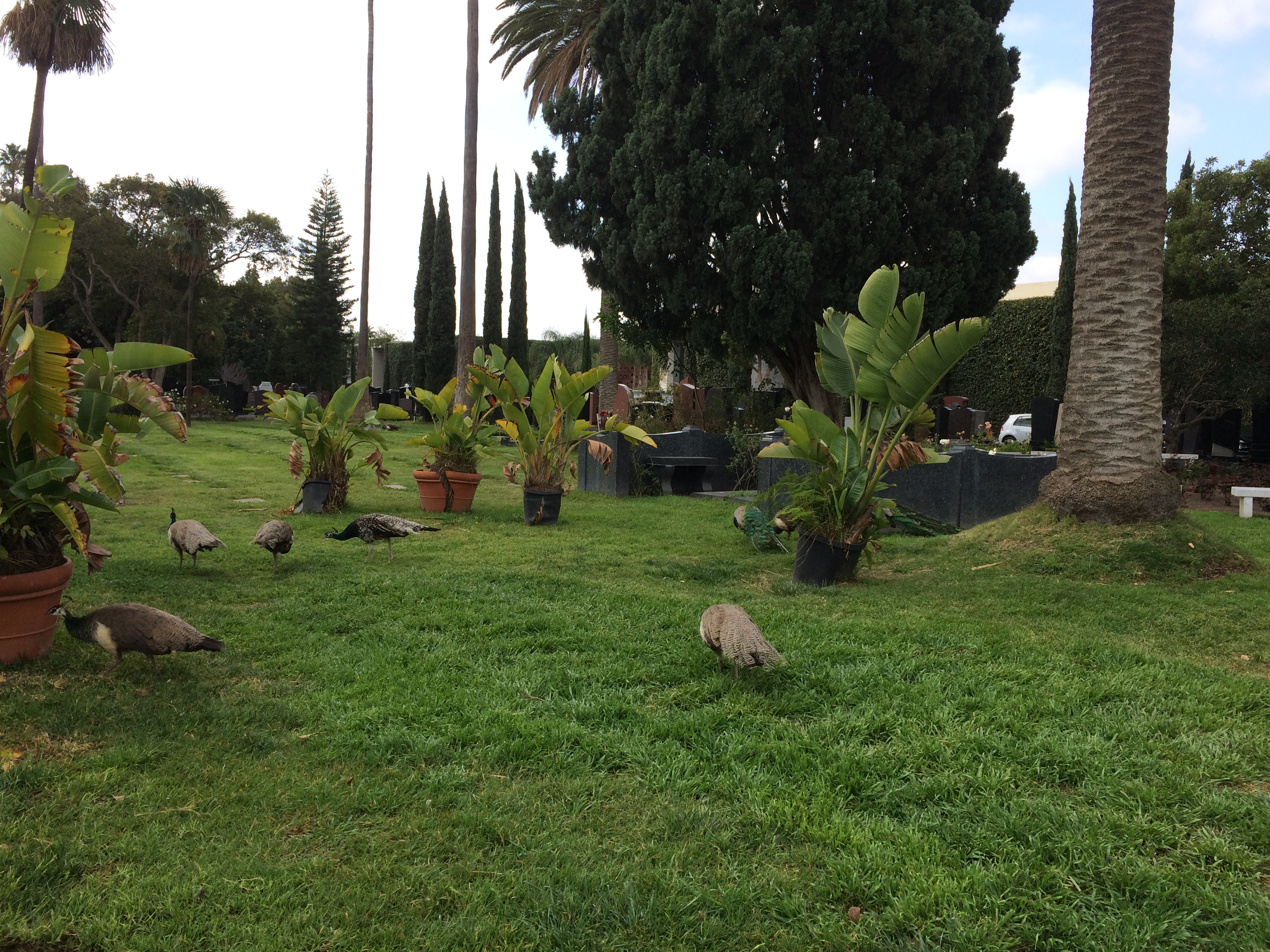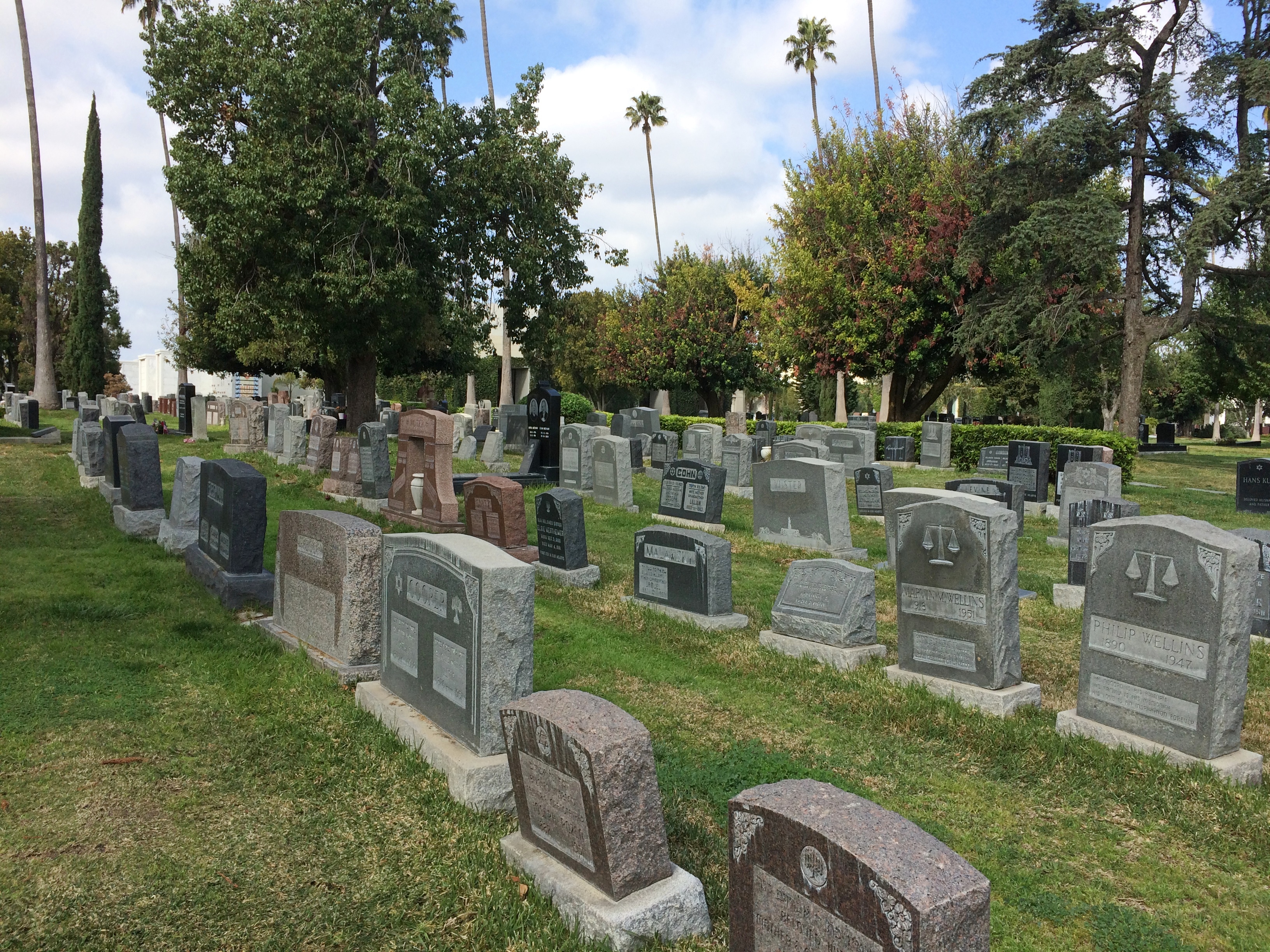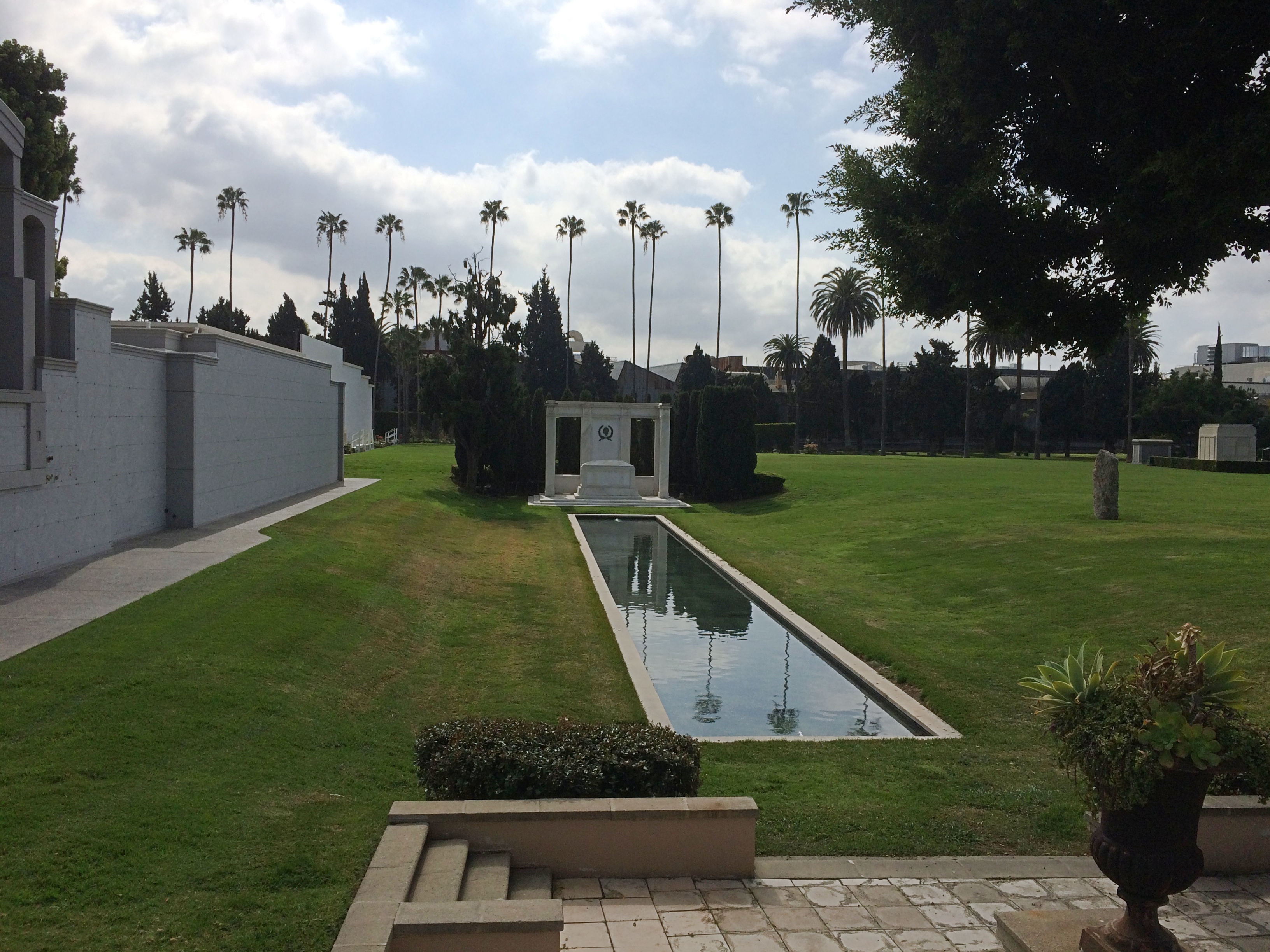Restaurants and bars and a lot else in Illinois might be closed today, but the primary election went on as scheduled. I walked to my polling place and voted fairly early in the morning.
 There were three election judges on hand, and two other voters. Two of the judges, youngish women, wore rubber gloves. One of the judges, a male retiree from the looks of him, did not.
There were three election judges on hand, and two other voters. Two of the judges, youngish women, wore rubber gloves. One of the judges, a male retiree from the looks of him, did not.
Monthly Archives: March 2020
Errands in the Time of Novel Coronavirus
Congratulations to Geof Huth, now a grandfather. His grandson was born in California last week, and since then he’s posted a lot of pictures of the lad on Facebook. Later, with any luck, he can tell the kid, “Yeah, there was a lot of fuss going on when you were born, and not just about you.”
Seems like every organization I’ve ever given my email address to — even some I don’t remember sharing it with — has sent me a coronavirus message. Except for the township library. I wish I’d gotten a message from that entity a few days ago, alerting me that it was closing soon for the public good.
Instead, when we arrived yesterday, a sign on the door said that it had closed starting the day before. We’d had the idea to stock up on some DVDs to watch during the duration. Borrow books, not so much. Got plenty enough of those.
Even in these vexed times, there are errands to do. One took me to a local pharmacy for needful medicine, which I had no trouble with, but where I saw a much-reported WTF phenomenon with my own eyes.
The Venezuelanization of the consumer paper shelves.
Not This Year
We’d planned to see The Pirates of Penzance this year in Hyde Park on Saturday, by the Gilbert & Sullivan Opera Co. We’ve been seeing their shows most years for a while now, since Yeoman of the Guard in 2015.
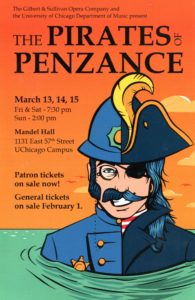 As you’d expect, the show was cancelled. As recently as a week ago, I didn’t think that was going to happen, but the country is going into no-frills mode faster than expected. In an age besotted with video and other impersonal entertainment, it’s interesting how many diversions still involve numbers of human beings coming together at the same place at the same time.
As you’d expect, the show was cancelled. As recently as a week ago, I didn’t think that was going to happen, but the country is going into no-frills mode faster than expected. In an age besotted with video and other impersonal entertainment, it’s interesting how many diversions still involve numbers of human beings coming together at the same place at the same time.
A pretty minor inconvenience for us, though I expect the cast and crew were upset all their work came to nothing. Much more than diversions have been disrupted. Ann’s school is out this week, ahead of its scheduled spring break next week, so that makes two weeks off — at least. After that, “remote learning.” Maybe. Down at UIUC, no more physical classes for Lilly till further notice. I’ll bet there will be no graduation ceremony in May, which would be too bad.
For me, I’m going to work at home. Wait, I’ve been doing that for almost 15 years now. In the early days, I remember telling people on the phone, usually someone I needed to interview, that they might hear noise in the background without warning. The noise of a young child. I can’t remember the last time I warned anyone about that. These days, occasionally the dog makes noise, but even that’s a rarity, since her idea of a good time is lounging quietly on a flat surface.
So I’m amused by the current flood of articles about working from home — it’s great, it’s terrible, How To Do It, What Equipment Do I Need? Sheesh. Ours is a time of overthinking. My expert opinion? It’s OK. Mostly tolerable. Helps not to mind hours and hours by yourself, which seems to unnerve some people. Can’t say I feel isolated, since my job — and the adverb is correct — is literally to find out things from other people, which often enough means talking to them. I suppose not everyone could say that about their at-home jobs, however.
The best part of working at home is the commute. The office as a work environment was invented by smug morning people. A one-or-so-minute commute (there’s always a bathroom stop first) is a way to ameliorate the tyranny of office hours. Working times are roughly the same, but there’s no back and forth.
In lieu of The Pirates of Penzance on stage, here are some YouTube clips of everyone’s favorite scene. Mine anyway. Impersonal entertainment will have to do for a while.
Recorded at the Stratford Festival in 1985. Many of its shows were cancelled just Friday.
From the 1983 movie version.
At the English National Opera more recently, in 2015.
The tune with other words. Couldn’t very well leave this out.
Tom Lehrer is still with us, last I heard. Next month he will be what I hope is a hale 92 years old.
California Leftovers
I drove by Randy’s Donuts near LAX, but didn’t stop to buy any. The first place I did go in Los Angeles, practically right off the plane on February 21, was Roscoe’s House of Chicken and Waffles on W. Manchester Blvd. Mm, good. Almost as good as Maxine’s in Indianapolis, which is high praise.
After I ate chicken and waffles there — a late lunch — I determined that I didn’t have time to go all the way to Venice and stroll around the canals before I had to be back in Ladera Heights to check into my short-term residence. So Venice, California, remains an unfulfilled ambition. Like Venice, Italy.
Instead I drove over to Holy Cross Catholic Cemetery, which is on the edge of Culver City. It has everything it needs to be an aesthetic cemetery — land contour, trees and other greenery — except upright stones or much funerary art.
Still, I found Jimmy Durante. That’s something. Inka Dinka Doo.
I had lunch my first full day in Los Angeles at Grand Central Market downtown. Once a market, now it’s mostly a food hall. A popular place. The likes of which will be largely empty for a while now? This pic is status quo ante.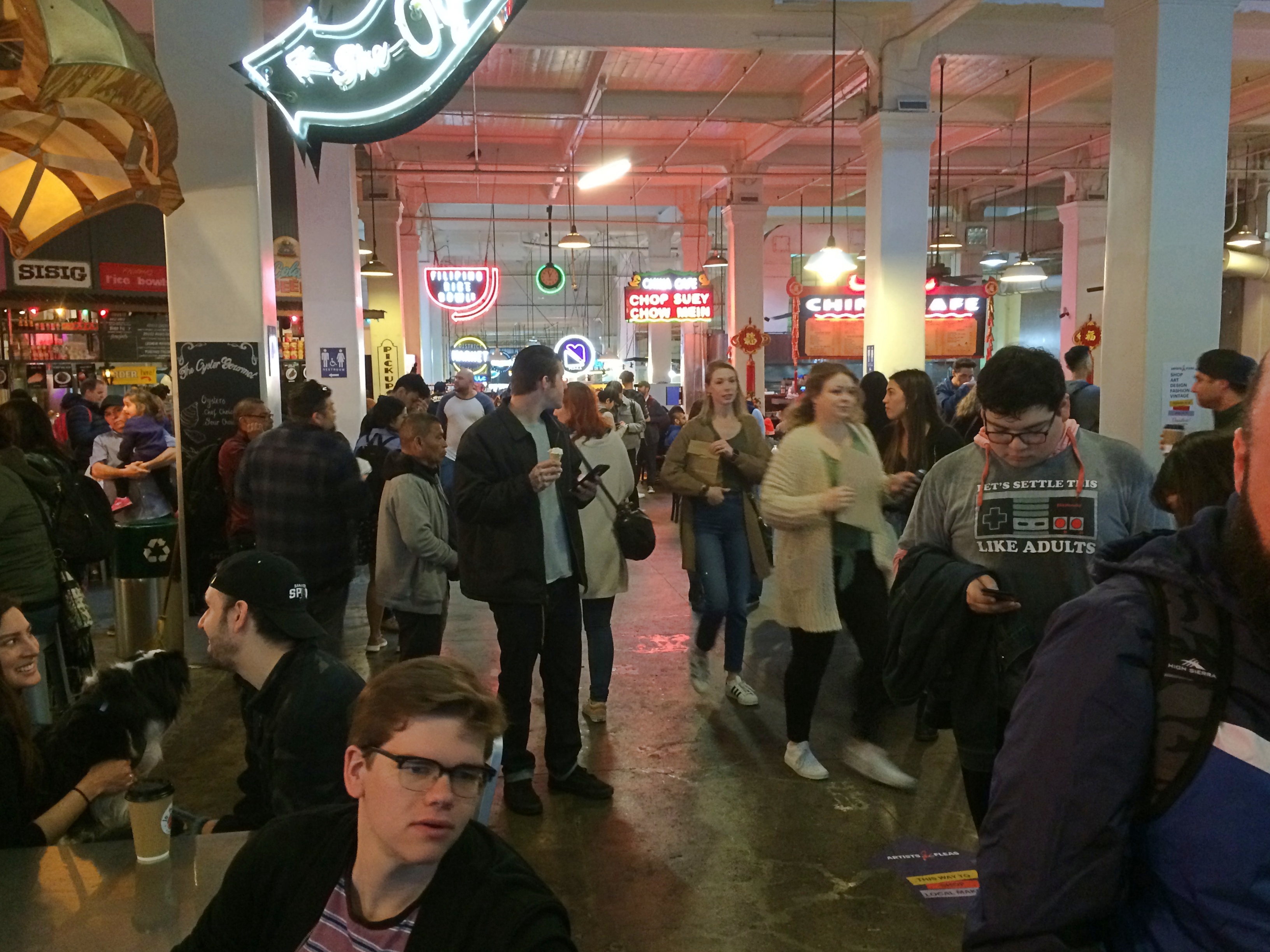
A large selection of eats. With some good neon. Overpriced, though. While I was eating, rain started to fall outside. Heavy for about half an hour. That was the only rain during my visit.
Overpriced, though. While I was eating, rain started to fall outside. Heavy for about half an hour. That was the only rain during my visit.
Saw all too many of these on the sidewalks of LA.
 I even saw a man kick one hard in disgust.
I even saw a man kick one hard in disgust.
I was within sight of the Santa Monica Pier when in Santa Monica, but I didn’t have the energy to actually visit the pier. Didn’t want to put up with the crowds, either.
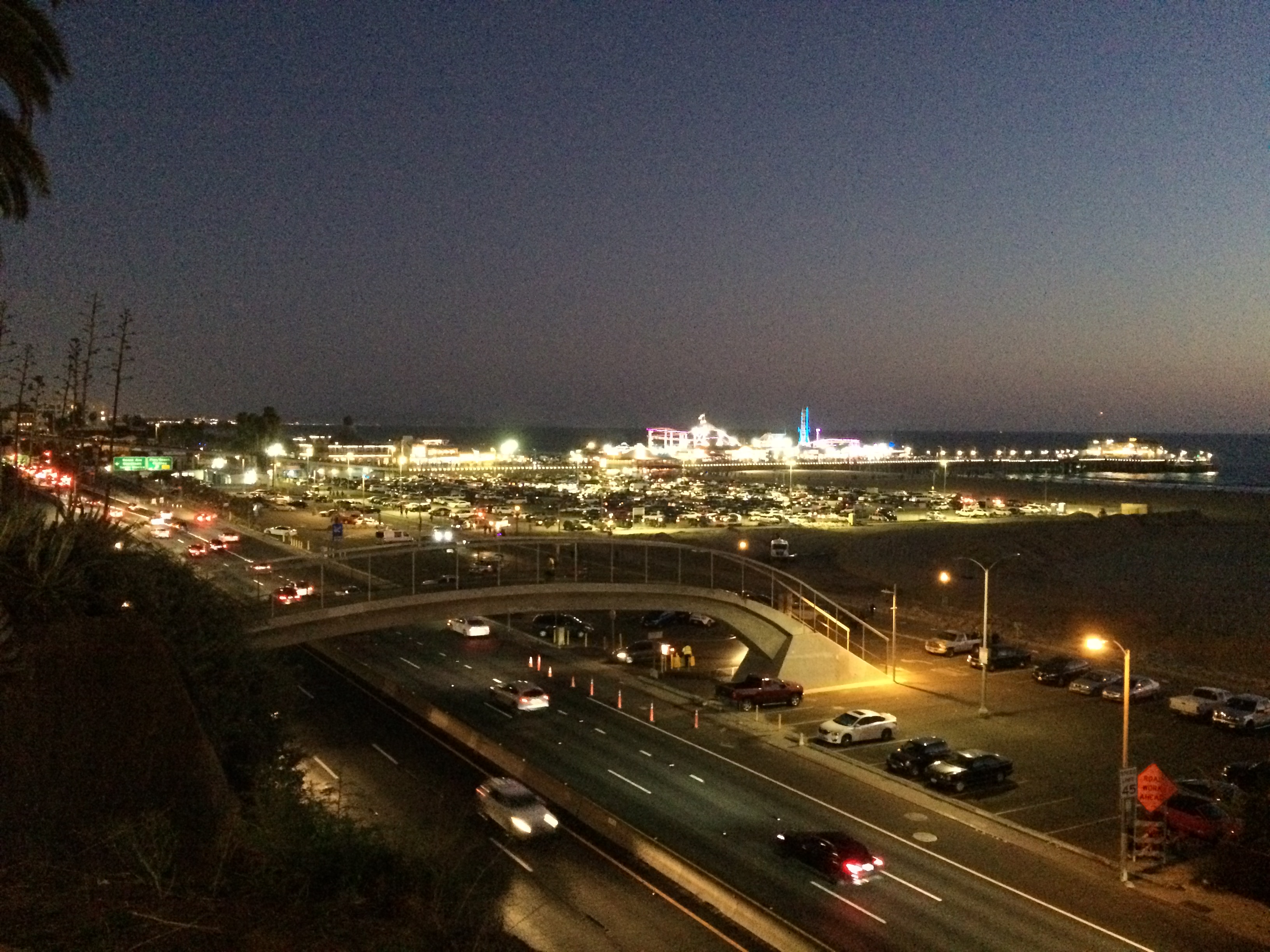 I did see this.
I did see this.
 That would be the opposite of the sign in downtown Chicago.
That would be the opposite of the sign in downtown Chicago.
The East Garden at the Getty Villa includes this fountain.
 “The enchanting central wall fountain represents a replica of a mosaic and shell fountain from the House of the Large Fountain in Pompeii,” Alice’s Garden Travel Buzz says. I’ll take Alice’s word for it.
“The enchanting central wall fountain represents a replica of a mosaic and shell fountain from the House of the Large Fountain in Pompeii,” Alice’s Garden Travel Buzz says. I’ll take Alice’s word for it.
On my return from Texas on March 1, I had a fine view of Chicago as we flew in. First to the south of O’Hare, which was visible as a whole, then across the city and over downtown — I didn’t know that was allowed — and out over Lake Michigan, where we turned. The flight back to O’Hare crossed over the North Side of Chicago, so I got a sky-high view of Wrigley Field, and then lower and lower over the suburbs near O’Hare. I recognized some of the larger roads. Some intersections. A building or two. Wait, what’s that pyramid-shaped building?
The guy next to me on my flight home from Texas rubbed his hands with sanitizer three or four times over two hours. After touching the seatback tray table, I think. If one impact of the novel coronavirus is to encourage people to wash (or clean) their hands more, that’s a good thing.
Joshua Tree National Park
On the morning of February 26, 2020, I arrived at the south entrance of Joshua Tree National Park. Near the end of the day, I would leave via the west entrance.
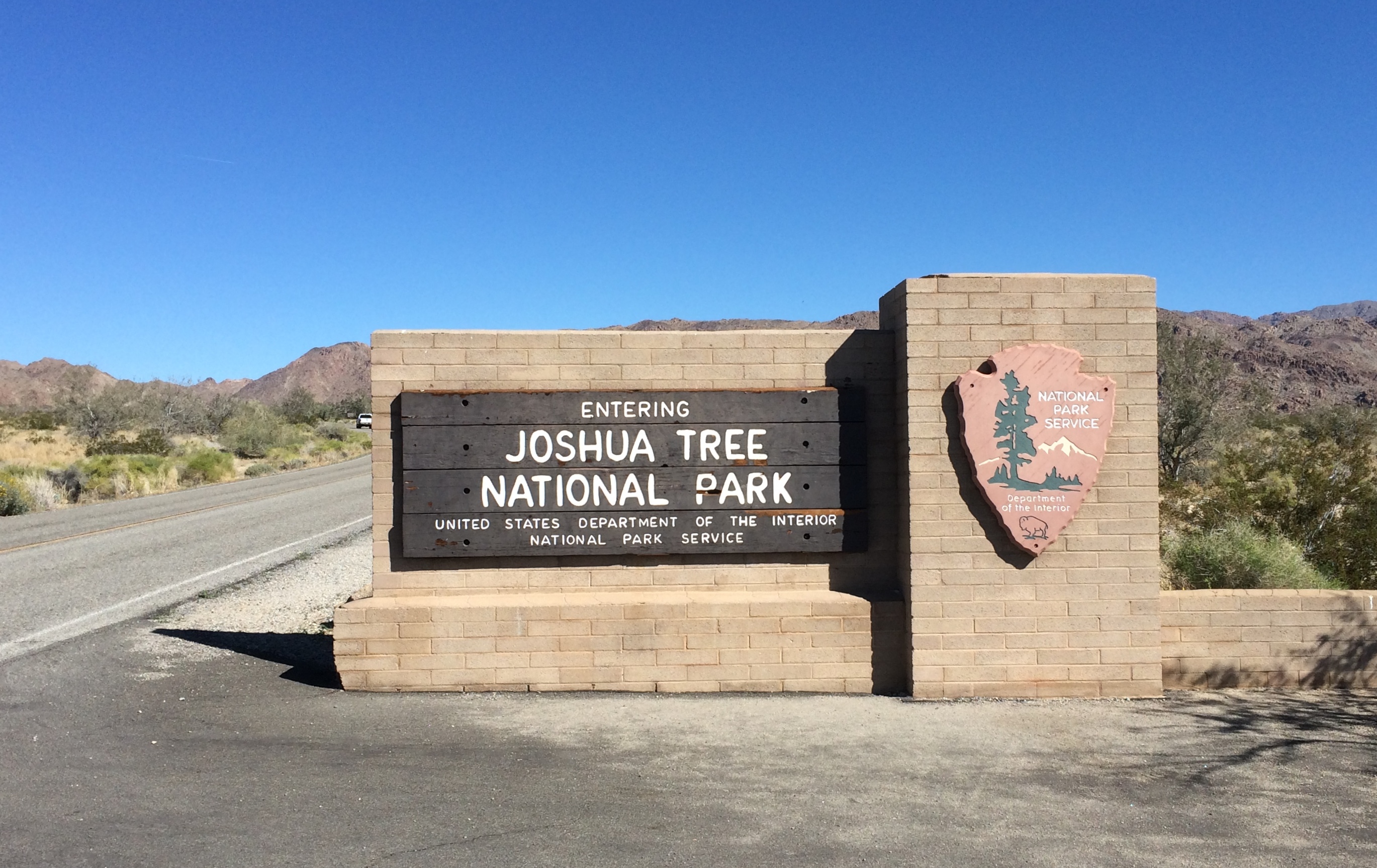 The park includes sections of two different deserts, the Colorado and the Mojave. The territory around the south entrance is Colorado Desert, and not much populated by Joshua trees. It would be a while before I saw any Joshua trees, which are actually yucca plants (Yucca brevifolia), in the national park named for them.
The park includes sections of two different deserts, the Colorado and the Mojave. The territory around the south entrance is Colorado Desert, and not much populated by Joshua trees. It would be a while before I saw any Joshua trees, which are actually yucca plants (Yucca brevifolia), in the national park named for them.
Though folk etymologies involving Mormons exist when it comes to why Joshua trees are called that, the origin of the term is uncertain. The plant has also been called, in English, the tree yucca and the yucca palm.
One more thing: the Joshua tree depicted by U2’s The Joshua Tree album was near Darwin, California — which is close to (but not in) Death Valley NP, not Joshua Tree National Monument, as it was then. Come to think of it, Death Valley was a national monument in 1987 as well.
My first walk of the day was along the trail leading out of Cottonwood Spring. Where there’s water, there are large trees.
 Then it’s off to more arid hills.
Then it’s off to more arid hills.
 With rock formations. This one’s actually pretty small compared to some others I would see later in the day.
With rock formations. This one’s actually pretty small compared to some others I would see later in the day.
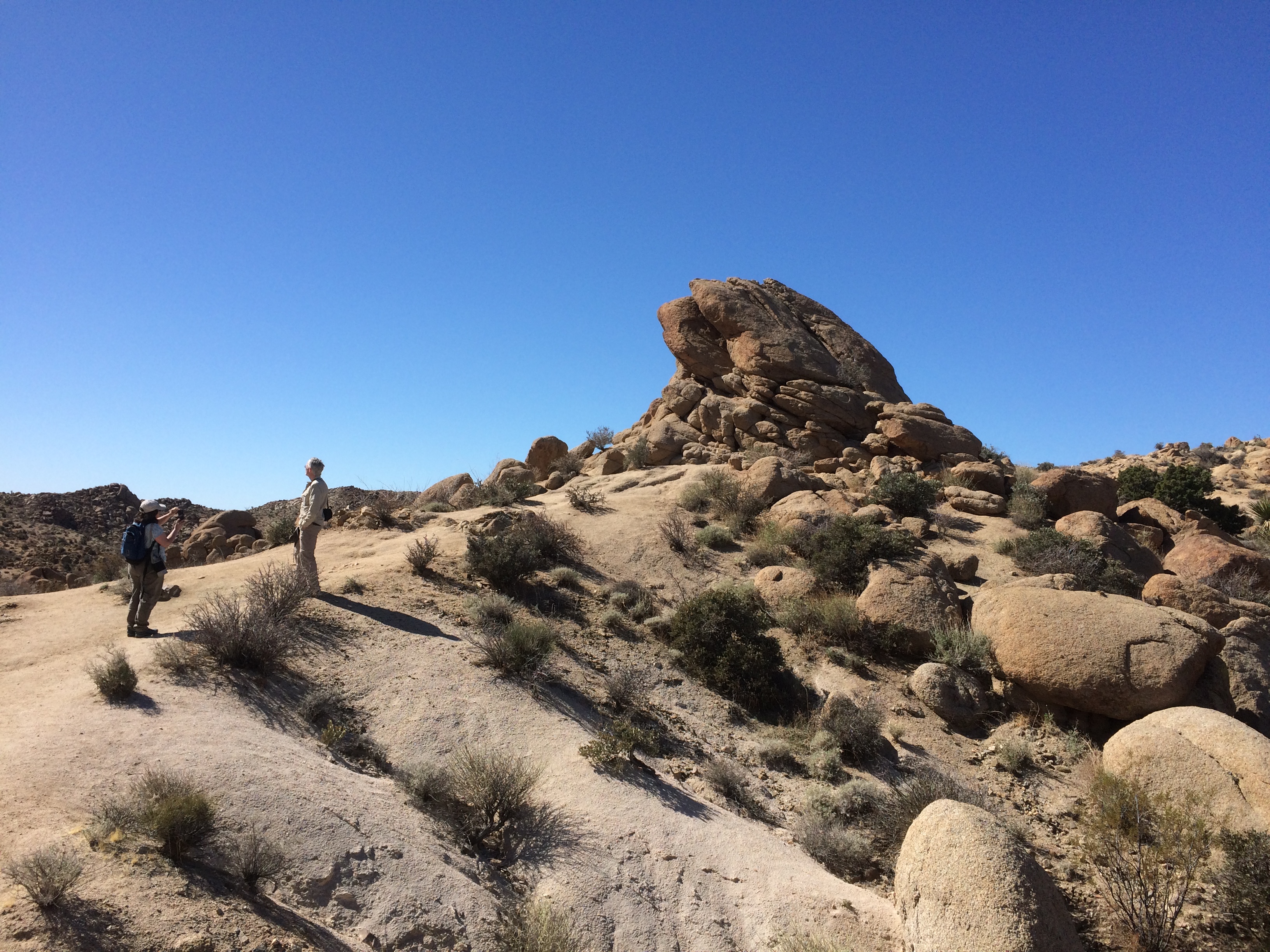 Small plants compared to others I’d see later. But I liked them.
Small plants compared to others I’d see later. But I liked them.
 North from Cottonwood Springs, the road takes you through washes: Smoke Tree Wash, Porcupine Wash and the amusingly named Fried Liver Wash. Then on to the Cholla Cactus Garden.
North from Cottonwood Springs, the road takes you through washes: Smoke Tree Wash, Porcupine Wash and the amusingly named Fried Liver Wash. Then on to the Cholla Cactus Garden.
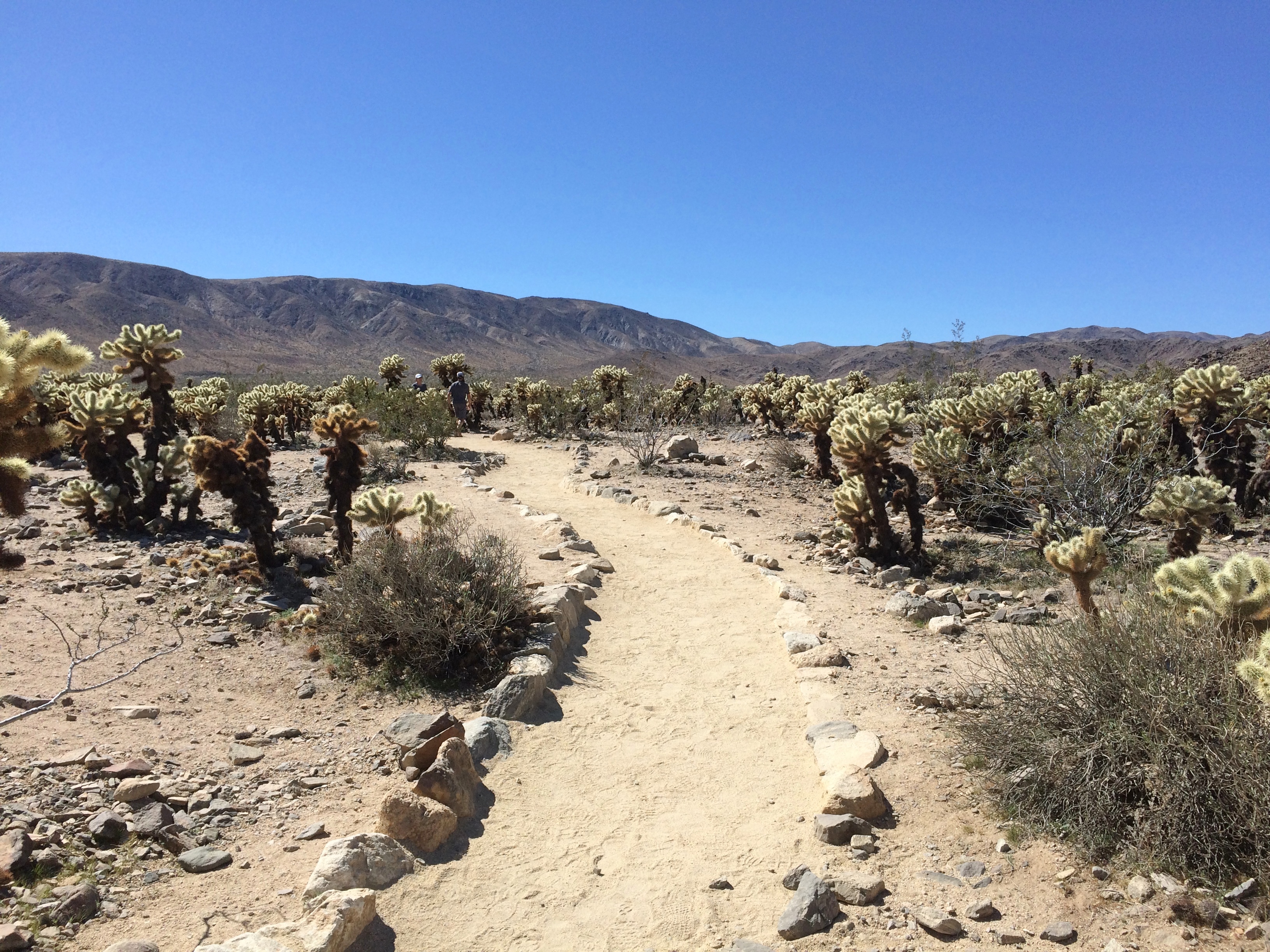
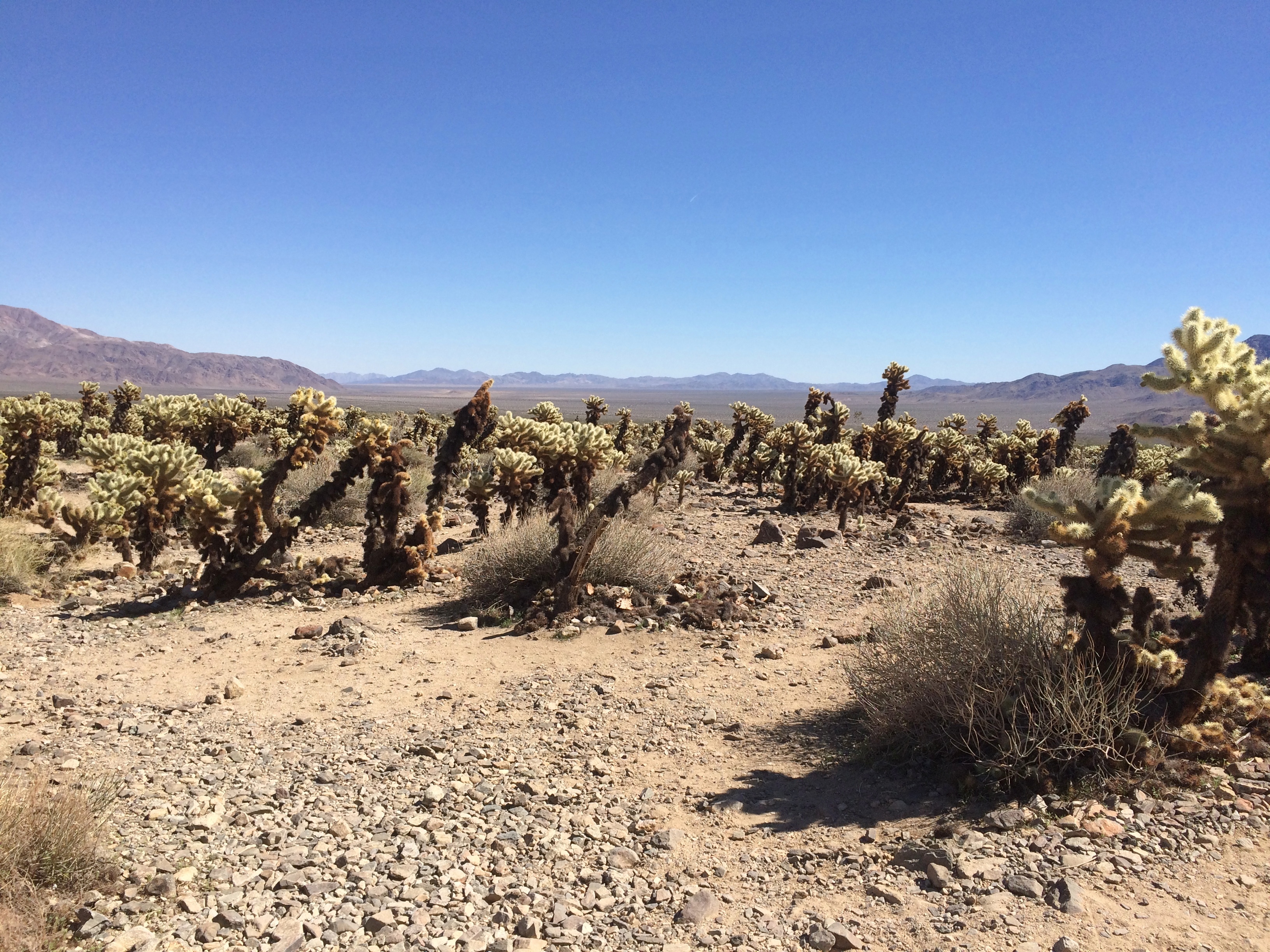 Looks soft and fuzzy in a picture, but in person the cholla’s got wicked spines. Wiki says that the plant (Cylindropuntia bigelovii) has the “sardonic nickname of ‘teddy bear.’ ”
Looks soft and fuzzy in a picture, but in person the cholla’s got wicked spines. Wiki says that the plant (Cylindropuntia bigelovii) has the “sardonic nickname of ‘teddy bear.’ ”
Next stop, Jumbo Rocks. Including the one called Skull Rock. Looking at it this way, I thought Nostril Rock would be a better name.
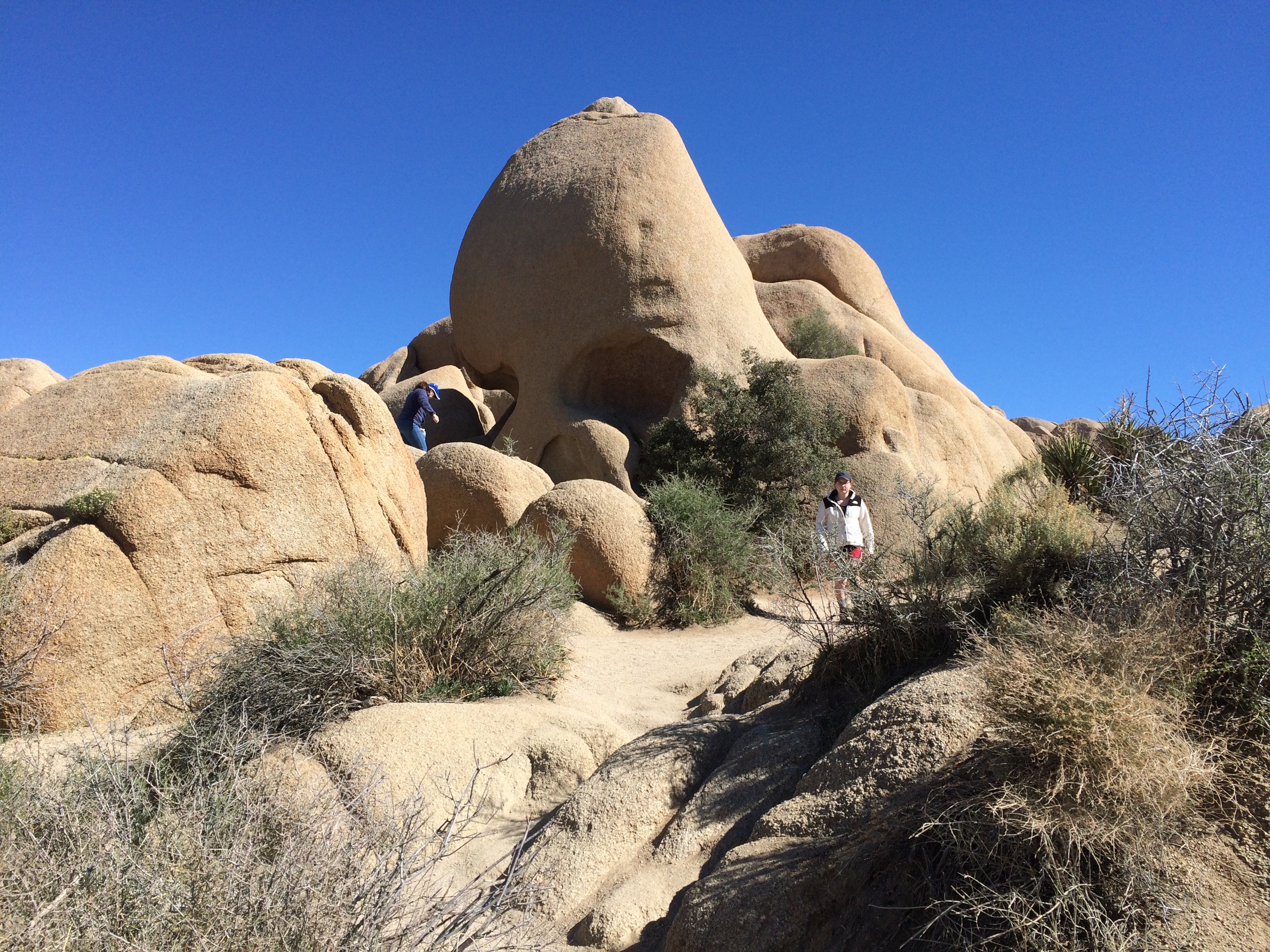 Plenty of big rocks all around. The result of magma, monzogranite, rising to the surface eons ago. That or an act of creation in 4004 BC.
Plenty of big rocks all around. The result of magma, monzogranite, rising to the surface eons ago. That or an act of creation in 4004 BC.

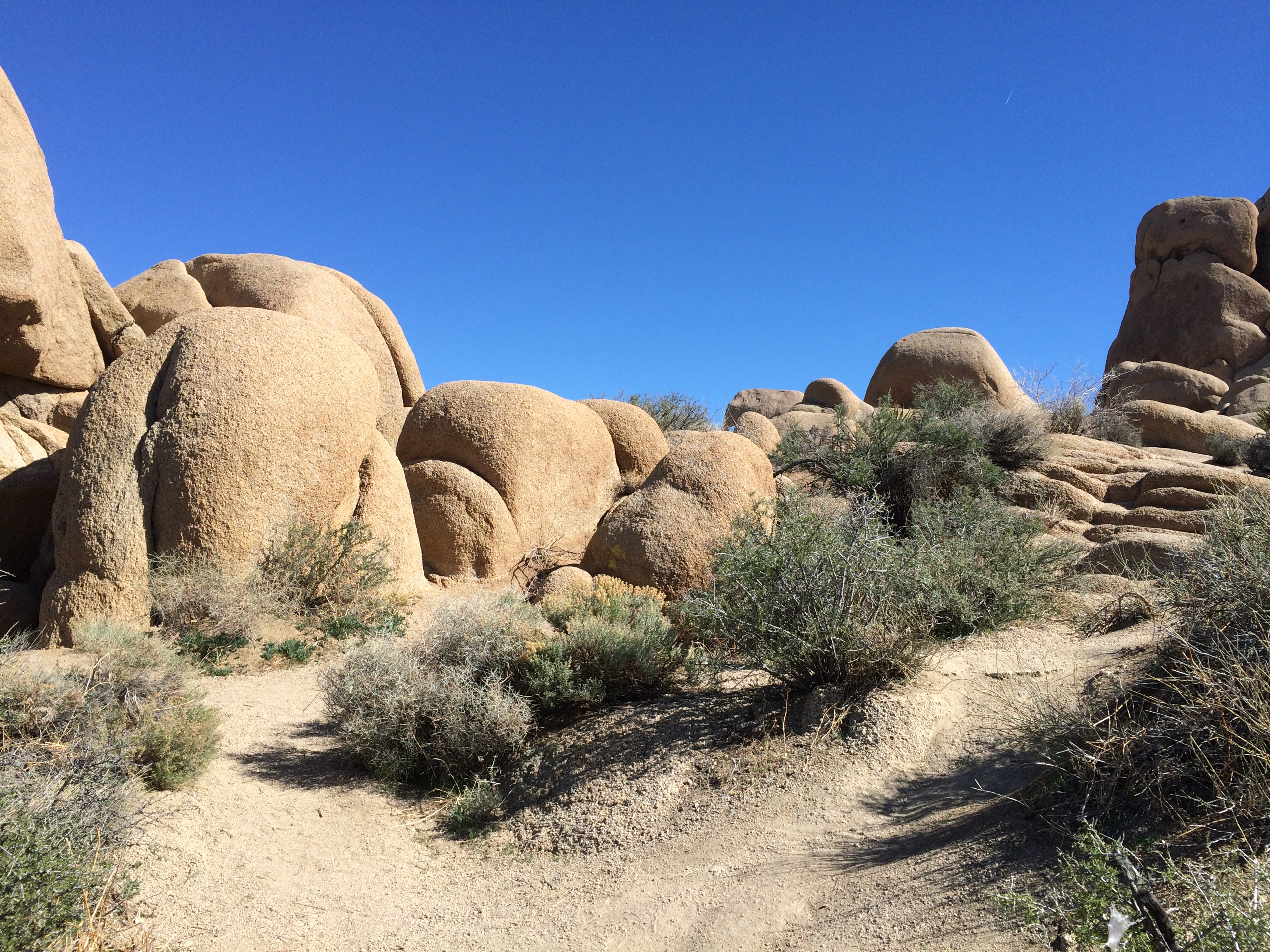
 Not far away I started spotting Joshua trees.
Not far away I started spotting Joshua trees.
 Driving on the paved roads of JTNP was pleasant enough. There was some traffic, since winter is high season, and millions visit the park every year — about 2.9 million in 2018, making it the 11th most-popular U.S. national park. Not enough traffic to be a nuisance, though.
Driving on the paved roads of JTNP was pleasant enough. There was some traffic, since winter is high season, and millions visit the park every year — about 2.9 million in 2018, making it the 11th most-popular U.S. national park. Not enough traffic to be a nuisance, though.
Unpaved roads were even better. At least the two I took: Desert Queen Mine Road and Queen Valley Road. Guess most of the other visitors were skittish about driving them, but they were mostly smooth with only a few large rocks to watch out for.
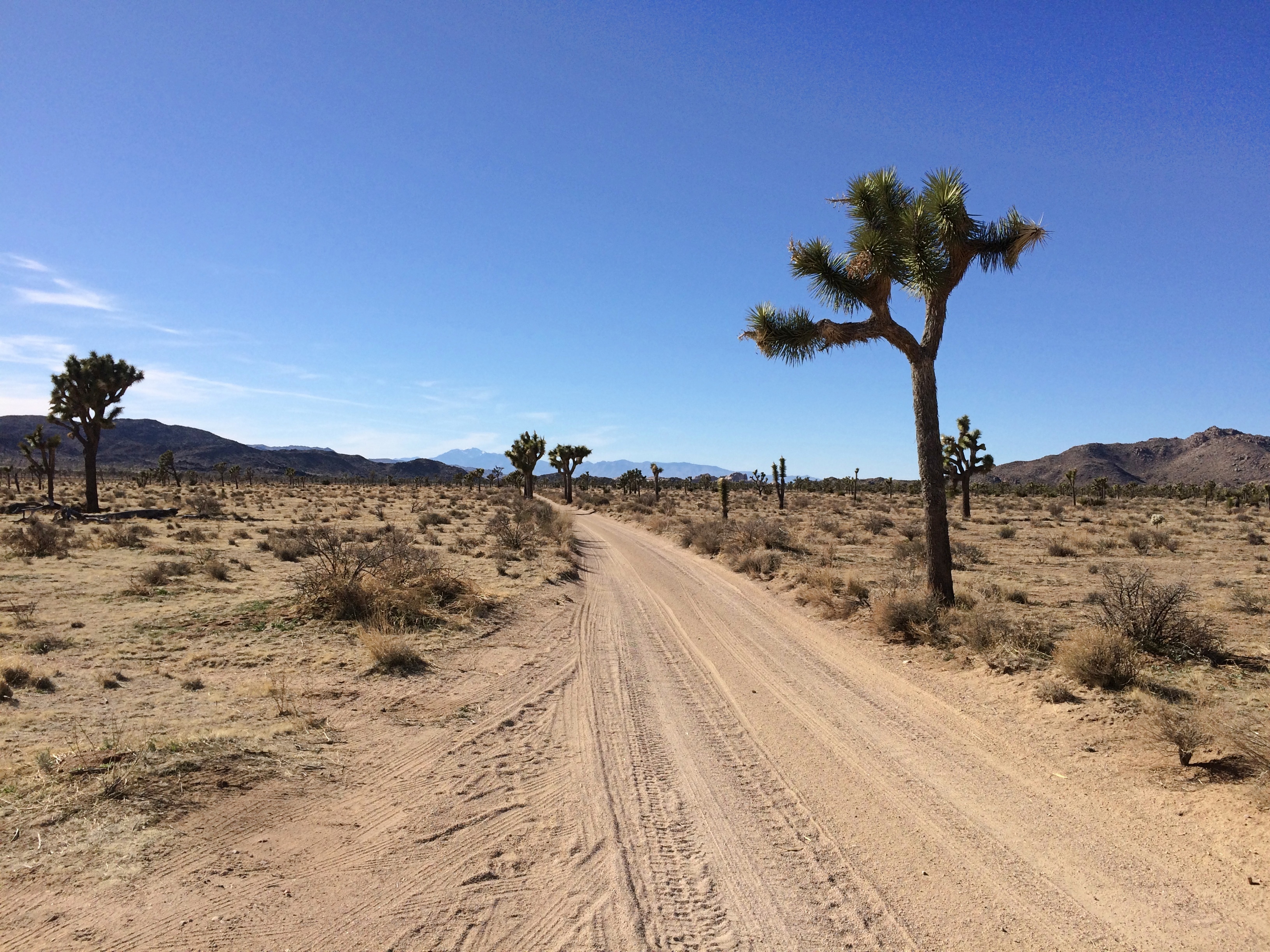 Admittedly they aren’t very long roads, but even so I only saw one other vehicle the whole way, which was pulled off the road a bit.
Admittedly they aren’t very long roads, but even so I only saw one other vehicle the whole way, which was pulled off the road a bit.
The Desert Queen Mine Road leads to a small parking area and a trail head for the Desert Queen Mine Trail. No one else was there. I took a walk. The kind of place where middle-aged men walking alone clutch their chests, keel over and aren’t found for weeks? Maybe. But you have to go down the trail if you’re going to see anything.
After about 10 minutes — it isn’t a very long trail — I came to a structure.

 Someone had lived in this waste. Why? Gold. I sat among the stones for a while. The only sound was the wind, and not much of that. Then I could hear the faint, distinct whoosh of a jet. That faded, but there was another a few minutes later.
Someone had lived in this waste. Why? Gold. I sat among the stones for a while. The only sound was the wind, and not much of that. Then I could hear the faint, distinct whoosh of a jet. That faded, but there was another a few minutes later.
A little further on is a cliff with leftover mining equipment.
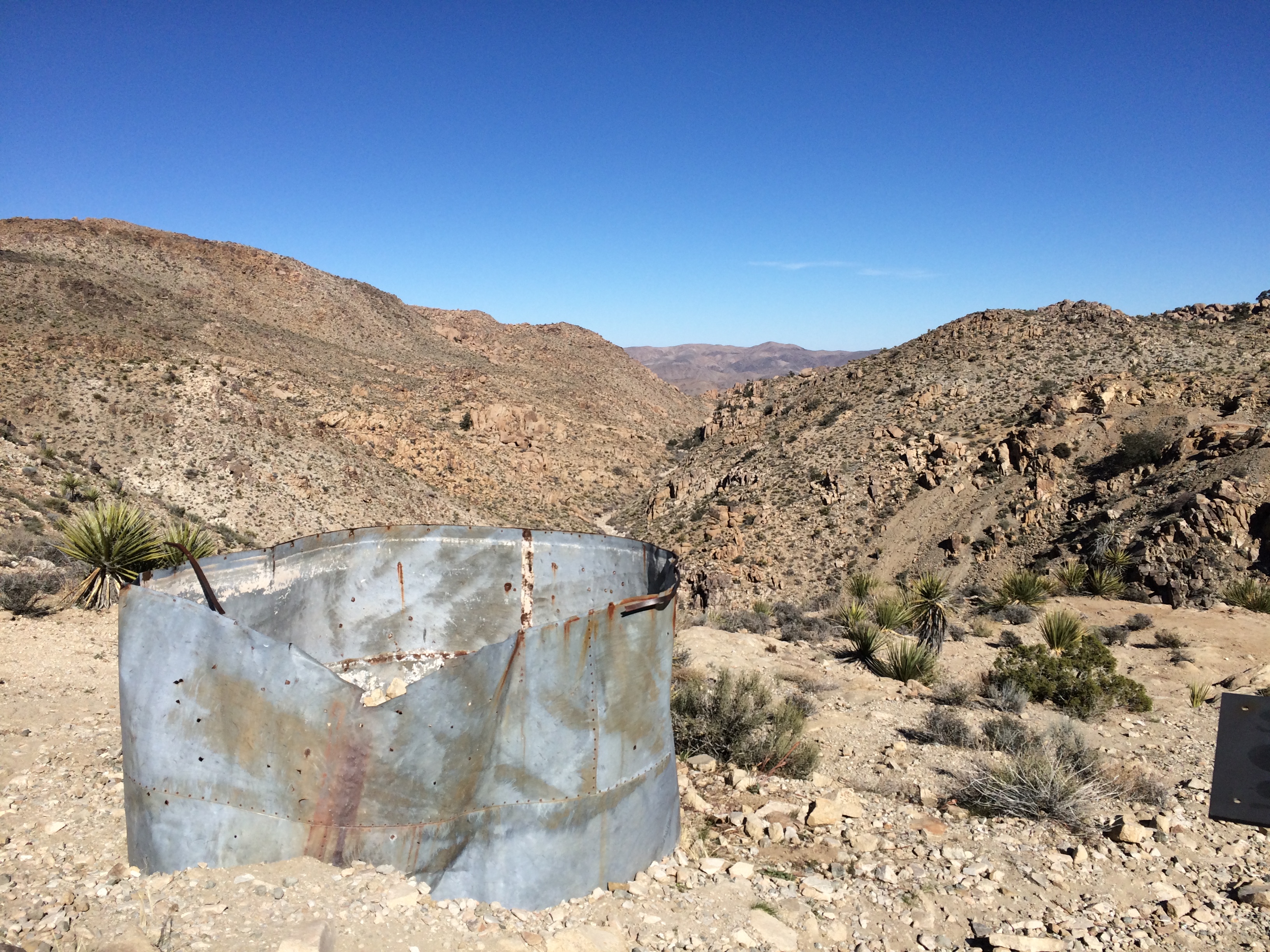 If you look carefully, you can see metal doors down in the valley. Must be closed mine shafts.
If you look carefully, you can see metal doors down in the valley. Must be closed mine shafts.
My second-to-last stop in the park: Keys View, up in the Little San Bernadino Mountains. Took a little driving to get here, but the view was worth it. Most of the Coachella Valley is stretched out before you.
At nearly 5,200 feet above sea level, it was also distinctly chilly up there. And windy. Yet I spent a while gazing.
On the road back down from Keys View, I decided to take a closer look at the Joshua tree forest I was driving through.
 To do that, you get out of the car and walk into the forest.
To do that, you get out of the car and walk into the forest.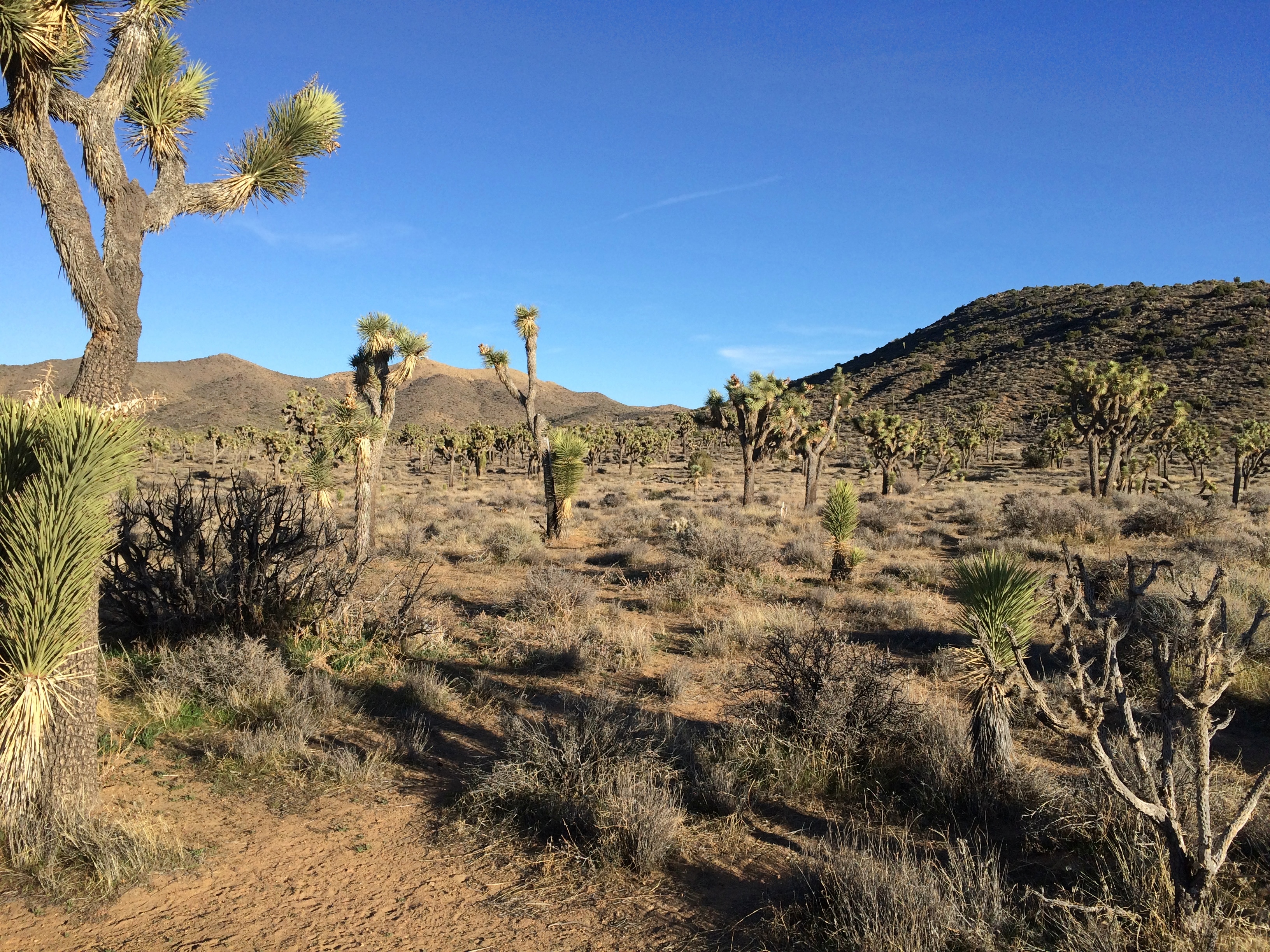
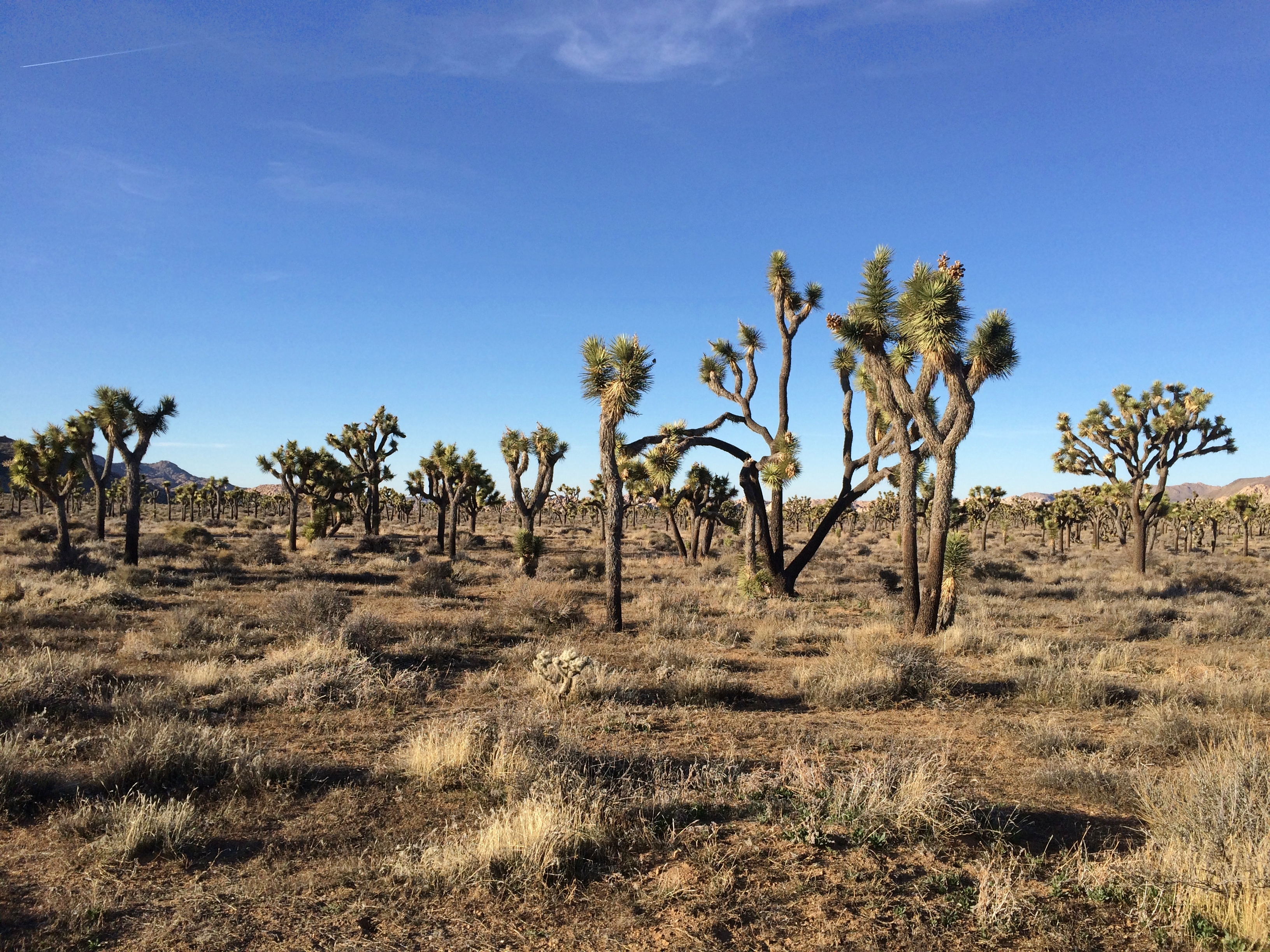
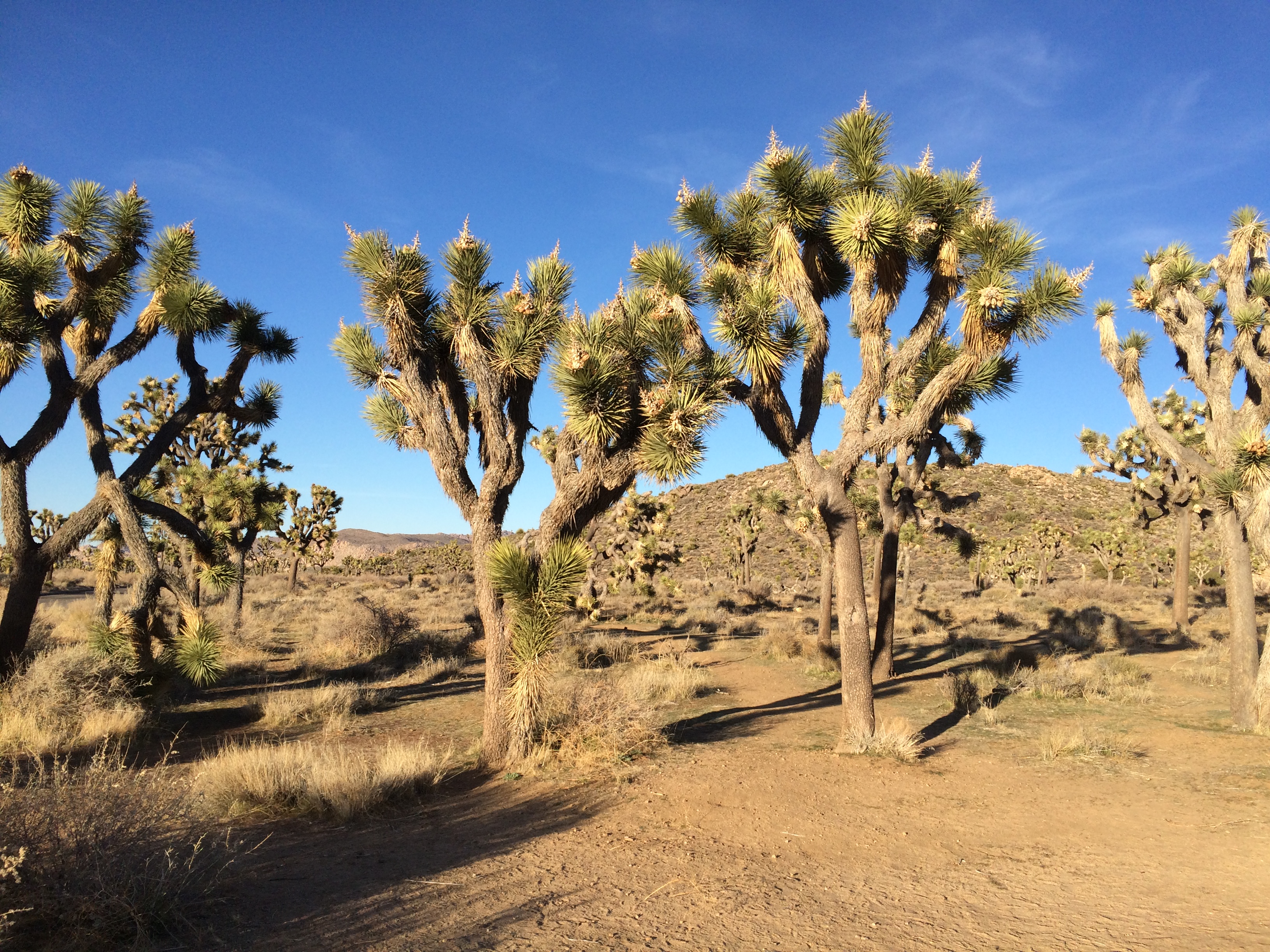
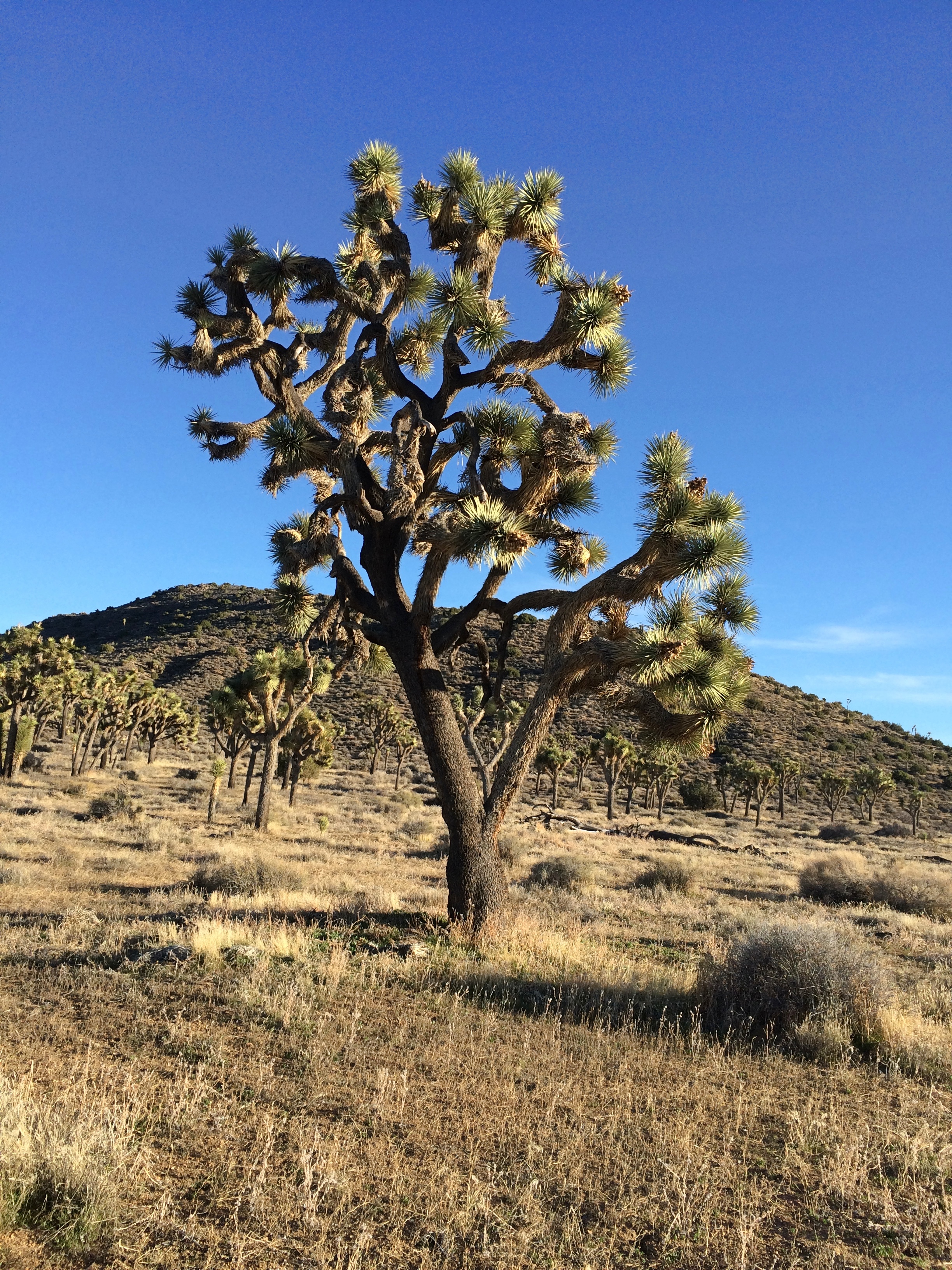
Remarkable plants, these yuccas. If Dr. Seuss had been asked to design a plant, it would look like a Joshua tree.
Easy Day in Palm Springs
My recent visit to Southern California involved a lot of motion, by car and light rail and on foot. By the time I got to Palm Springs, I was ready for an easier time. Steve and Jack’s hospitality made that possible for me from late afternoon on February 24, when I arrived, to the morning of the 26th, when I left.
If you have the means, Palm Springs is a good town for taking it easy, especially in the winter, which is like a pleasant springtime in a lot of other places. The full day I was in town involved getting up late — a necessary part of any easy day — looking around Palm Spring’s main shopping street and some of its neighborhoods, including visits to a few shops, then lunch and a drive out to the town of Indio to see its main tourist attraction.
If I’d been in full-tourist mode, I might have taken a closer look at some of the town’s modernist houses, or visited its art museum, or taken a hike in the hills, or ridden the Palm Springs Aerial Tramway. If I were another person all together, I would have played golf. I hear a lot of people do that in wintertime Palm Springs, and maybe that’s why Gerald Ford spent a lot of time there.
I took in a few sights. Such as the view across the street from Steve and Jack’s.
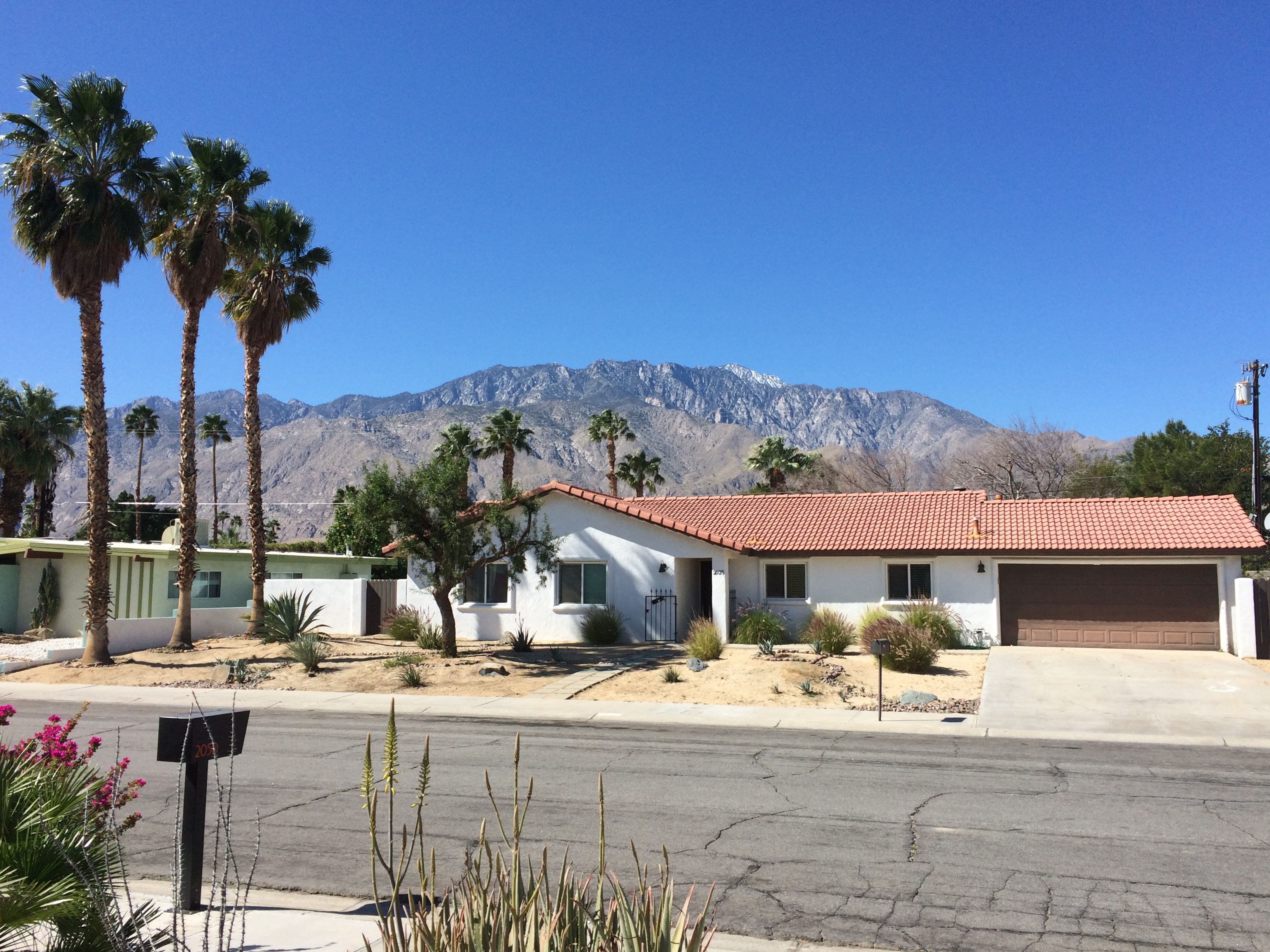 We took a stroll down Palm Canyon Dr., which includes restaurants, tony shops, tourist shops, design showcases — modernism is the thing, an aesthetic fully occupying a number of shops — and more.
We took a stroll down Palm Canyon Dr., which includes restaurants, tony shops, tourist shops, design showcases — modernism is the thing, an aesthetic fully occupying a number of shops — and more.
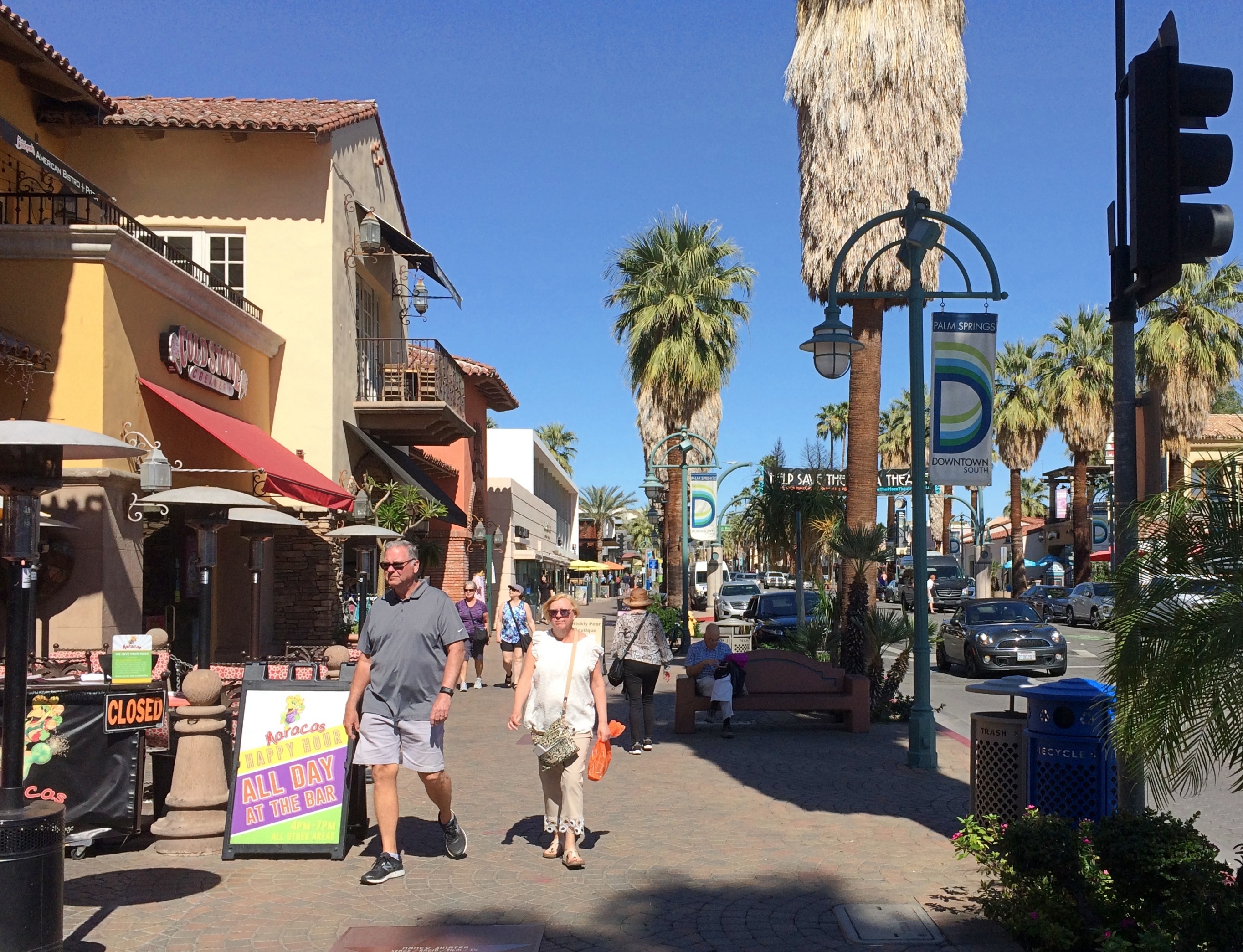 More, as in stars in the sidewalk, featuring celebrities who lived in Palm Springs at least part of the time. Such as good old Adam West.
More, as in stars in the sidewalk, featuring celebrities who lived in Palm Springs at least part of the time. Such as good old Adam West.
 Sonny Bono rates a bronze on the street, maybe for his efforts in Congress to ensure that his distant descendants retain the copyright to his songs.
Sonny Bono rates a bronze on the street, maybe for his efforts in Congress to ensure that his distant descendants retain the copyright to his songs.
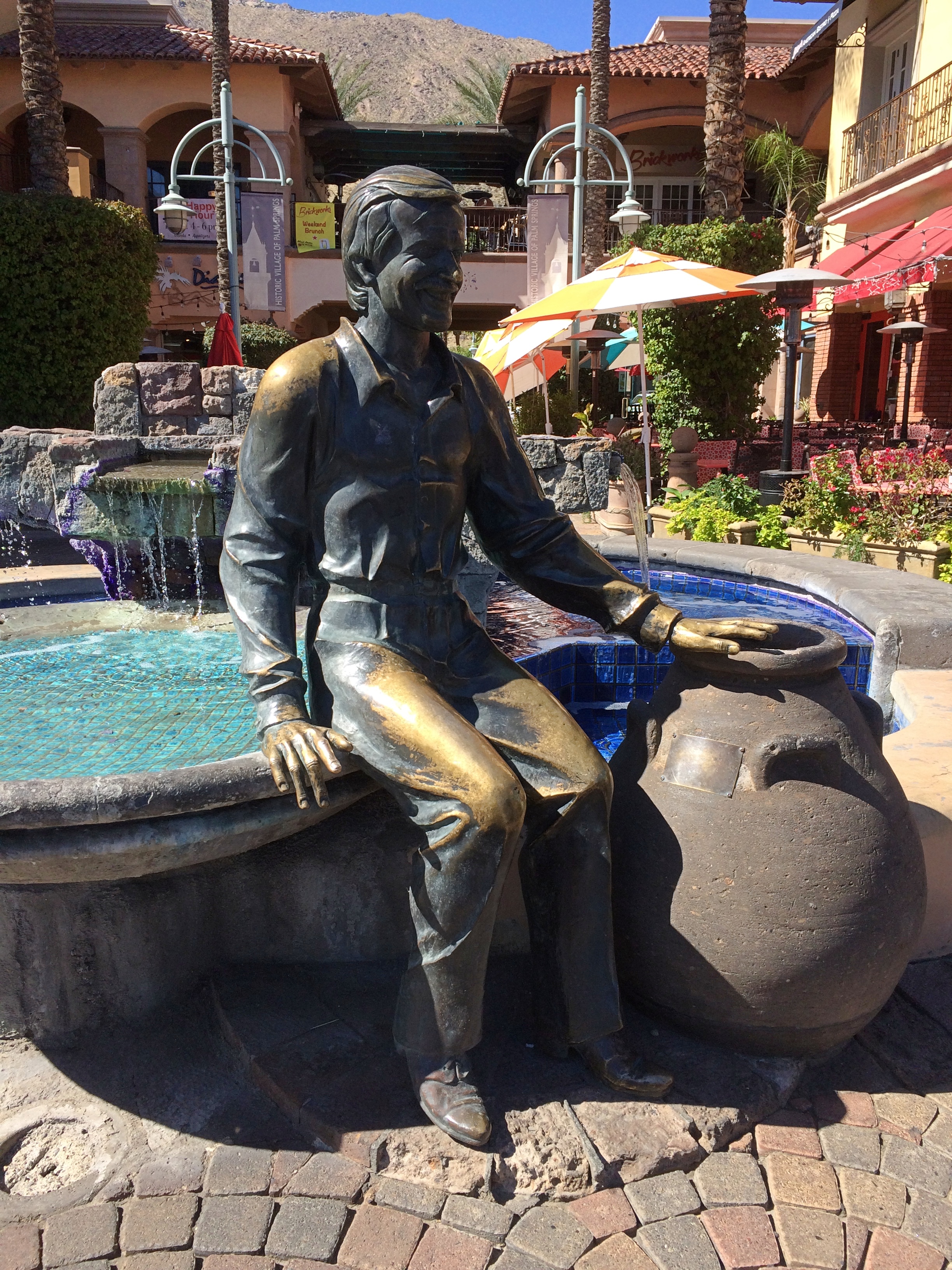 Lucy has a bronze, too. Here’s Steve with Lucy.
Lucy has a bronze, too. Here’s Steve with Lucy.
 Lunch, at Steve’s suggestion, was at the Haus of Poké just off Palm Canyon. The small chain’s web site tells us that “poké/poukei is a raw fish salad served as an appetizer in Hawaiian cuisine, and sometimes as an entree. Poké is the Hawaiian verb for ‘section’ or ‘to slice or cut.’ Typical forms are aku (an oily tuna) and he’e (octopus).”
Lunch, at Steve’s suggestion, was at the Haus of Poké just off Palm Canyon. The small chain’s web site tells us that “poké/poukei is a raw fish salad served as an appetizer in Hawaiian cuisine, and sometimes as an entree. Poké is the Hawaiian verb for ‘section’ or ‘to slice or cut.’ Typical forms are aku (an oily tuna) and he’e (octopus).”
Haus of Poké is on the Chipotle model — seems like a long time ago that that was novel — in which you pick a series of ingredients for your meal from a limited selection. Step 1, size. Step 2, base: brown rice, white rice, chips or salad. Step 3, protein: octopus, tofu, ahi tuna, salmon, yellowtail or shrimp. Step 4, mix-ins: edamame, cucumber, red onion, green onion or mango. Step 5, a selection of sauces.
I can’t remember exactly what I had now, though it involved white rice and salmon and other things, and it was delicious combo. I can see why Steve’s a regular.
Also not far off Palm Canyon: The Church of St. Paul in the Desert, Episcopal. Unfortunately closed.
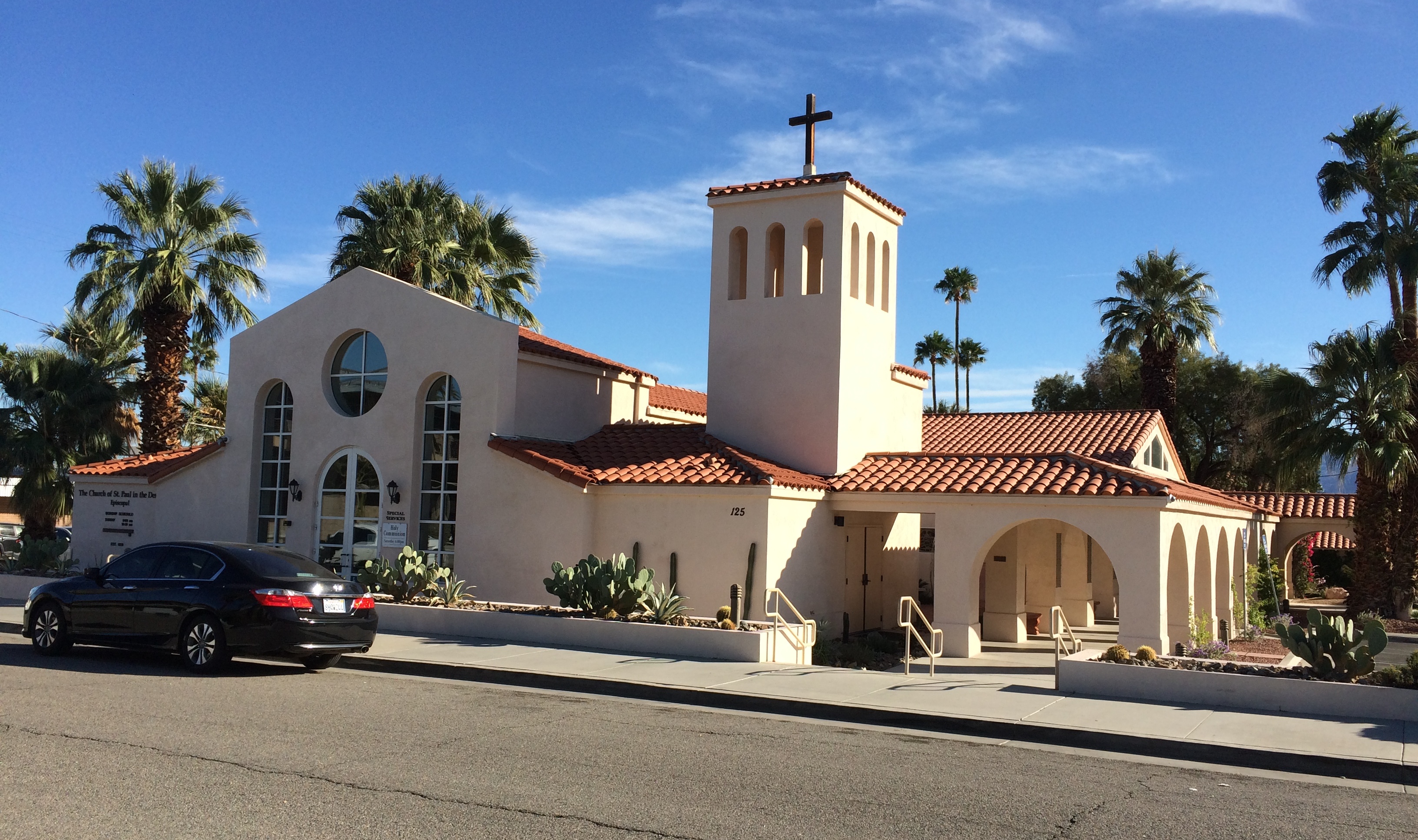 That afternoon, we went to Shields, a date farm that’s also a tourist attraction in Indio, California. The sign has been a fixture of the road since the 1950s.
That afternoon, we went to Shields, a date farm that’s also a tourist attraction in Indio, California. The sign has been a fixture of the road since the 1950s.
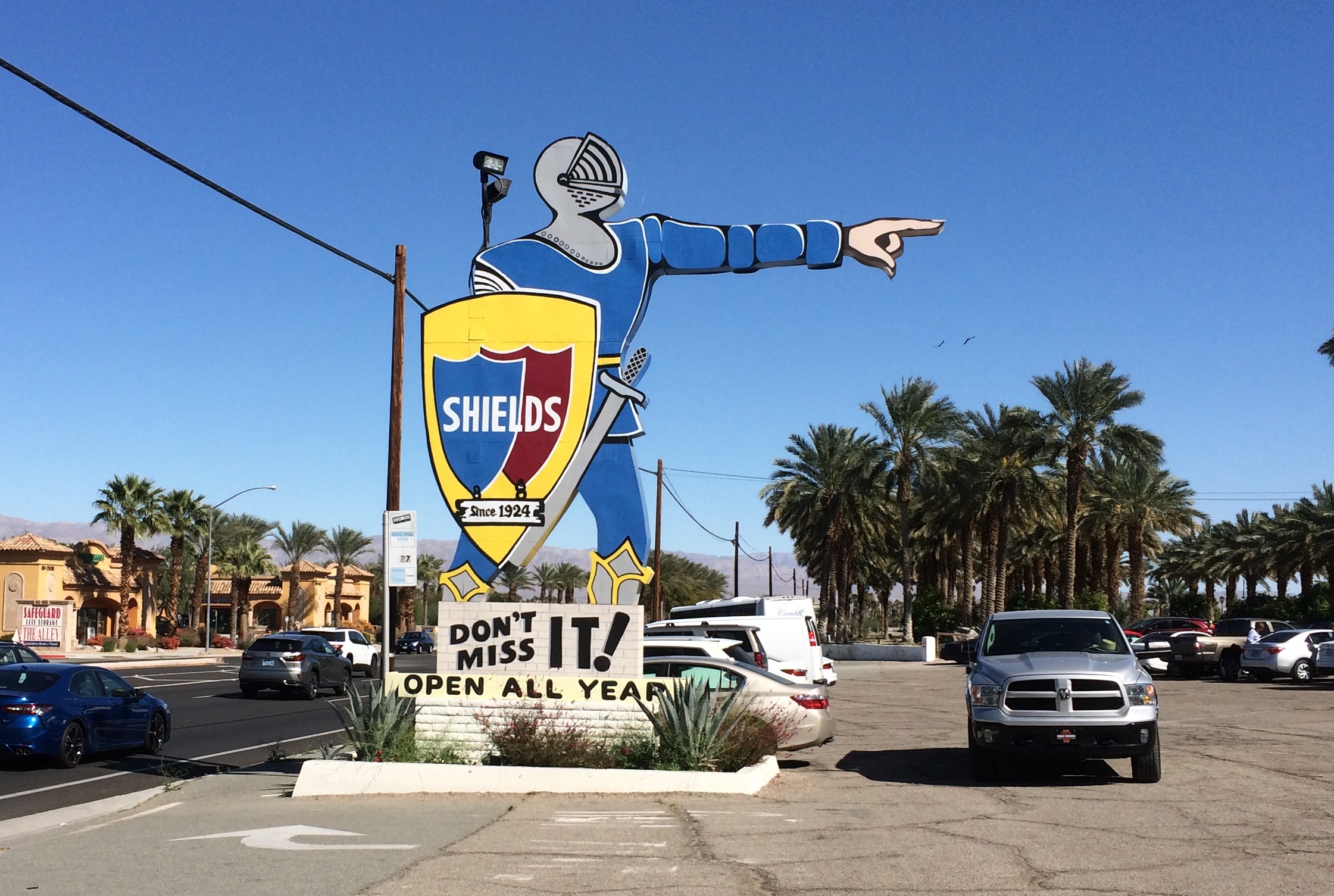 We stayed for a short film — Romance & Sex Life of the Date — which was something like a film you (I) might have seen in elementary school, and at times a little hard to stay awake for. But I can’t say I didn’t learn anything about date agriculture. I didn’t know, for instance, that about 90% of U.S. date cultivation is in the Coachella Valley (Wiki says more than 95%, but I’m citing the movie.)
We stayed for a short film — Romance & Sex Life of the Date — which was something like a film you (I) might have seen in elementary school, and at times a little hard to stay awake for. But I can’t say I didn’t learn anything about date agriculture. I didn’t know, for instance, that about 90% of U.S. date cultivation is in the Coachella Valley (Wiki says more than 95%, but I’m citing the movie.)
Steve said that Shields used to offer a selection of date samples on a table, as many as you cared to eat, but we didn’t see that. Turns out you have to ask for a sample now, which includes two dates. Is a new private equity owner clamping down on the freebies?
We bought two date shakes, which were good, and looked around a bit. You can’t wander around the date-growing grounds any more, either, Steve said. Used to be able to. The best view of the Shields date trees turned out to be from the edge of the parking lot.
 After Shields, we returned to Steve’s house to loaf around (now there’s a verb we shouldn’t let die). I wasn’t completely idle, however, since I spent time writing postcards. In the evening, we had a pleasant dinner and then sat around and talked and watched TV. The Food Network, I have to say, is a whole other world I knew little about.
After Shields, we returned to Steve’s house to loaf around (now there’s a verb we shouldn’t let die). I wasn’t completely idle, however, since I spent time writing postcards. In the evening, we had a pleasant dinner and then sat around and talked and watched TV. The Food Network, I have to say, is a whole other world I knew little about.
The Getty Villa
I’m connected on Facebook with a man named Rolf Achilles. I took a noncredit class he taught on Chicago history at the Newberry Library in the late 1980s. I think he also attended the Harvest Dinner Party at my apartment on October 22, 1988, but I’m not sure — a lot of people were there. Not sure I’ve seen him since then, or whether he’d remember me if he saw me.
Rolf’s an art historian, and often publishes images of fine art on Facebook. Not long ago, he posted pictures of items on display at the Getty Villa in Pacific Palisades, California. I also happened to be planning my trip to California at the time. Almost at once I knew I wanted to see the place, along with the Getty Center. Thanks, Rolf.
When the time came, on the afternoon of February 23, I only had time for one of them. I decided on the Getty Villa. Of course I did. It offers a collection of ancient art.
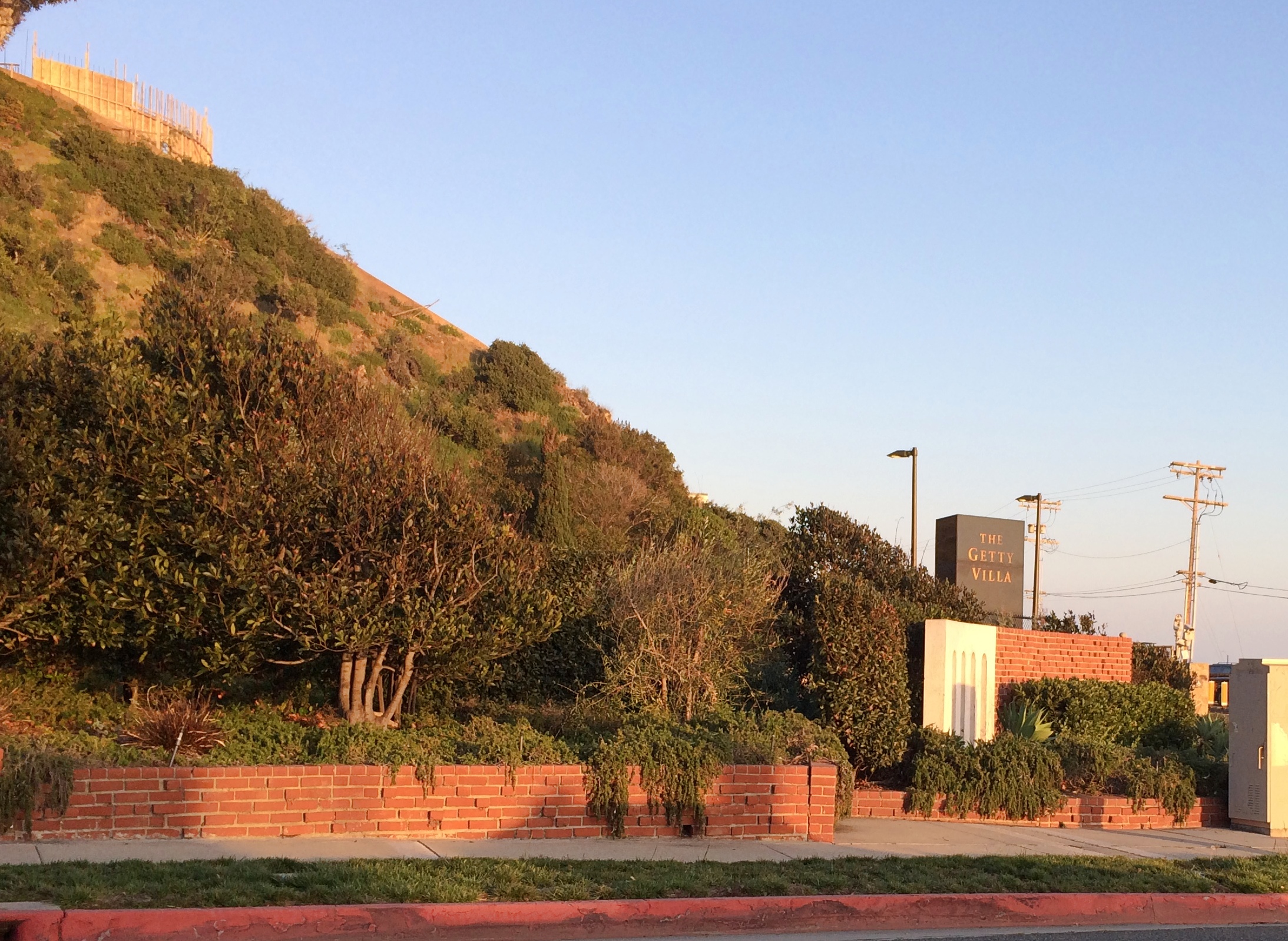 Oil billionaire and notorious tightwad J. Paul Getty had the property developed in the 1970s to house his large collection of ancient Greek, Roman and Etruscan art. Tight-fisted Getty might have been in many things, but not when it came to the sumptuous villa. The structure, on the hills overlooking the Pacific, is a re-creation of a specific villa in Herculaneum, the Villa of the Papyri, which wasn’t just any Roman country villa, but among the poshest known.
Oil billionaire and notorious tightwad J. Paul Getty had the property developed in the 1970s to house his large collection of ancient Greek, Roman and Etruscan art. Tight-fisted Getty might have been in many things, but not when it came to the sumptuous villa. The structure, on the hills overlooking the Pacific, is a re-creation of a specific villa in Herculaneum, the Villa of the Papyri, which wasn’t just any Roman country villa, but among the poshest known.
Apparently the old man died before the villa was completed, or at least he never went to see it. Too bad for him. The villa was opened to the public as a museum for a short time, but soon closed and wasn’t re-opened until 2006, after some additions to the grounds.
Langdon Wilson Architects did the original design. “Architects looked closely at the partial excavation of the Villa dei Papiri and at other ancient Roman houses in Pompeii, Herculaneum, and Stabiae to influence the design,” the Getty web site says. “The scale, appearance, and some of the materials of the Getty Villa are taken from the Villa dei Papiri, as is the floor plan, though it is a mirror of the original.”
In 2006, Machado Silvetti renovated the villa and added a nearby complex of buildings, such as a cafe, museum store and auditorium. These buildings set the pattern for your approach to the Getty Villa. After parking at some distance, you walk to a bank of elevators or flight of stairs that take you to a elevated path to the villa. Then you have to go back down (part of the way) to enter the villa — via a 500-seat outdoor amphitheater, which was also part of the addition.
In this shot, the amphitheater is to the left, the entrance to the right.
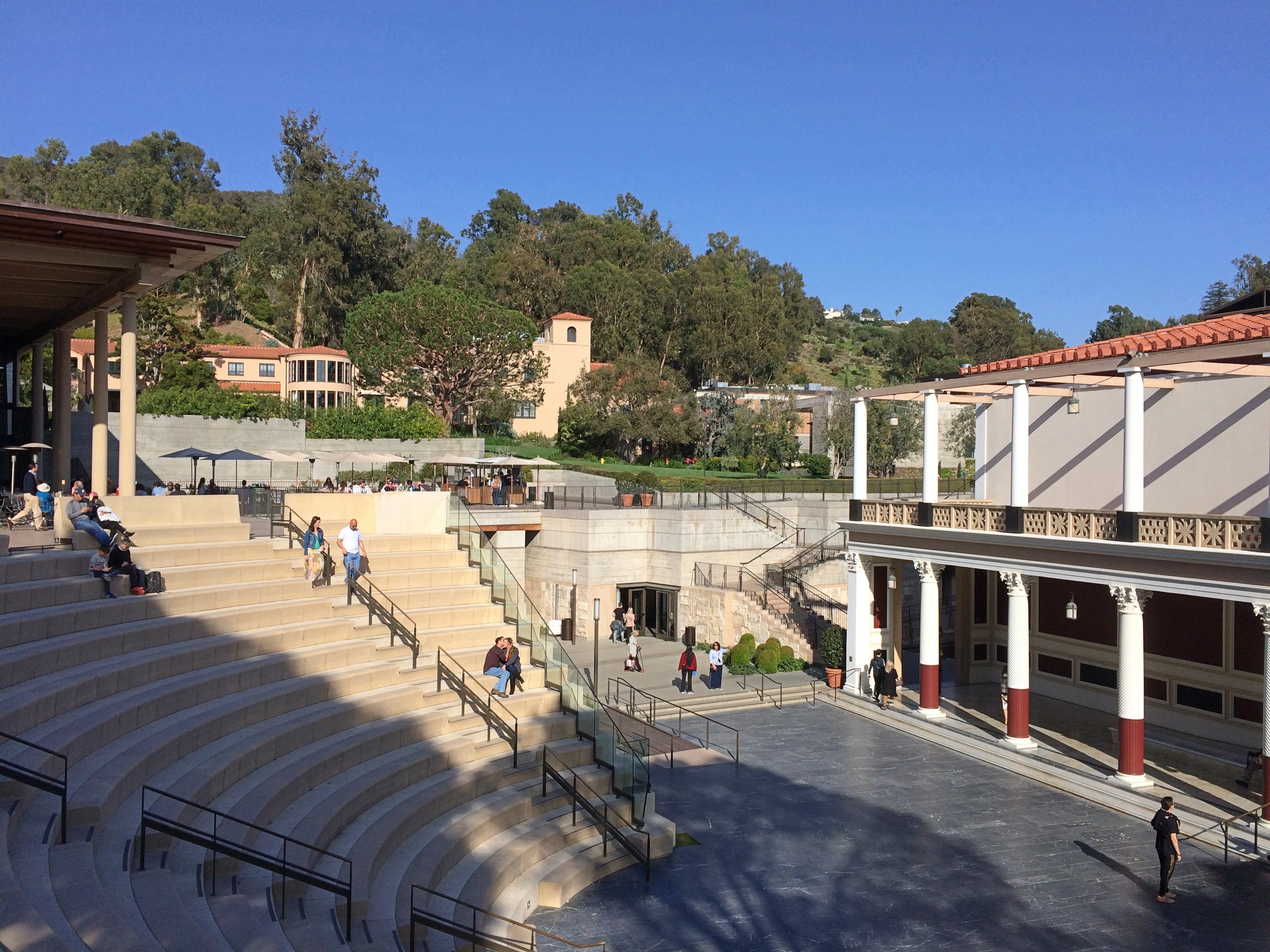 The entrance. I decided to go in and look at the building and grounds first, and then the works of art on display.
The entrance. I decided to go in and look at the building and grounds first, and then the works of art on display.
 The entrance leads to the Atrium, a splendid introduction to the structure that has rooms off each side, exhibiting art. Then the structure opens up into an open-air Inner Peristyle.
The entrance leads to the Atrium, a splendid introduction to the structure that has rooms off each side, exhibiting art. Then the structure opens up into an open-air Inner Peristyle.
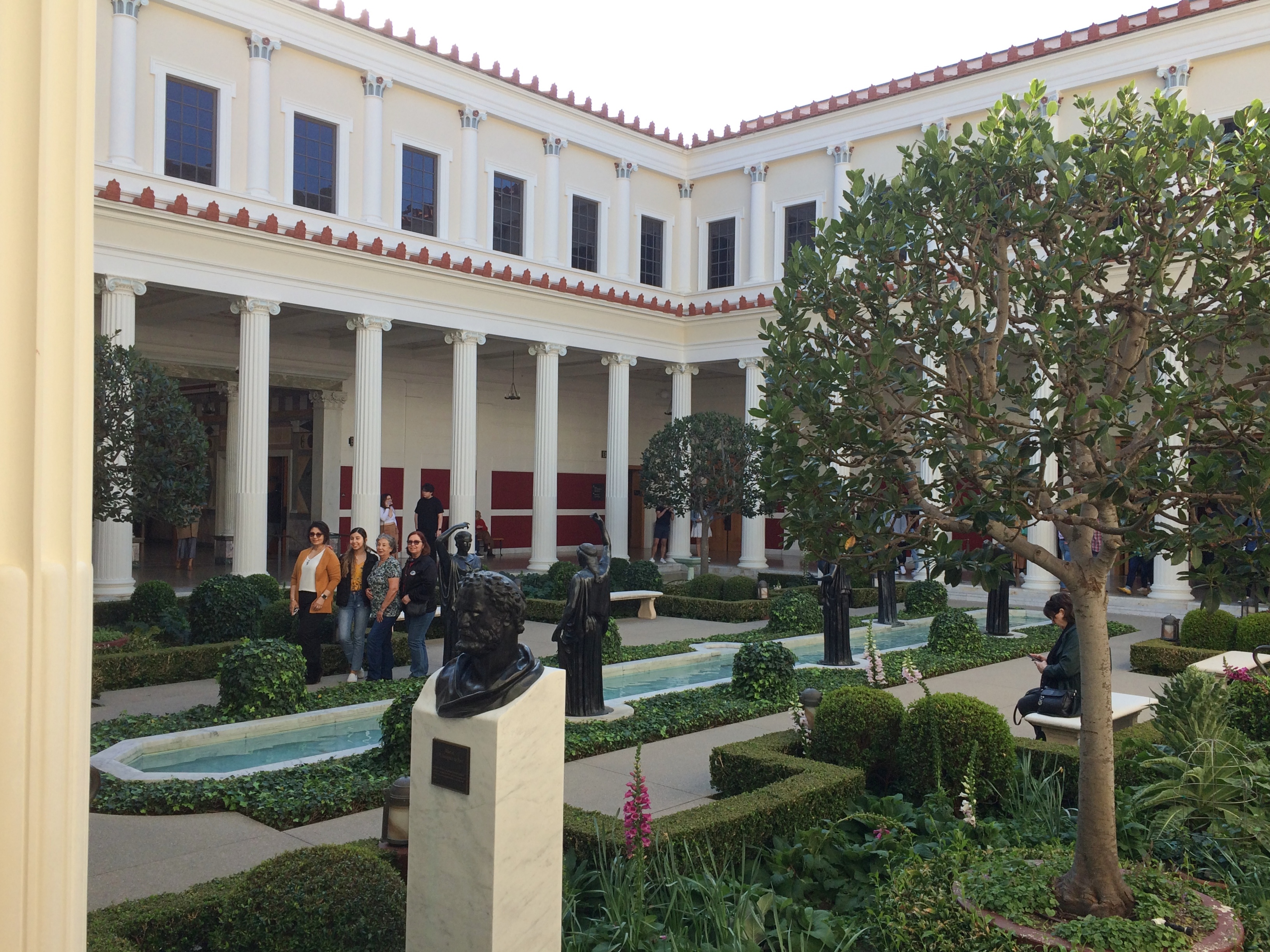
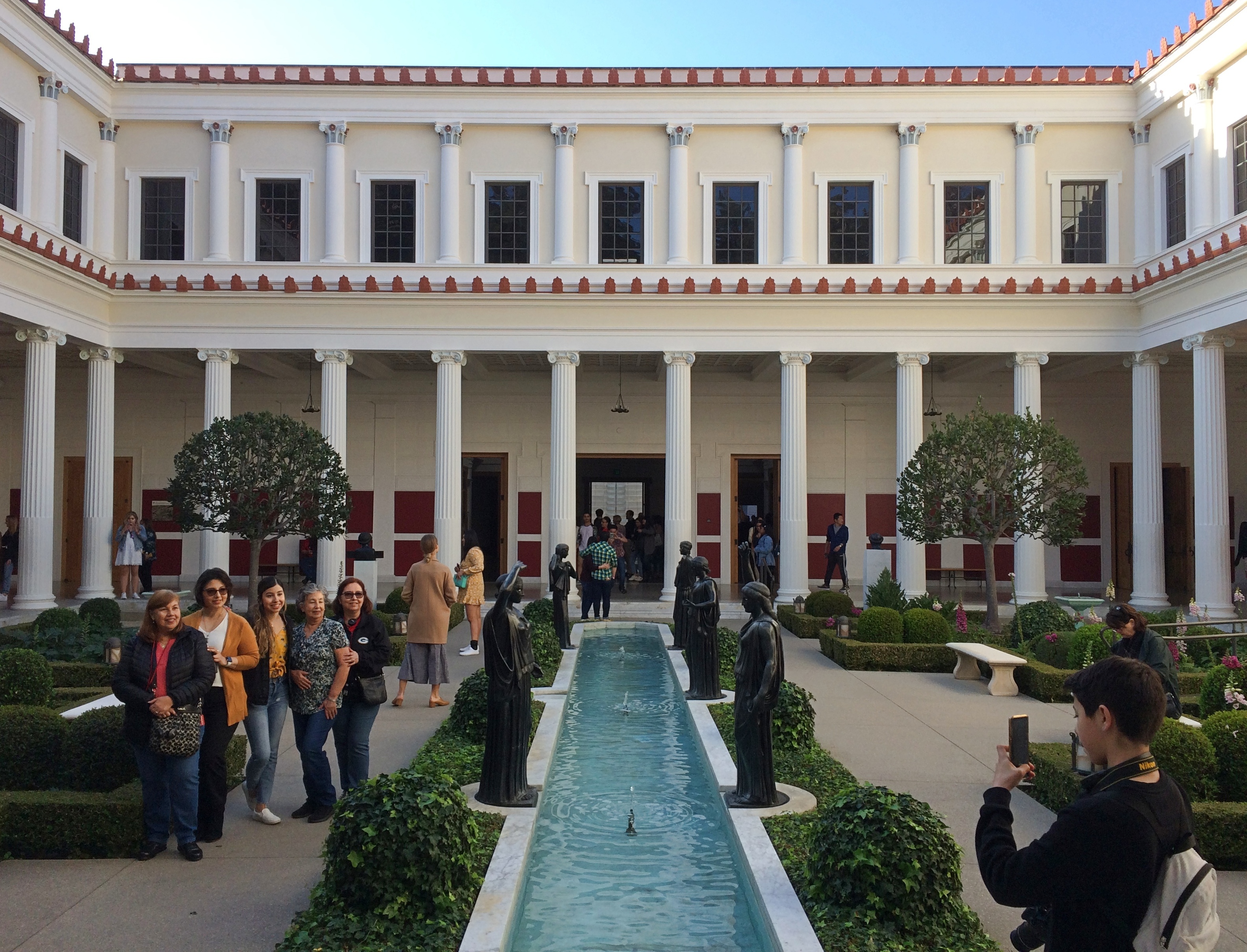 “This type of space was common in the second century B.C., when the main structure of the ancient villa was built,” signage in the peristyle says. “The Getty Villa’s garden is lushly planted with a variety of annuals and perennials bordered with hedges. The colonnade is paved the terrazzo, a mosaic flooring… A long, narrow pool emphasizes the east-west axis of the Getty Villa. Statues of young women, reproductions of ancient bronze sculptures found at the Villa dei Papiri, are set around the pool.”
“This type of space was common in the second century B.C., when the main structure of the ancient villa was built,” signage in the peristyle says. “The Getty Villa’s garden is lushly planted with a variety of annuals and perennials bordered with hedges. The colonnade is paved the terrazzo, a mosaic flooring… A long, narrow pool emphasizes the east-west axis of the Getty Villa. Statues of young women, reproductions of ancient bronze sculptures found at the Villa dei Papiri, are set around the pool.”
Exit the Inner Peristyle and you’re on a small balcony overlooking to Outer Peristyle. I stood there for a while, just gawking. It’s a gawk-worthy place.
 The top level of awe at the property, as far as I was concerned. The Atrium had been bronze and the Inner Peristyle had been silver. Now I was at the gold level.
The top level of awe at the property, as far as I was concerned. The Atrium had been bronze and the Inner Peristyle had been silver. Now I was at the gold level.
Walk out into the Outer Peristyle and all the way to the far end, and you get a view of the Inner Peristyle that you came from.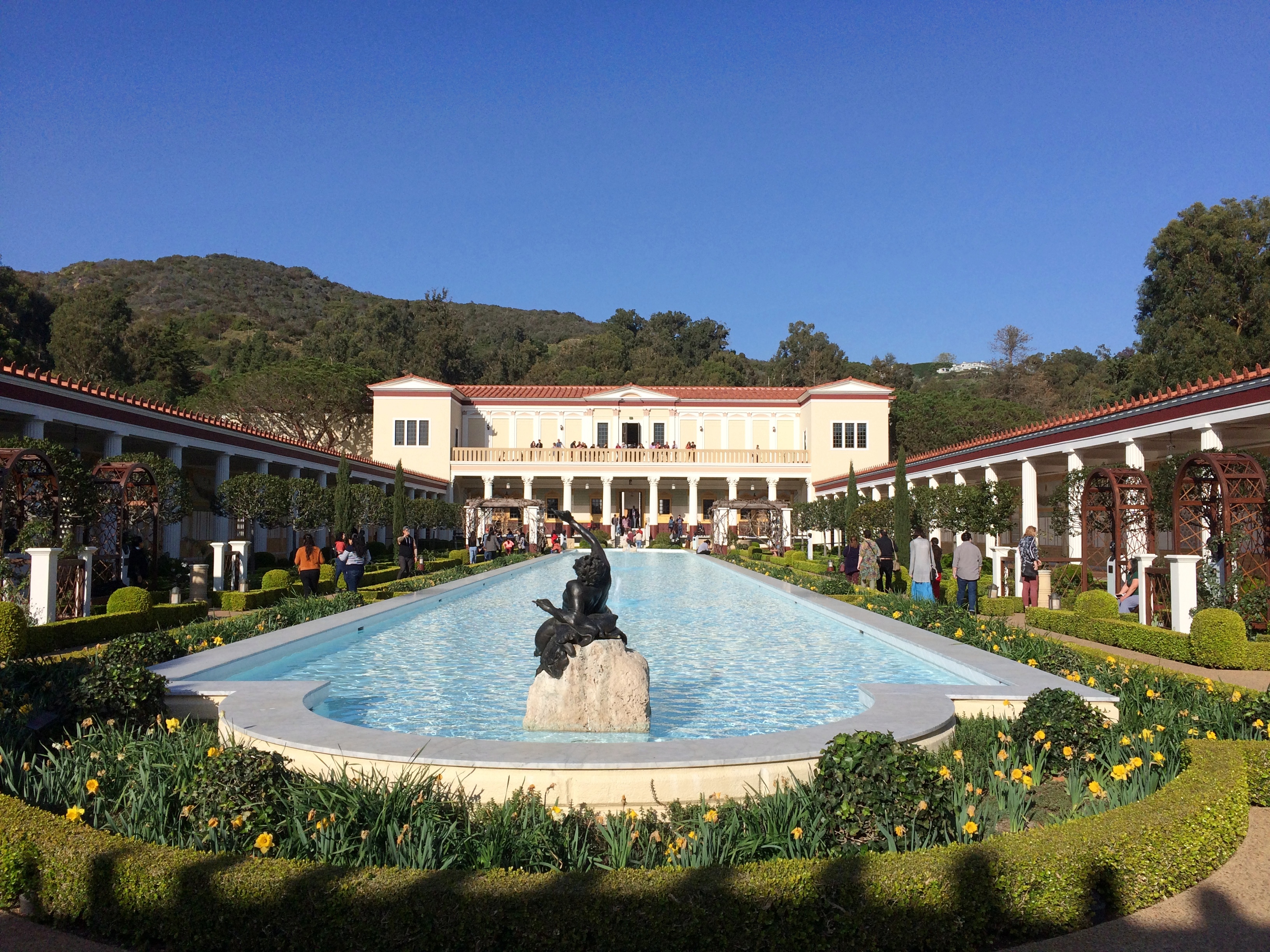
 I quote at length a press release from the time the Getty Villa reopened in the mid-2000s that’s remarkably informative: “Designed by Denis L. Kurutz Associates, and implemented by kornrandolph, inc., the Getty Villa landscape takes into account the lush topography of the Malibu canyon.
I quote at length a press release from the time the Getty Villa reopened in the mid-2000s that’s remarkably informative: “Designed by Denis L. Kurutz Associates, and implemented by kornrandolph, inc., the Getty Villa landscape takes into account the lush topography of the Malibu canyon.
“In addition to the historically accurate species found in the four gardens and in areas closest to the J. Paul Getty Museum building, the landscape design also features a mix of Mediterranean and native California varieties, local plants of the Santa Monica mountains, and plants from other parts of the world that grow in climates similar to that of Southern California.
“[The Outer Peristyle] is the Villa’s main garden, the largest and grandest of the four. Bronze sculpture and replicas of statues discovered at the remains of the first-century Villa dei Papiri have been placed in their ancient findspots…
“Just like its smaller neighbor, the Outer Peristyle is dominated by a large pool running down the center. Trimmed ivy topiaries frame the edges of the pool, which is crowned at its north end with two sculptural pomegranate trees and enclosed by 24 Grecian laurels on either side, mirroring the structural columns of the building.
“Four benches are available — two located in arbors draped in grape vines, and two nestled in pockets surrounded by hand-crafted wood trellises. Clusters of rose gardens are filled with ancient gallica, damask, and musk roses, while much of the ground is covered with a layer of sweet violet. Flowering perennials such as chamomile, daisy, rosemary, and sage are planted in abundance for variety and color, along with tulips, iris, Madonna lily, cyclamen, and narcissus.”
I understand that the Getty Villa isn’t an exact replica of the original in Herculaneum. For one thing, the Villa dei Papiri hasn’t been fully excavated. Also, buildings in our time need to be up to modern fire codes and so on. Still, as a re-creation of ancient Rome, this is likely to be the best I’ll ever see.
It’s also an excellent setting for the art collection. I’ve read that the once upon a time, Getty had some issues with stolen artwork. Or at least disputed provenance. Back around the time the villa re-opened, a number of objects were sent back to Italy and Greece. Hope that’s all behind the museum. What remains is amazing enough.
Might as well start with the museum’s star piece of art. Its Mona Lisa, you might say: the Lansdowne Hercules, Roman, ca. AD 125. (As the museum styles it — not CE.)
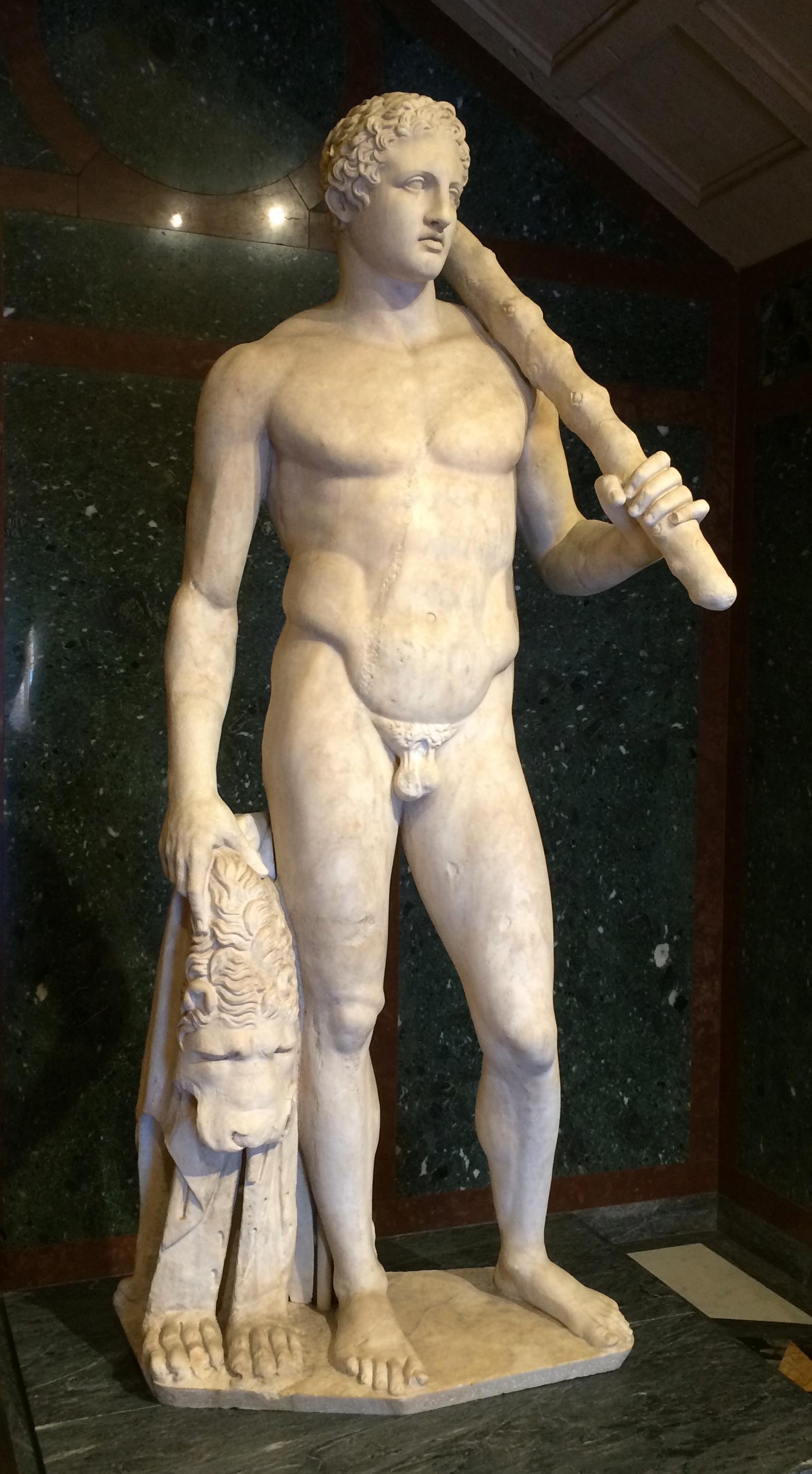 Found near Hadrian’s villa at Tivoli, so maybe the emperor himself saw it. In our time, the statue has its own room in the Getty Villa.
Found near Hadrian’s villa at Tivoli, so maybe the emperor himself saw it. In our time, the statue has its own room in the Getty Villa.
Other Roman statues include Leda and the Swan, AD 1st century.
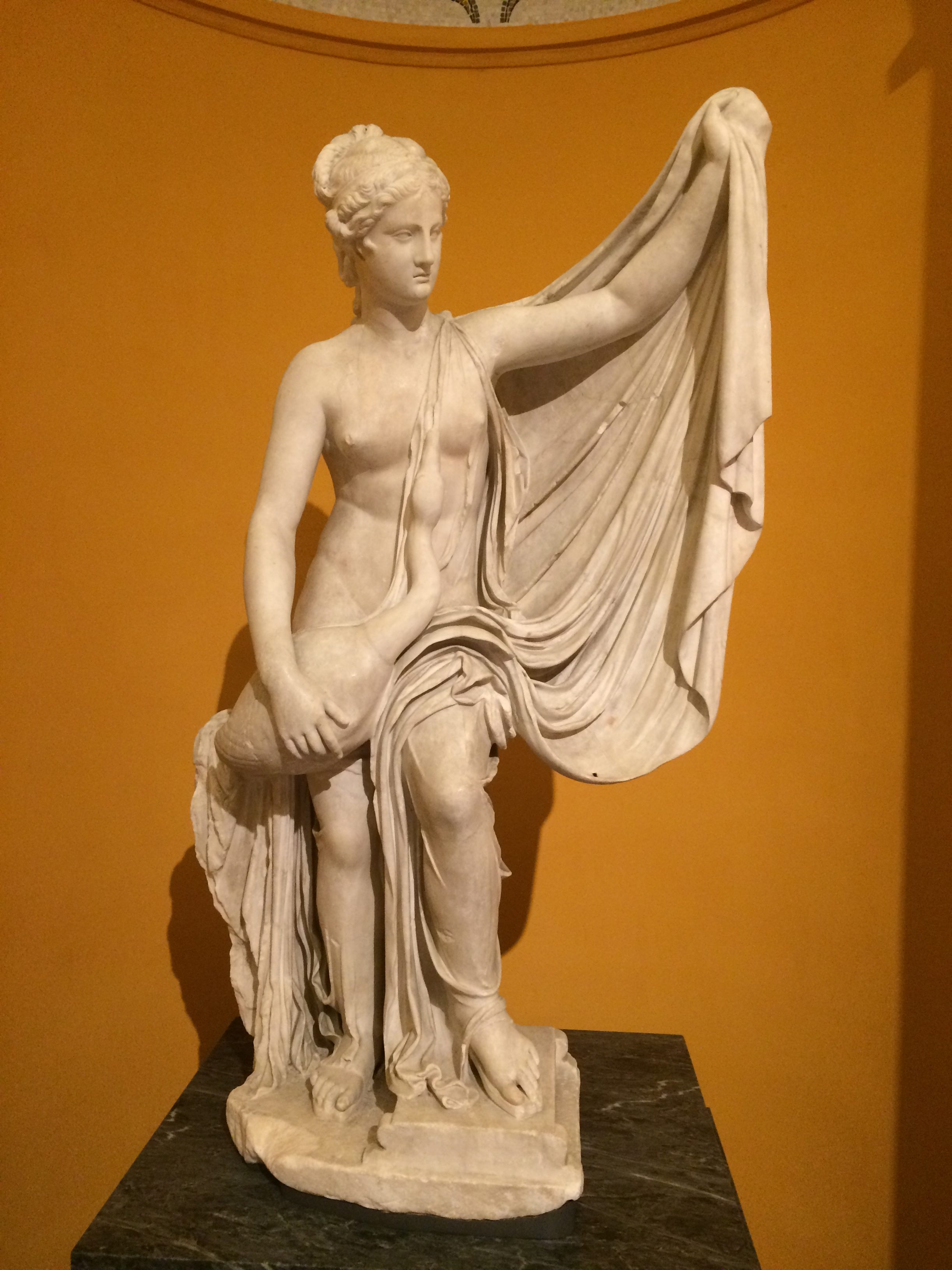 Venus, Roman, AD 2nd century.
Venus, Roman, AD 2nd century.

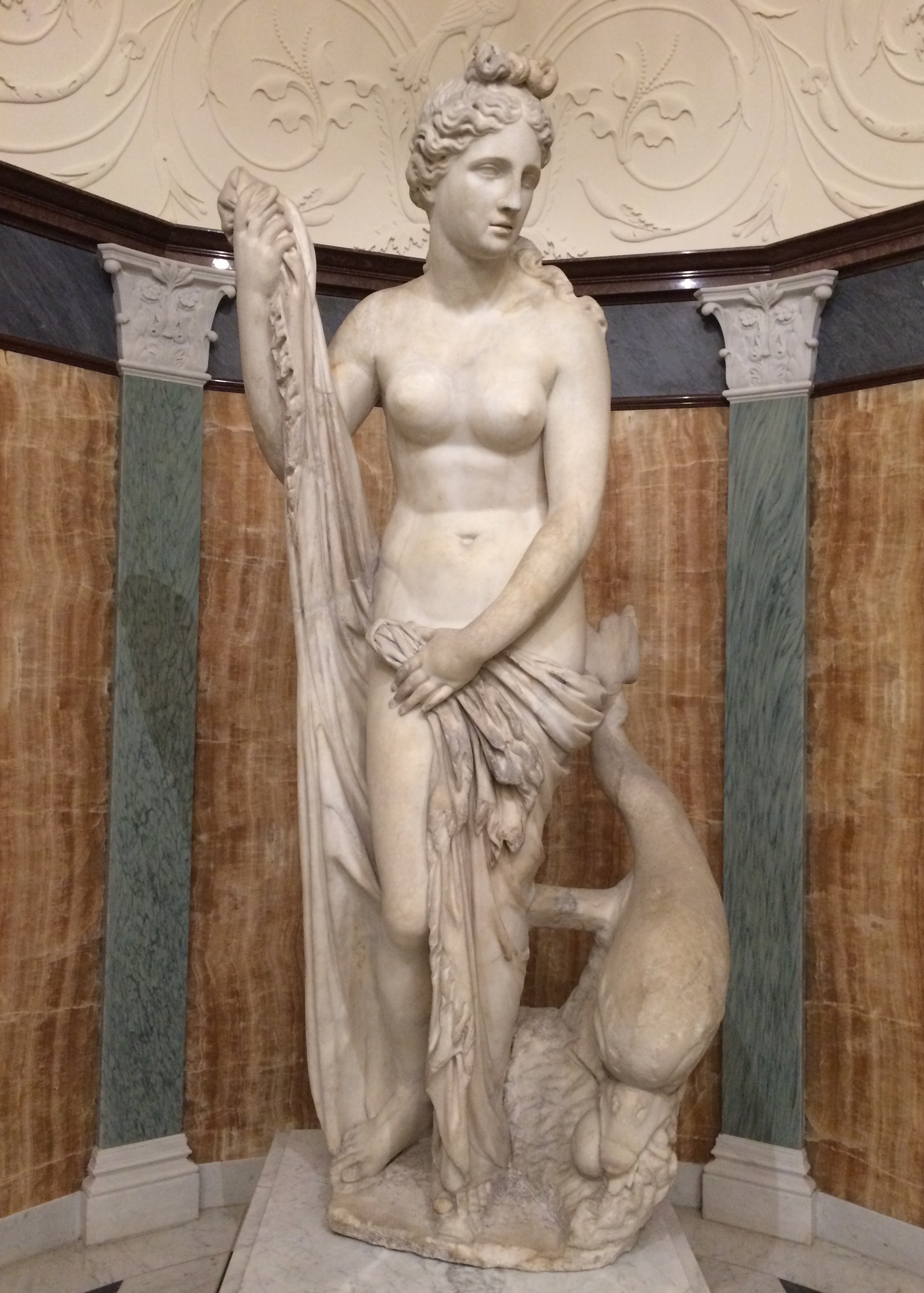 Crouching Venus, Roman, AD 100-150
Crouching Venus, Roman, AD 100-150
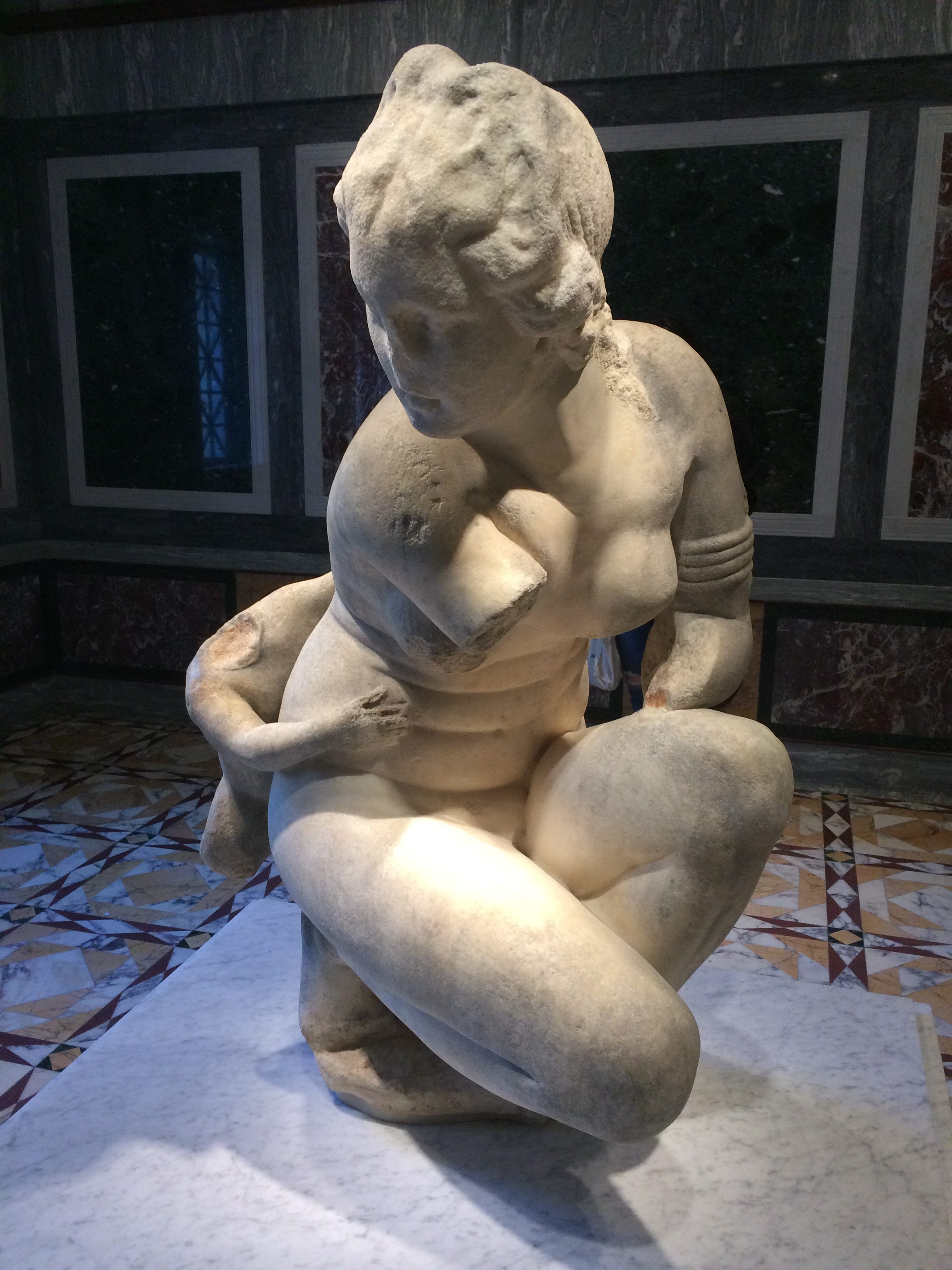 Jupiter, Roman, 1st century BC
Jupiter, Roman, 1st century BC
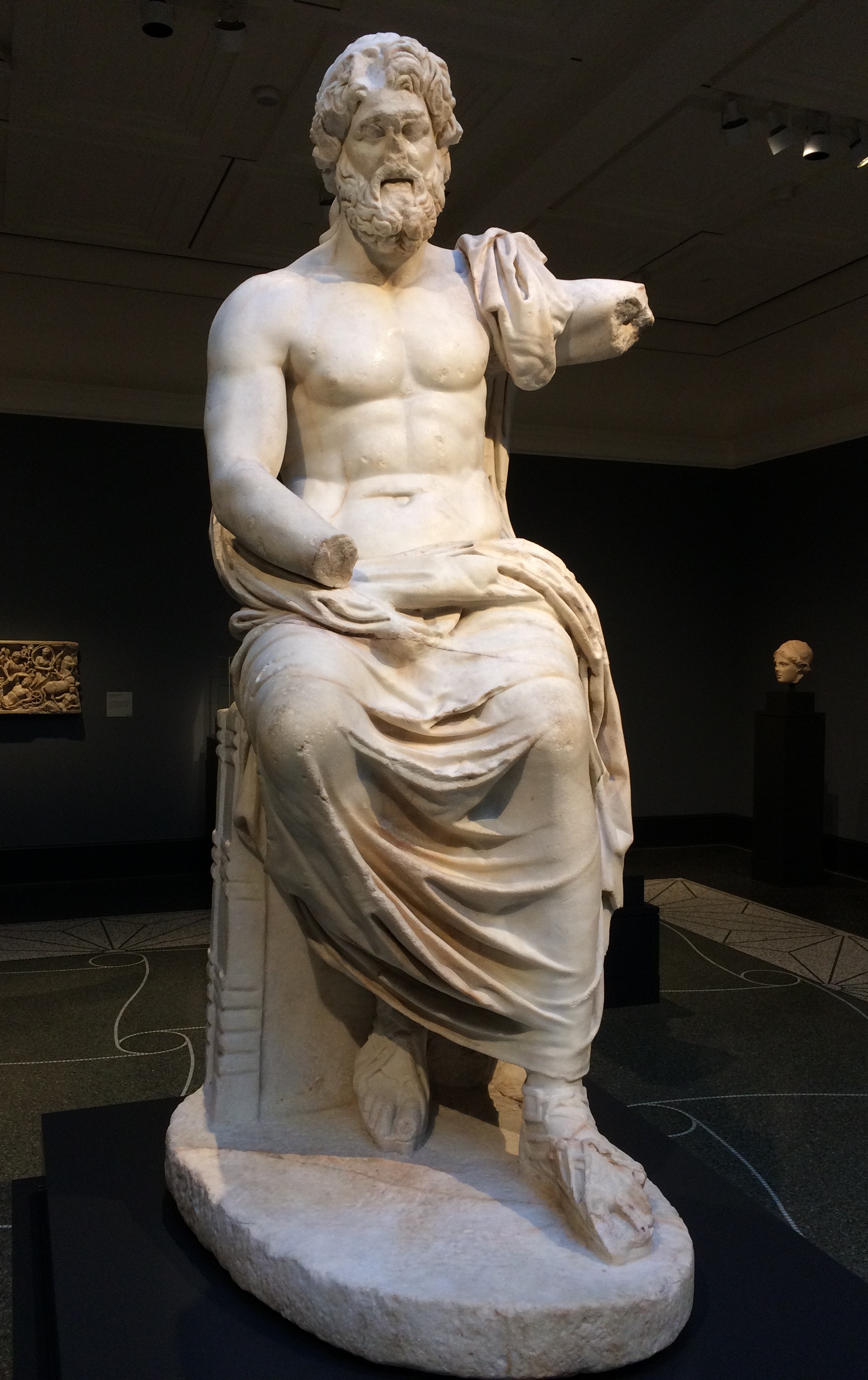 Plus busts. A number of emperors. Such as Augustus.
Plus busts. A number of emperors. Such as Augustus.
 Tiberius.
Tiberius.
 Caligula.
Caligula.
 All very good, but I’ll never shake the feeling that those emperors looked like Brian Blessed, George Baker and John Hurt, respectively.
All very good, but I’ll never shake the feeling that those emperors looked like Brian Blessed, George Baker and John Hurt, respectively.
The Greek galleries excelled in pottery. All the pictured objects are Athenian, 6th or 5th century BC. Such as Storage Jar with Diomedes Slaying Rhesos.
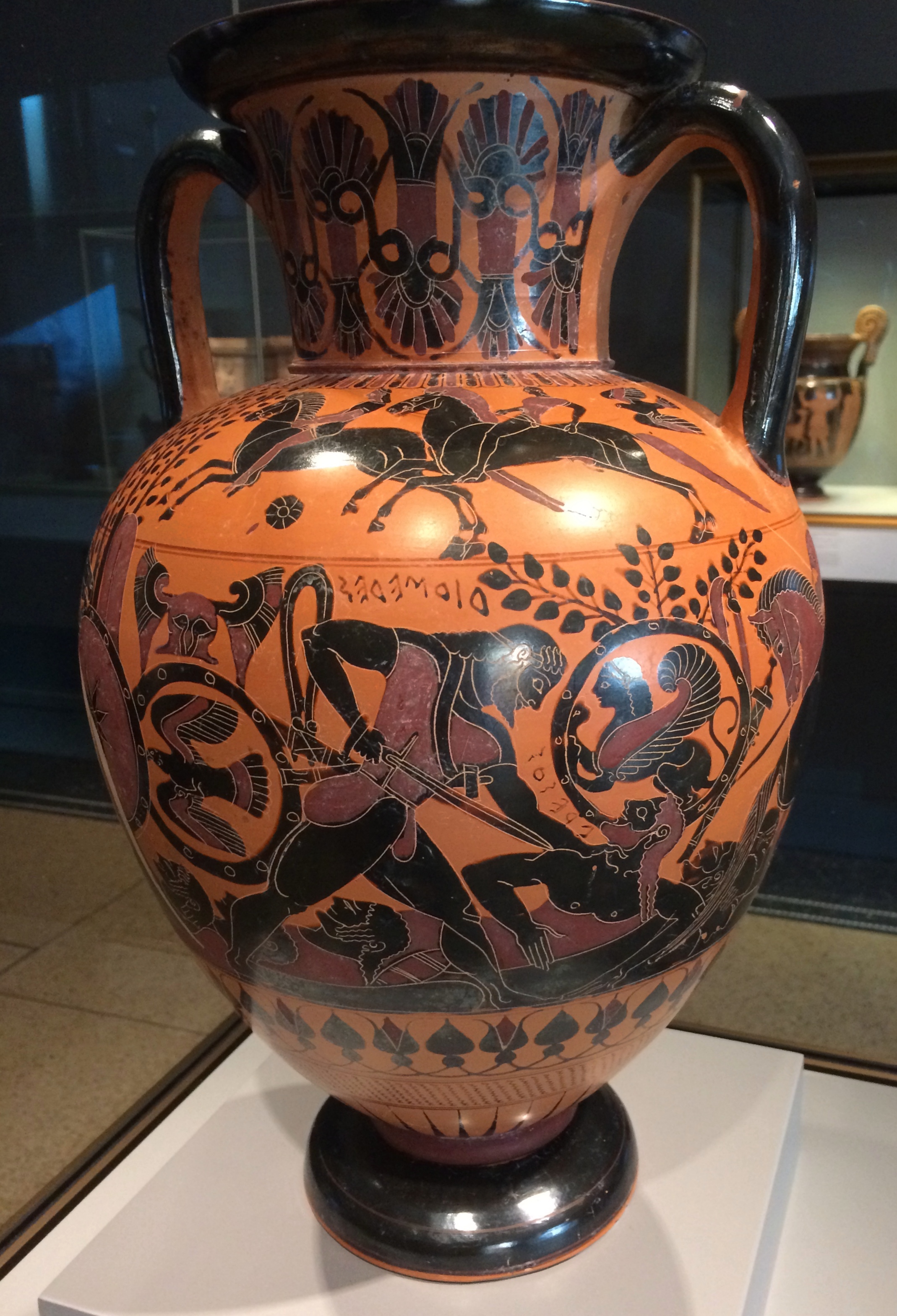 Mixing Vessel with Adonis and Goddesses.
Mixing Vessel with Adonis and Goddesses.
 Prize Vessel with a Chariot Race
Prize Vessel with a Chariot Race
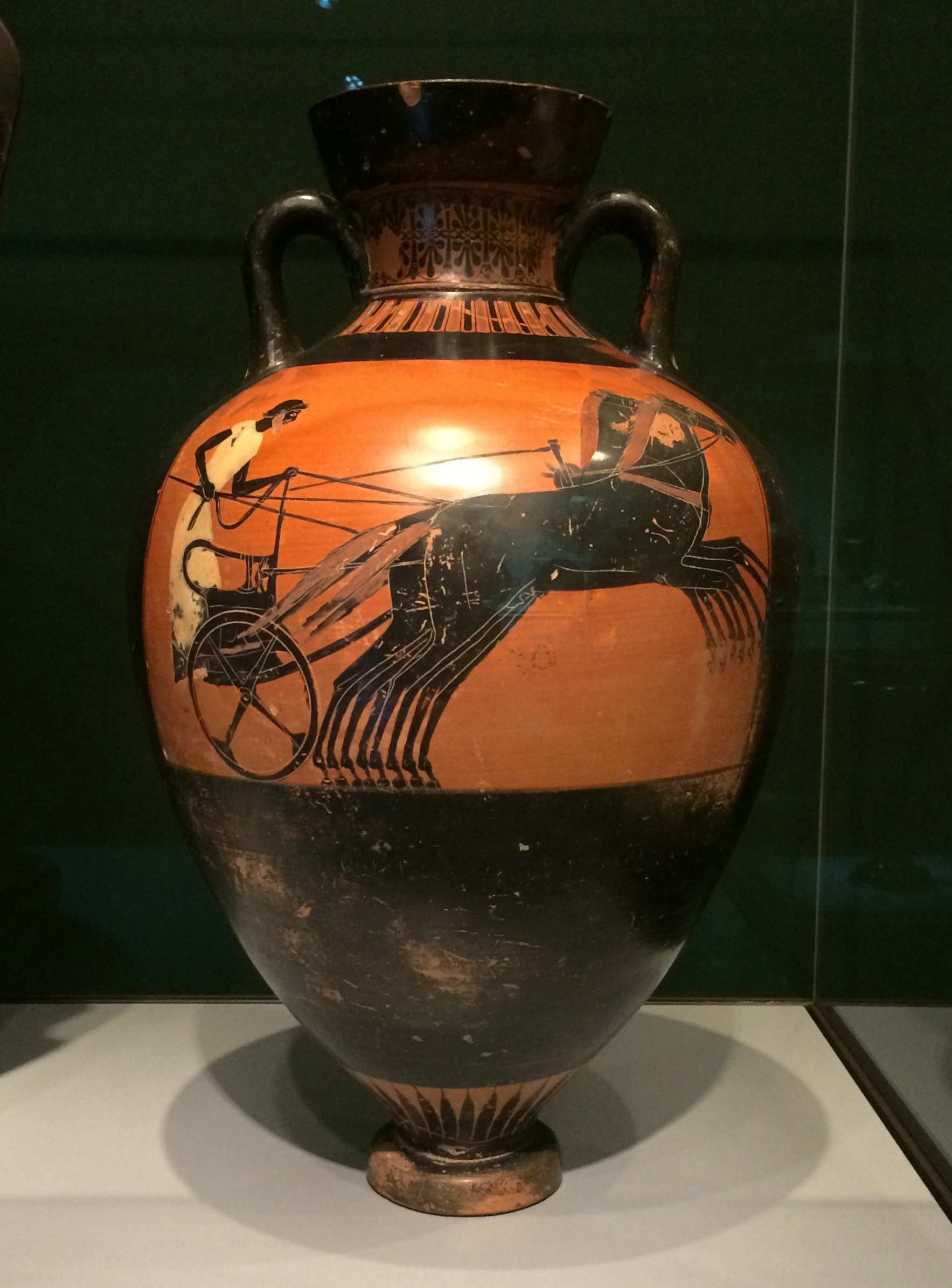 All in all, the ancient art collection is in the same league as those at the British Museum and the Pergamon Museum, in my amateur opinion, though I’ve barely scratched the surface of the many collections around the world.
All in all, the ancient art collection is in the same league as those at the British Museum and the Pergamon Museum, in my amateur opinion, though I’ve barely scratched the surface of the many collections around the world.
Hollywood Forever Cemetery
With a name like Hollywood Forever Cemetery, I suspected — in spite of what I’d read — that the place had gotten the Hollywood treatment instead of a proper renovation. That is, superficial and unsatisfying.
Fortunately, I was wrong. Just off a dowdy selection of Santa Monica Blvd., Hollywood Forever is a resplendent cemetery, on par with any of the lush rural-cemetery-movement grounds I’ve seen in other parts of the country.
With examples of funerary art.
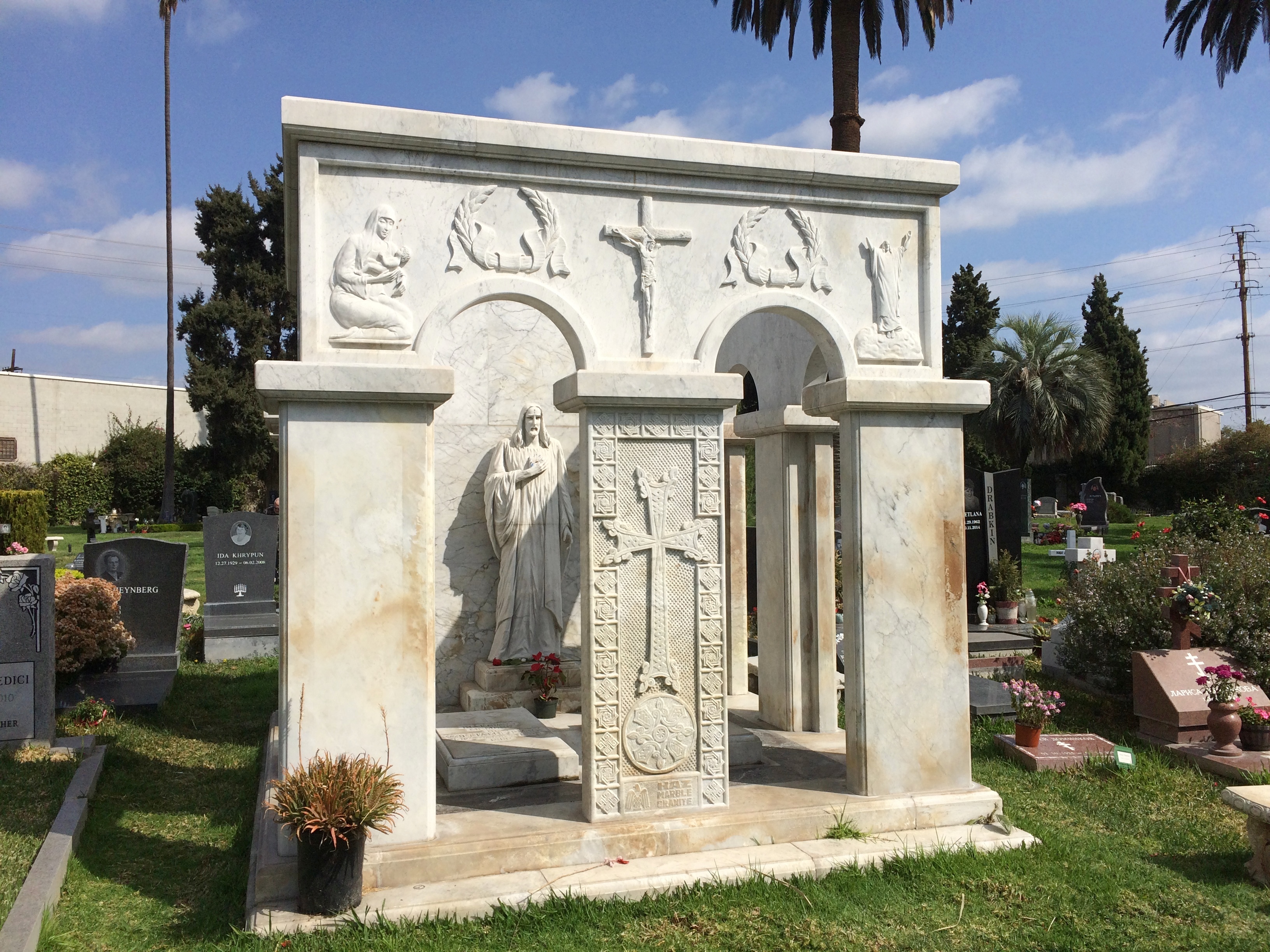
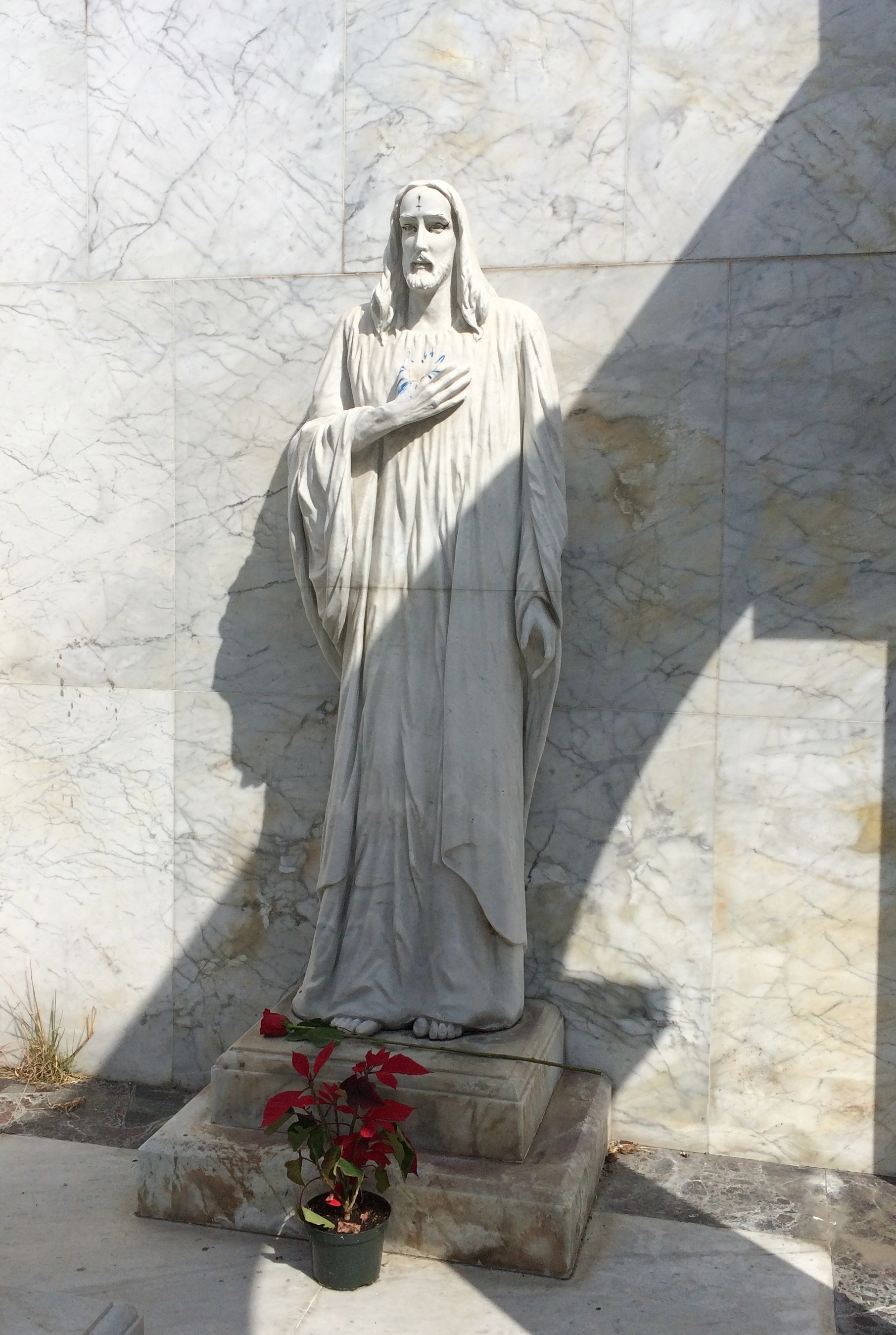 A number of private mausoleums.
A number of private mausoleums.
 Including one picturesquely set on a small island, the tomb of William A. Clark Jr. (1877-1934), son of copper baron Sen. William A. Clark Sr.
Including one picturesquely set on a small island, the tomb of William A. Clark Jr. (1877-1934), son of copper baron Sen. William A. Clark Sr.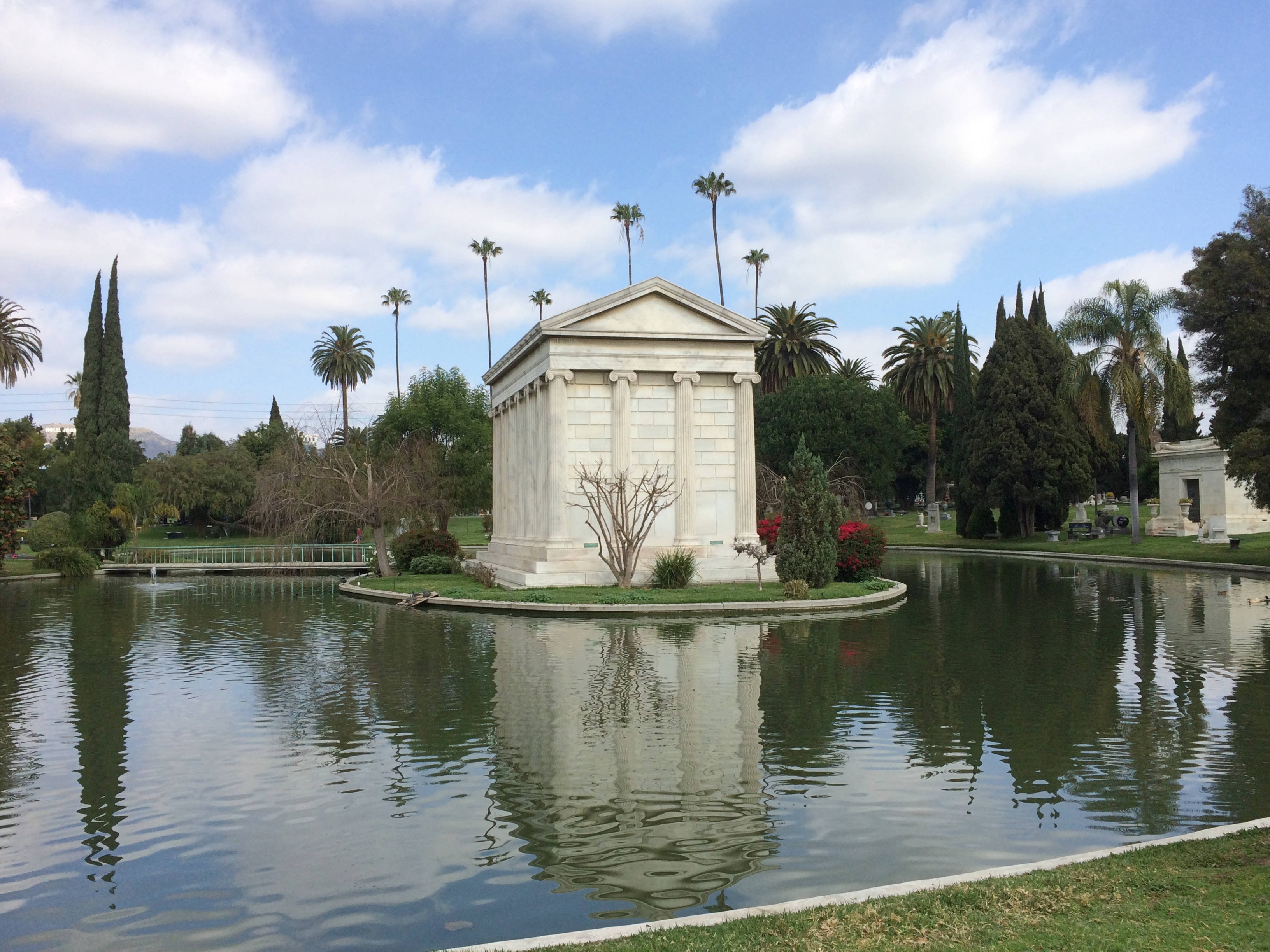
Plenty of trees.
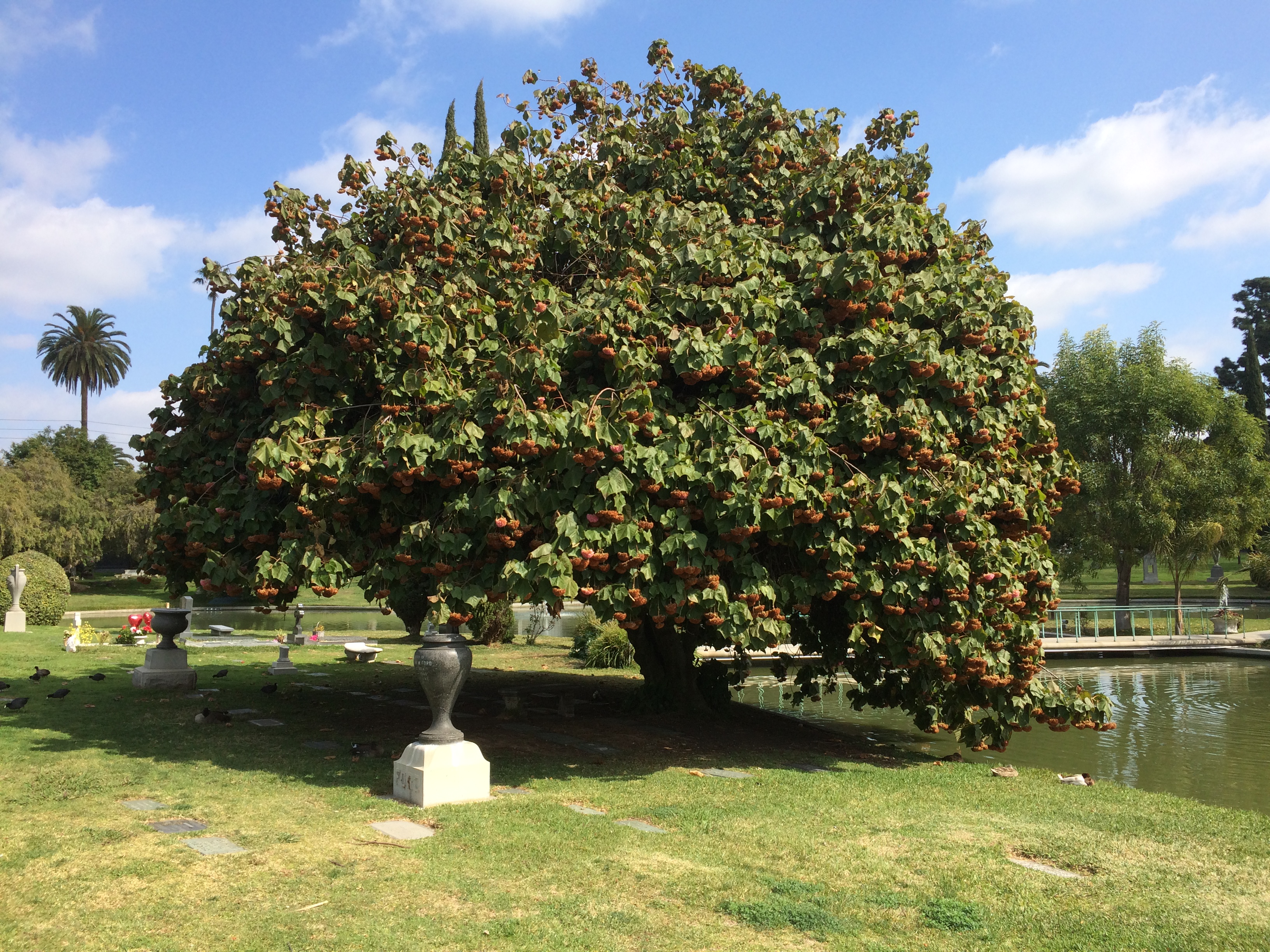 If you find just the right spot, you can see the Hollywood sign off in the distance.
If you find just the right spot, you can see the Hollywood sign off in the distance.
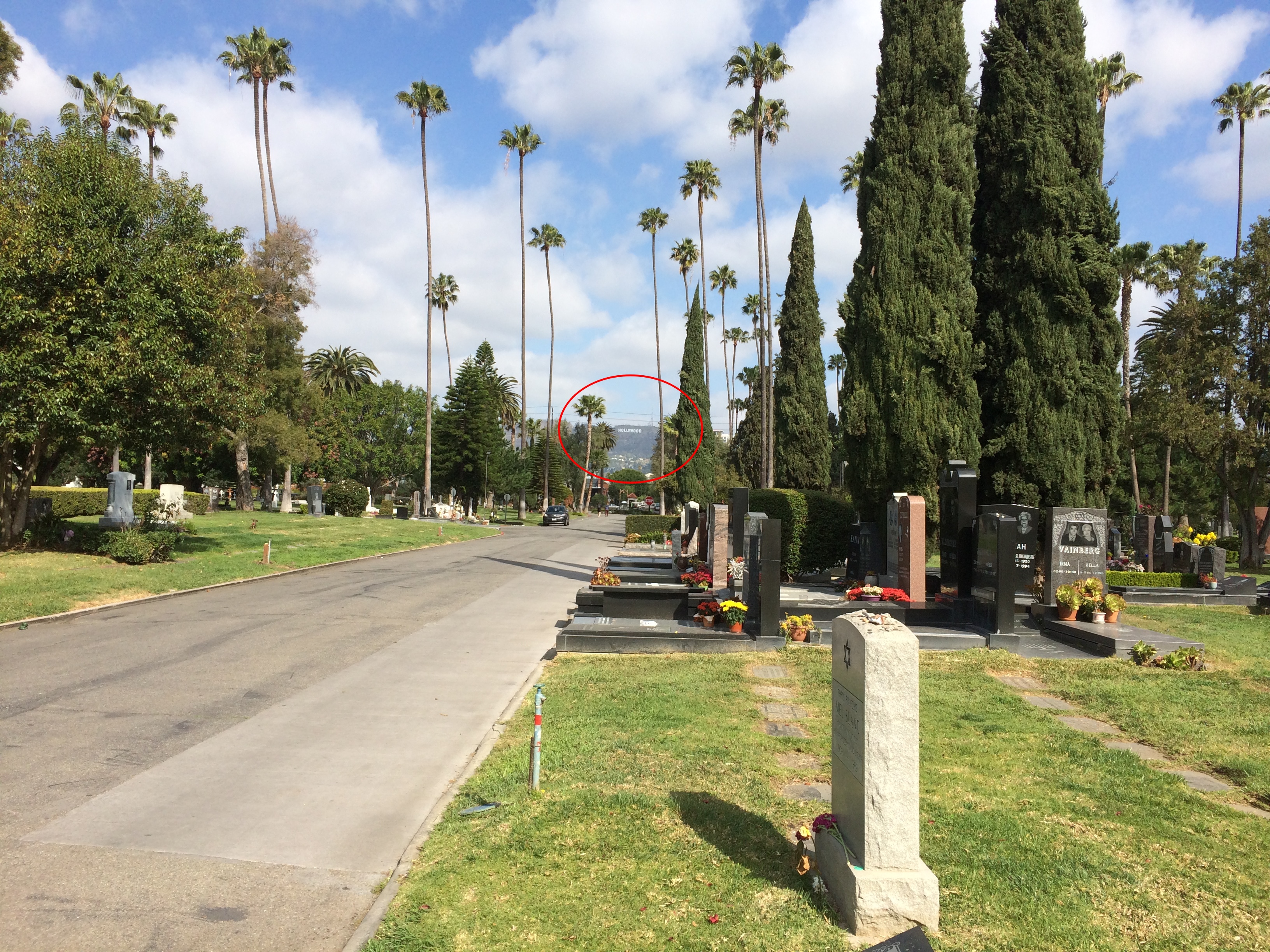 There are a few unexpected features, such as a section devoted to Southeast Asian memorials.
There are a few unexpected features, such as a section devoted to Southeast Asian memorials.
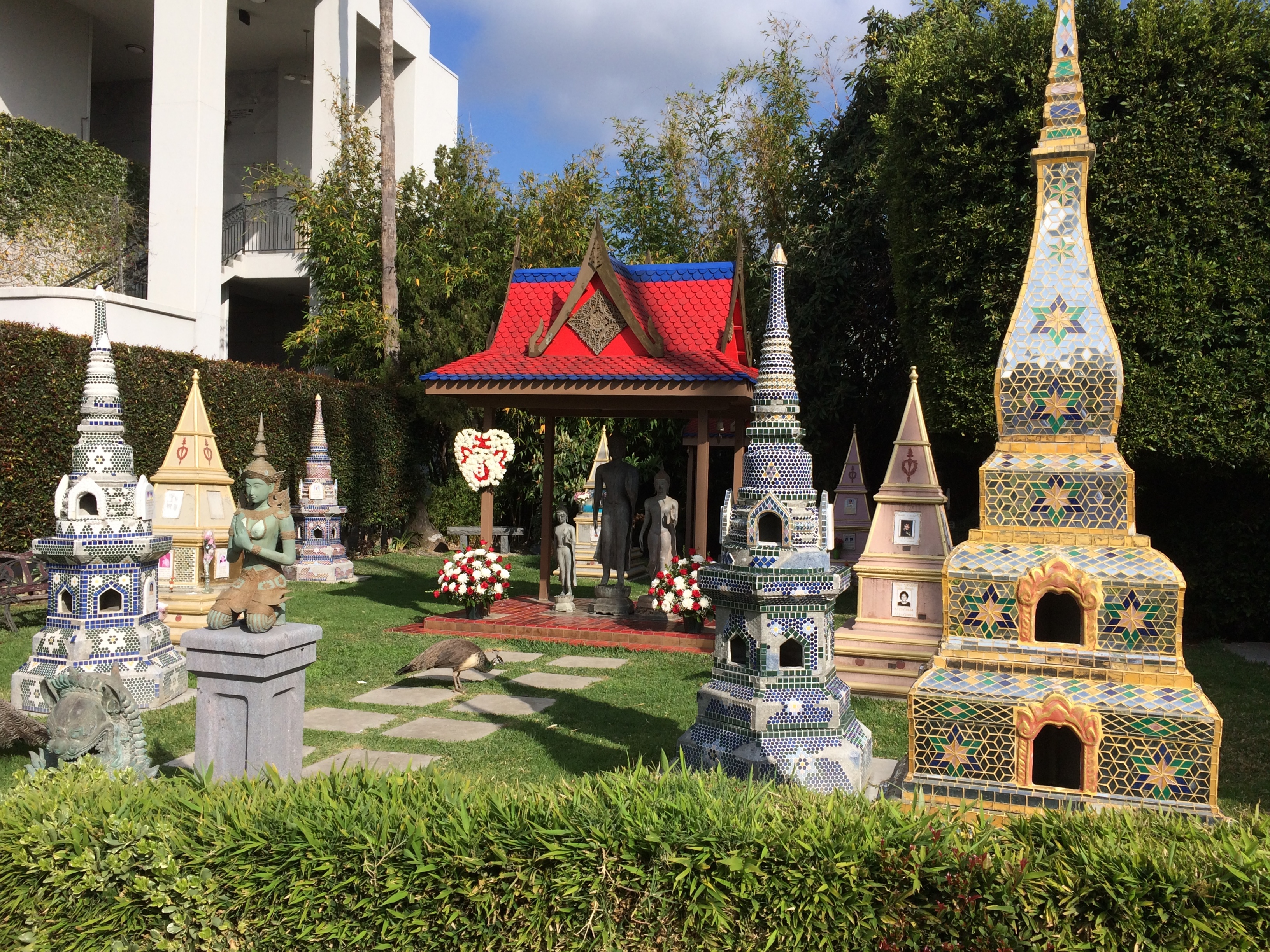 I’ve also read that in our time, Russian immigrants are fond of the cemetery. There’s plenty of visible evidence of that.
I’ve also read that in our time, Russian immigrants are fond of the cemetery. There’s plenty of visible evidence of that.
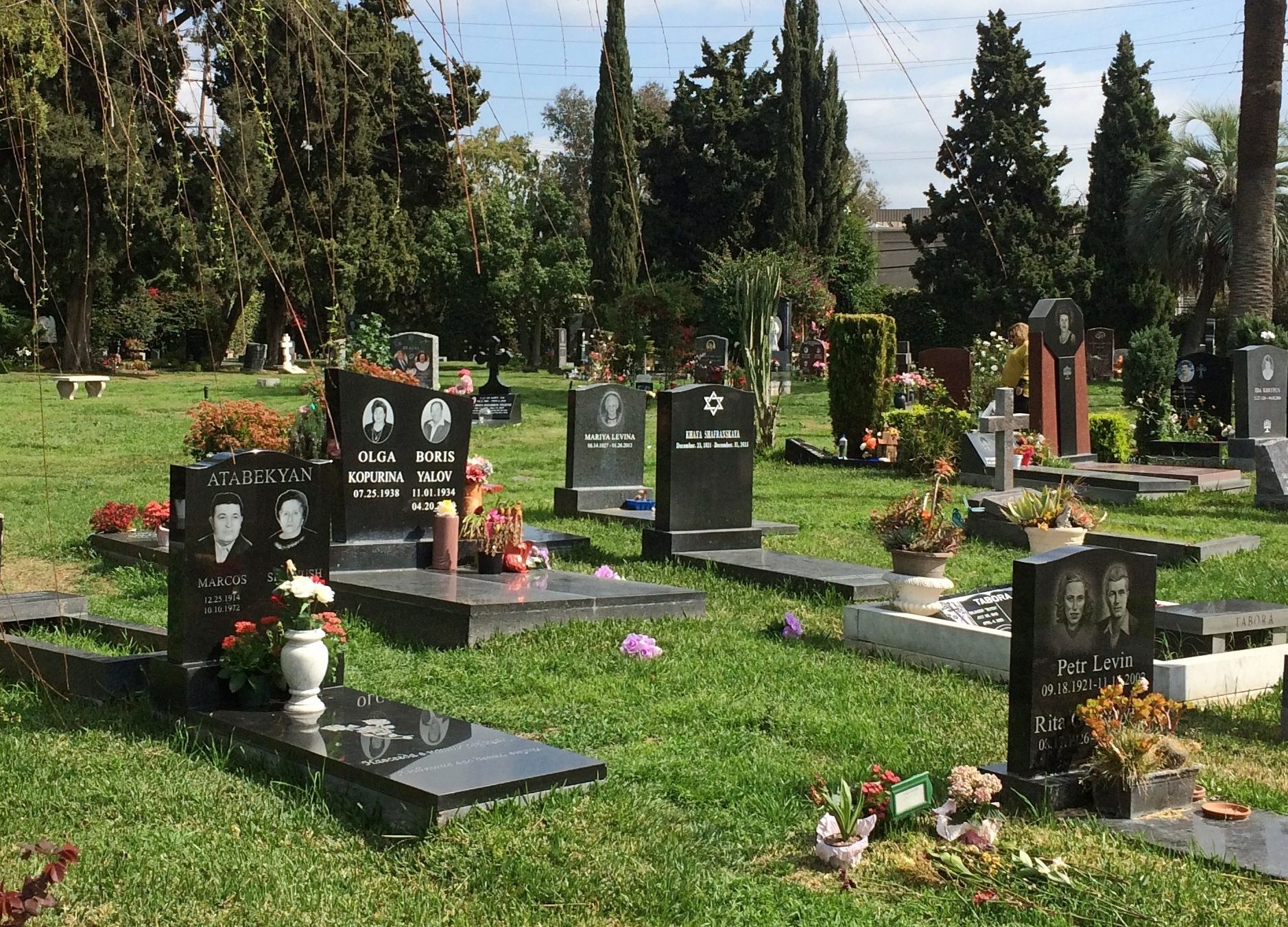
Along with a sprinkling of earlier Russian émigrés.
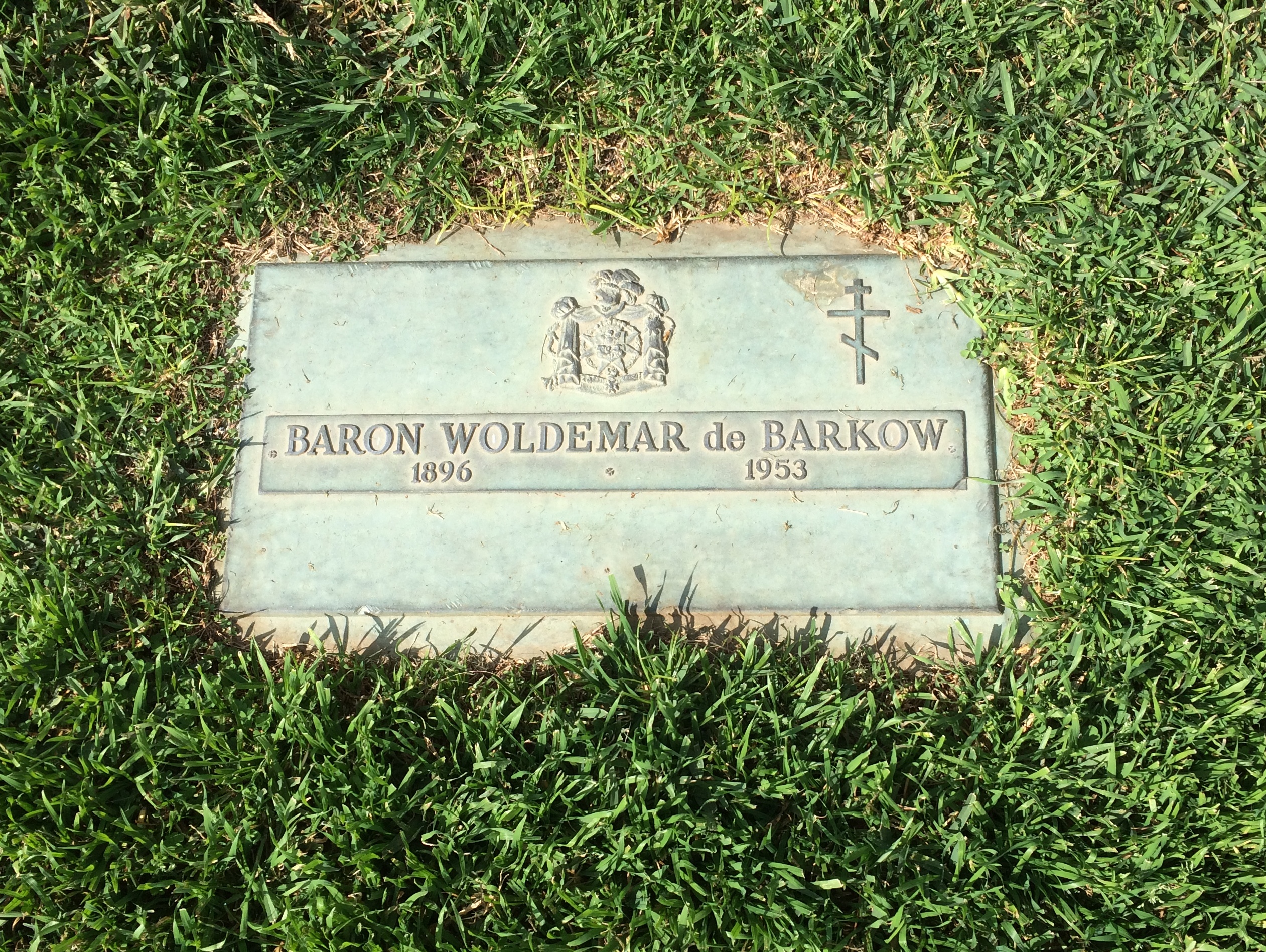 Hollywood Forever also sports a number of unconventional memorials. Something you might expect in California, except that I’ve seen them elsewhere.
Hollywood Forever also sports a number of unconventional memorials. Something you might expect in California, except that I’ve seen them elsewhere.

 Or maybe not unconventional, but just a little unusual.
Or maybe not unconventional, but just a little unusual.
Plenty of regular folks, too. Most of the permanent population would be, I believe. John Taylor was laid to rest just as the movie business started getting off the ground in Hollywood.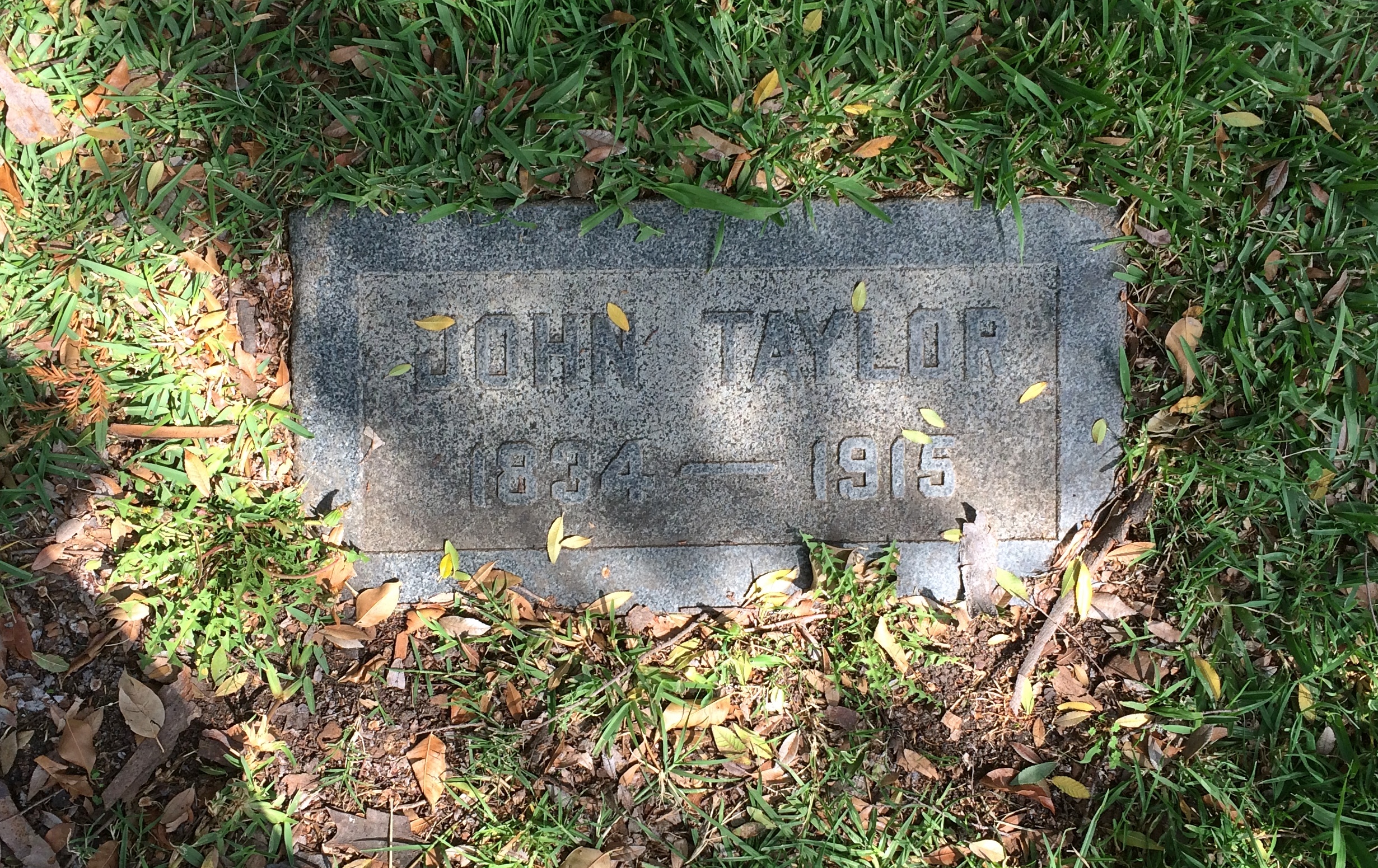
The cemetery dates back to 1899 and has had three names: Hollywood Cemetery, Hollywood Memorial Park, and since 1998, Hollywood Forever Cemetery. Its history is as strange as Hollywood itself.
A long-time owner in the 20th century essentially used the place as a piggy bank, and let it go to pot by the 1990s. The current owner invested millions in the property’s renovation — or oversaw the investment, and I’ll say it again, did a splendid job — with the funds at least partly generated by a pre-need funeral company Ponzi scheme his father and brother went to prison for, though the owner himself wasn’t charged. Sounds like a subplot in the entertaining and California-esque Six Feet Under, except the con was perpetrated in Missouri.
The whole story is more than I care to unpack, but for further reading there’s “The Strange History of Hollywood Forever Cemetery,” an article about the Ponzi scheme, and this entertaining article in LA Weekly.
Not only has the current owner made the cemetery look good, he’s raised public awareness of it through various events, such as outdoor movie screenings and other events not usually associated with graveyards. Also — and perhaps most astute of all, from a business perspective — he seems to have opened up space to be interred, especially in mausoleums near famous people (example to follow).
That brings me to the fact that I’ve buried the lead (har, har). All the features I’ve mentioned above are nice, but not really why I spent a couple of hours at Hollywood Forever on a pleasantly warm Sunday morning.
I’d come to find the graves of movie stars. Normally, celebrity earns a shrug from me. But I was in Hollywood. Movie stars are part of its sense of place. It’s a movie industry town, after all. Besides, a highly detailed map of the cemetery is available at the front office for a reasonable $5, and it guides you to the graves of about 200 notables.
“We sell more of these maps than we do flowers,” the lady behind the counter told me.
So I was on a treasure hunt to find some stars that I’d heard of, especially from the Hollywood of before I was born, more or less. It was fun.
Grand names are part of the deal at Hollywood Forever. Parts of the cemetery include the Garden of Eternal Love, Chandler Gardens, Garden of Memory, and a Jewish section featuring the Plains of Abraham, Garden of Jerusalem and Garden of Moses. This is the the entrance is the Abbey of Psalms Mausoleum.
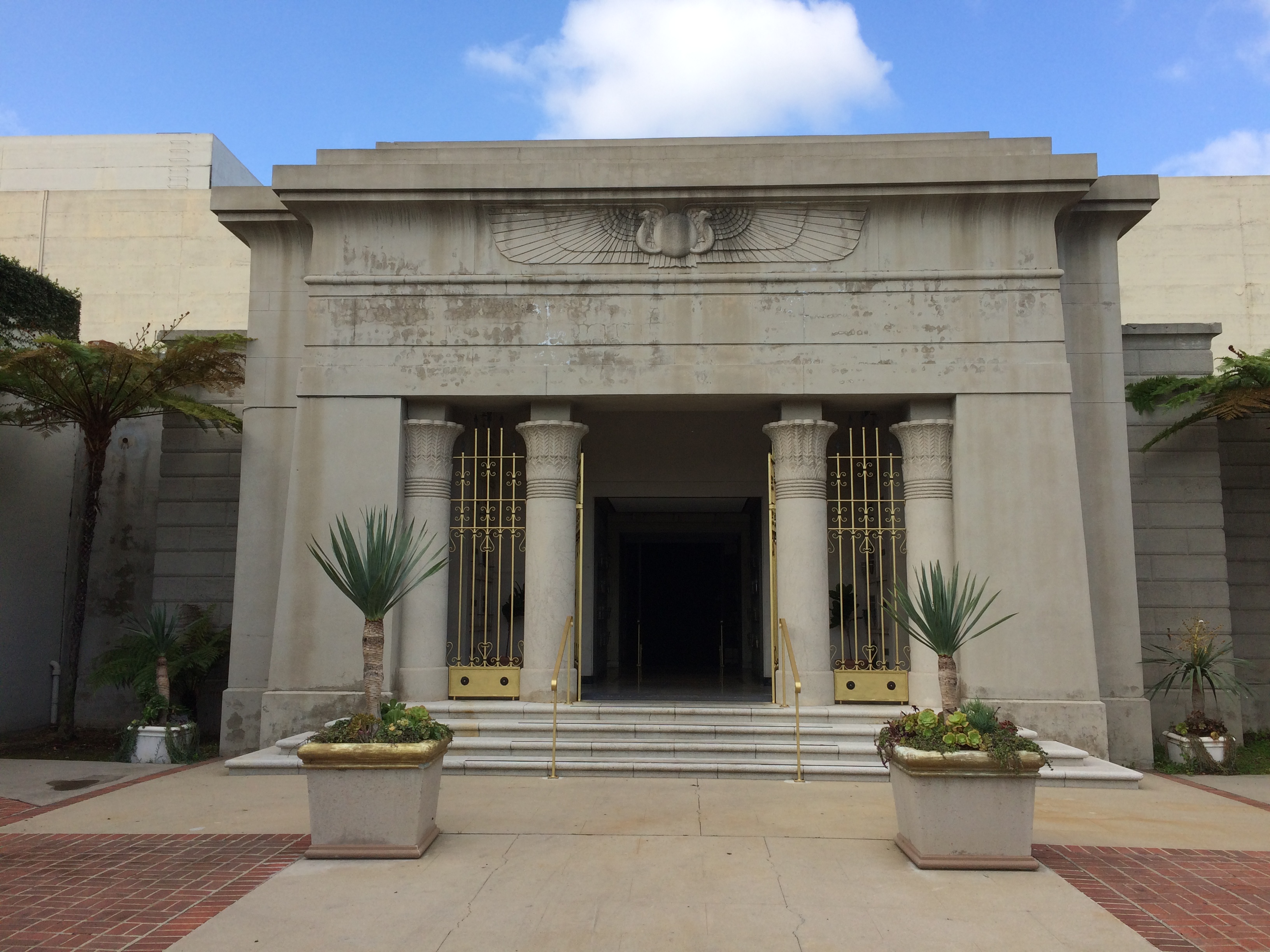
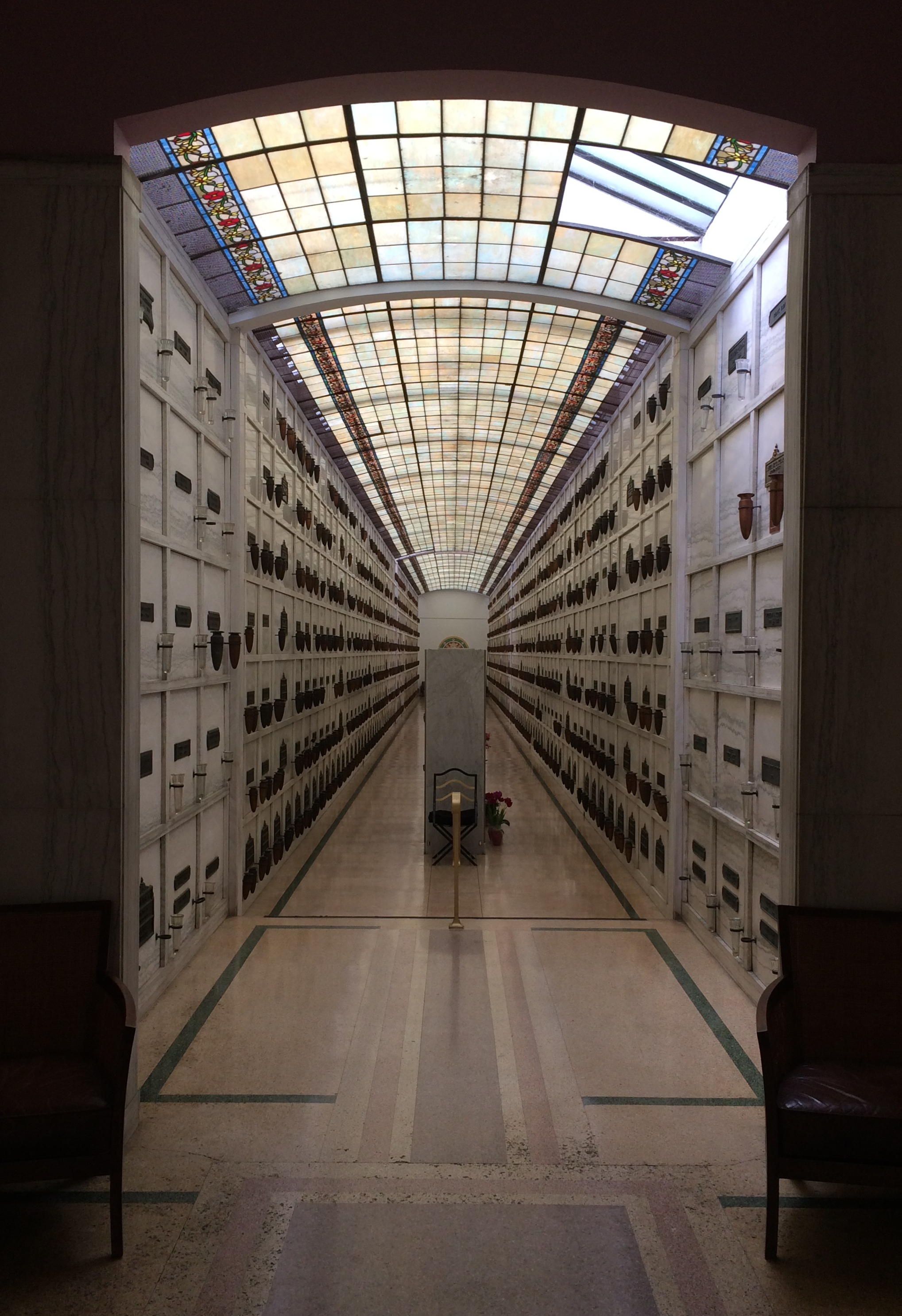 I entered in search of the Crying Indian, Iron Eyes Cody. I found him in a modest niche. His wife, who died about 20 years before he did, rests there as well. She’s called “Mrs. Iron Eyes Cody” on the plaque; you have to look her up to learn she had a name besides her Italian-American husband’s made-up Native American name. She was Bertha Parker Pallan and, unlike him, was actually an Indian.
I entered in search of the Crying Indian, Iron Eyes Cody. I found him in a modest niche. His wife, who died about 20 years before he did, rests there as well. She’s called “Mrs. Iron Eyes Cody” on the plaque; you have to look her up to learn she had a name besides her Italian-American husband’s made-up Native American name. She was Bertha Parker Pallan and, unlike him, was actually an Indian.
Iron Eyes is small potatoes compared to the real star of the Abbey of Psalms: Judy Garland. She has her own chapel-like room, re-interred there only in 2017. That must have been quite a coup for Hollywood Forever.
Want to have your ashes near Judy? It can be arranged. A lot of new-looking, glass-door niches are in the chapel walls, most still empty, though I did note that John Cassese, the “Dance Doctor,” recently occupied an eye-level niche across from Judy. His niche includes an urn, but also a bobblehead-like figure of him, a printed obituary, an award he won in 2013, a small disco ball, some seashells and other objects.
From there I headed to the open air, looking for Mel Blanc.
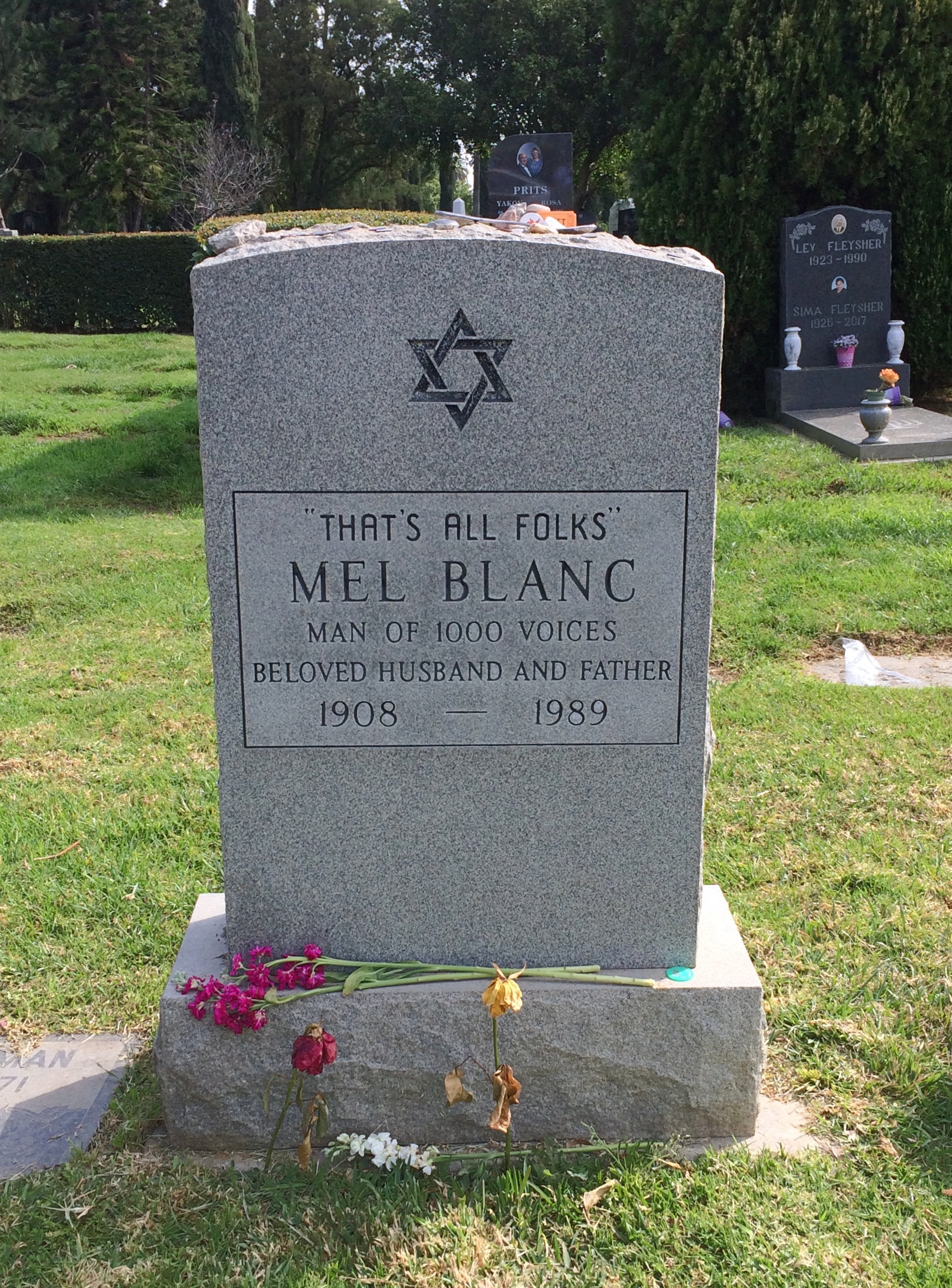 I left a penny. Here was a man who had entertained me and millions of others.
I left a penny. Here was a man who had entertained me and millions of others.
Most of the graves I wanted to see were in the Garden of Legends, an open area, and the Cathedral Mausoleum, so I soon headed that way. Douglas Fairbanks and Douglas Fairbanks Jr. have their own lawn and reflecting pool, with a major memorial next to the Cathedral Mausoleum.
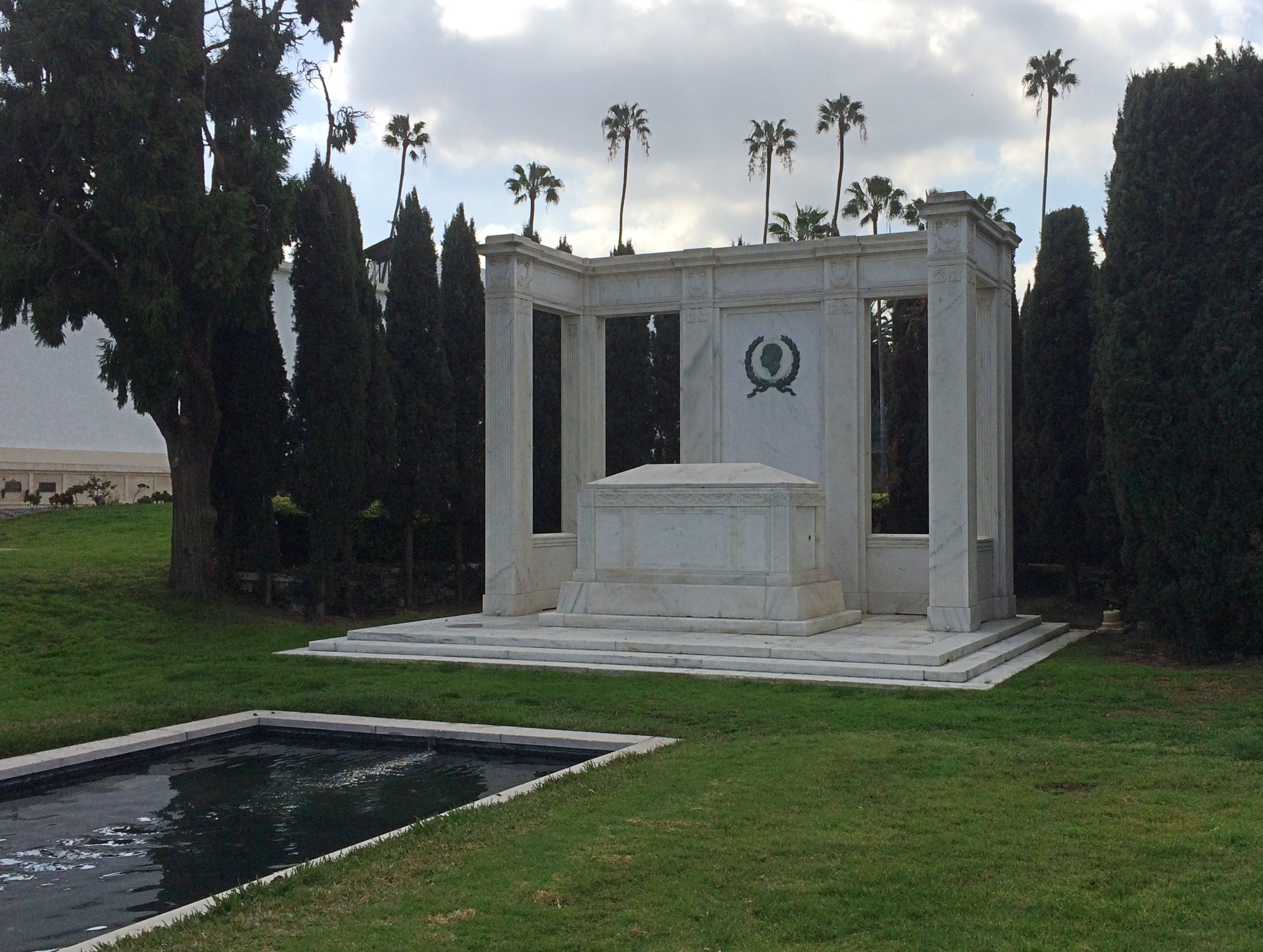 The cemetery shop only had a few postcards for sale, but they included ones featuring Douglas Fairbanks, probably dressed for The Black Pirate and looking very much like the actor who invented swash and buckle. I sent one of them to a friend of mine and wrote, “You or I might be cool, but we’ll never be Douglas Fairbanks cool.”
The cemetery shop only had a few postcards for sale, but they included ones featuring Douglas Fairbanks, probably dressed for The Black Pirate and looking very much like the actor who invented swash and buckle. I sent one of them to a friend of mine and wrote, “You or I might be cool, but we’ll never be Douglas Fairbanks cool.”
Heading into the Garden of Legends, I soon happened across Johnny Ramone. I didn’t even know he was dead.
 Nearby is a cenotaph for Hattie McDaniel, who was denied burial here in 1952 because of segregation. Her memorial was erected in 1999.
Nearby is a cenotaph for Hattie McDaniel, who was denied burial here in 1952 because of segregation. Her memorial was erected in 1999.
Next I spent a while looking for Fay Wray, and found her, and then Erich Wolfgang Korngold. The composer is buried under a tree.

 I sent the picture to my old friend Kevin, a movie music enthusiast. But for Kevin I might not know about Korngold, or have ever listened to such treasures as the music from The Adventures of Robin Hood or The Sea Hawk.
I sent the picture to my old friend Kevin, a movie music enthusiast. But for Kevin I might not know about Korngold, or have ever listened to such treasures as the music from The Adventures of Robin Hood or The Sea Hawk.
Rounding the pond that forms the centerpiece of Garden of Legends, I came across Cecil B. DeMille.
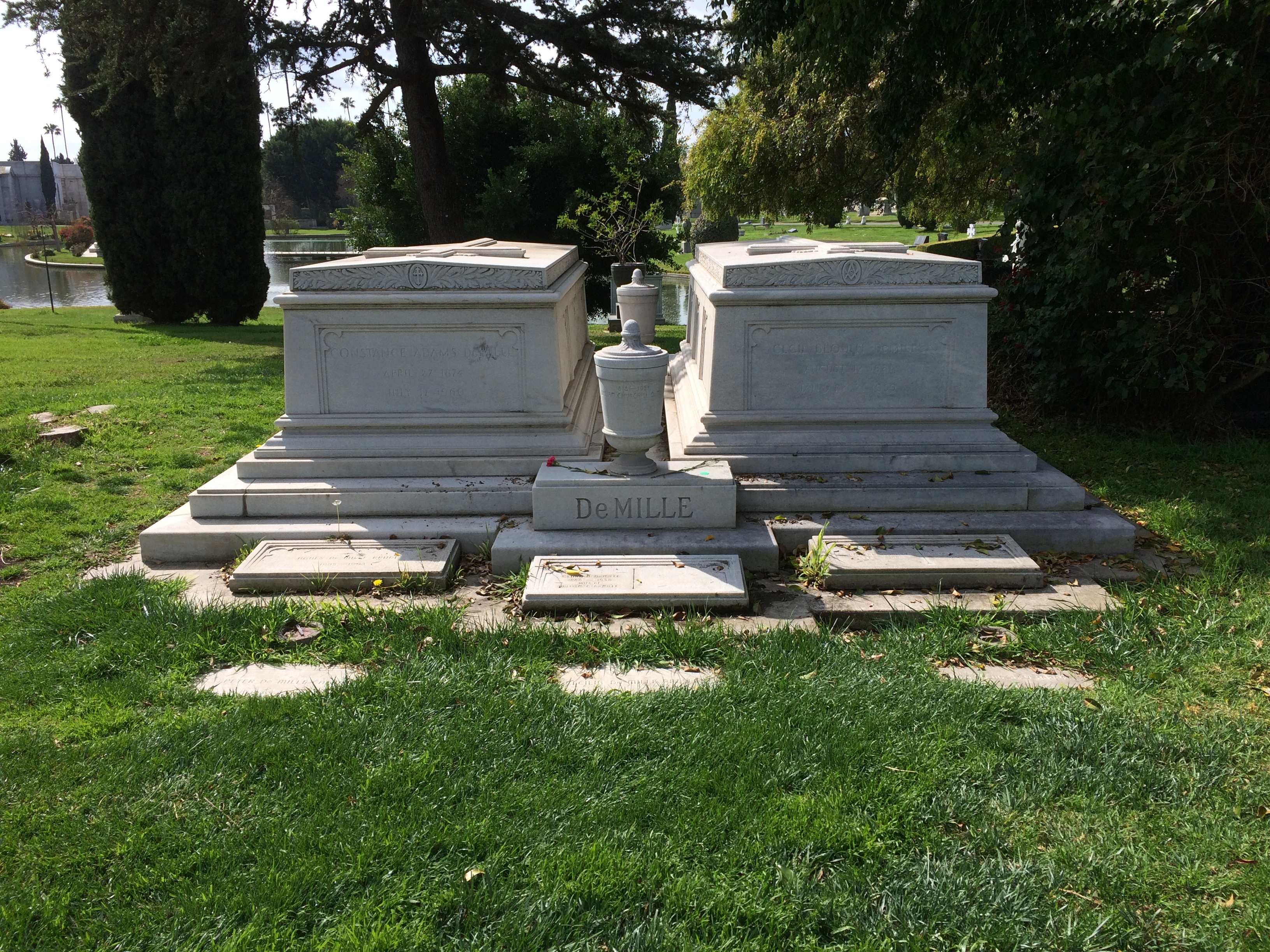 One I hadn’t been looking for: Virginia Rappe.
One I hadn’t been looking for: Virginia Rappe.
 I puzzled for a moment. Who was that? Then I remembered.
I puzzled for a moment. Who was that? Then I remembered.
Tyrone Power is hard to miss.
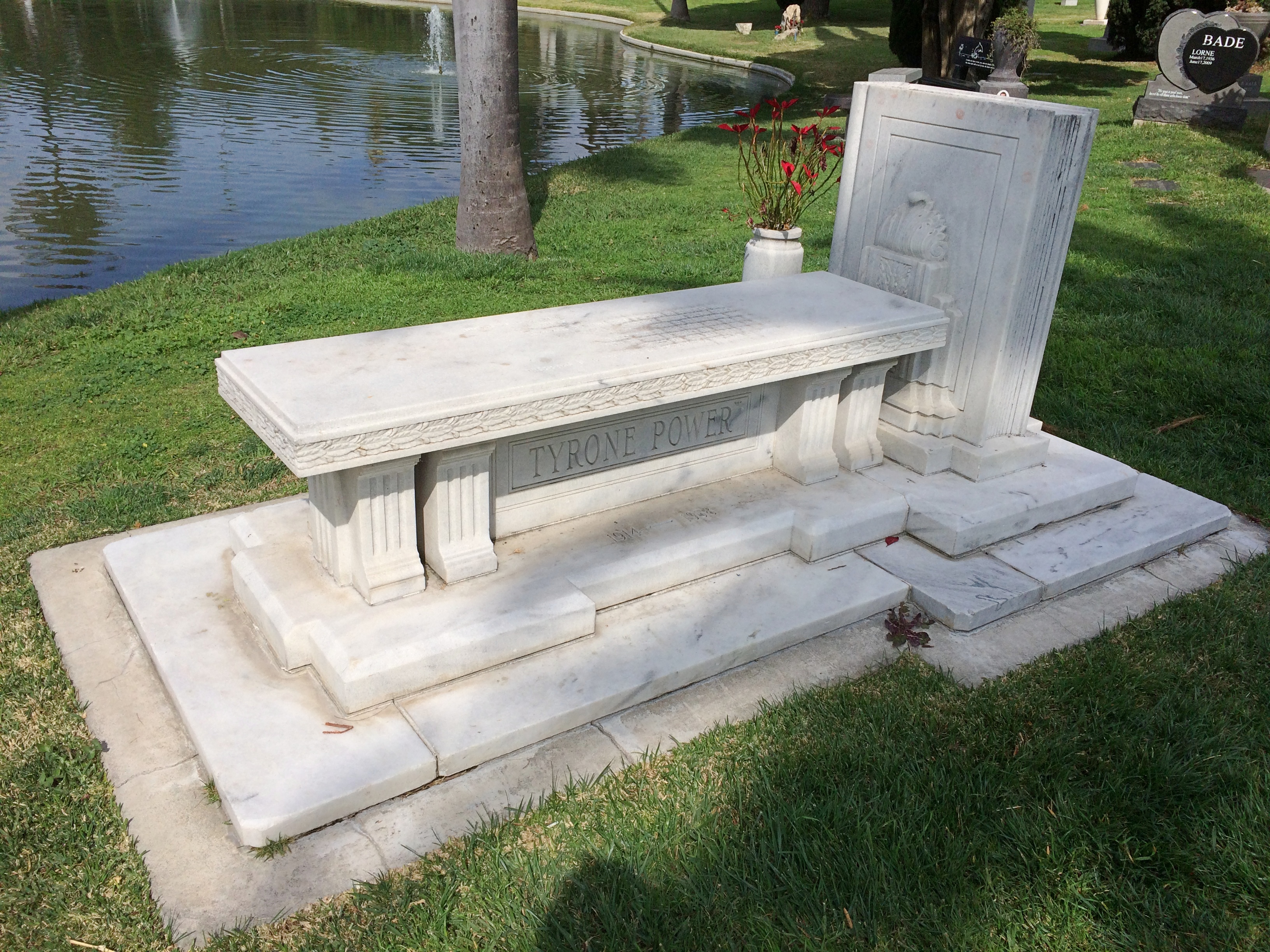 Next to him is Marion Davies’ mausoleum, which you might miss if you don’t know that her actual name was Douras, which is above the entrance. She paid for the building herself, I’ve read.
Next to him is Marion Davies’ mausoleum, which you might miss if you don’t know that her actual name was Douras, which is above the entrance. She paid for the building herself, I’ve read.
 At the Cathedral Mausoleum, an even larger complex than the Abbey of Psalms Mausoleum, I found Peter Lorre in a niche. I was looking for him. I also found Mickey Rooney. I wasn’t looking for him, but he does illustrate that stars are once again considering the cemetery, now that the period of neglect is over.
At the Cathedral Mausoleum, an even larger complex than the Abbey of Psalms Mausoleum, I found Peter Lorre in a niche. I was looking for him. I also found Mickey Rooney. I wasn’t looking for him, but he does illustrate that stars are once again considering the cemetery, now that the period of neglect is over.
Rooney’s inscription says: “One of the greatest entertainers the world has ever known. Hollywood will always be his home.”
Well, de mortuis nihil nisi bonum, Mickey, though I want to mock that inscription. Then I began noticing some other recent arrivals from the movie business, most of whom I’d never heard of. Some of the memorials were like ads in Variety, touting their careers.
Last stop: Valentino. I couldn’t very well miss him.
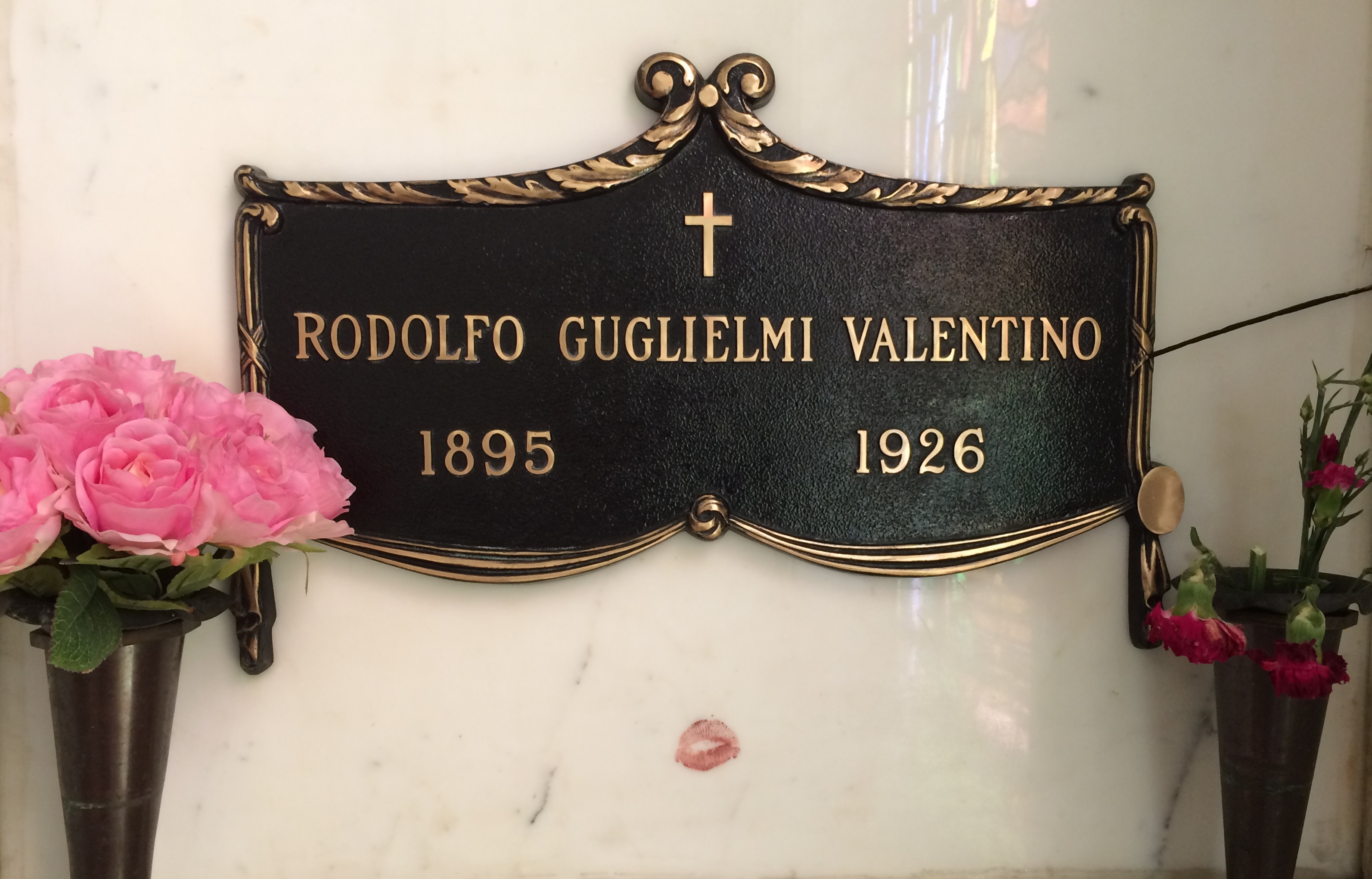 I’d read that lipstick is often there, and so it was. He’s got amazing staying power for a silent film star.
I’d read that lipstick is often there, and so it was. He’s got amazing staying power for a silent film star.
Curious, I took note of the grave next to Valentino: June Mathis Balboni (d. 1927). Just an accident that this person is next to the Great Lover?
No. She knew him. In fact, she discovered Valentino and wrote some of his movies, most notably The Four Horsemen of the Apocalypse. Remarkable the tales that cemeteries tell.
SoCal Driving
Remarkable how quickly last week’s political mail becomes obsolete.
Then again, if he follows through with his promises, we’ll continue to get mail from his organization until election day. The message will just be a little different. Namely, Kick the SOB Out, or words to that effect.
Before I visited Southern California last month, I was slightly apprehensive about driving there, which was in no way rational. I’ve driven in most major U.S. metro areas, including Los Angeles, without major incident. I’ve been jammed up in traffic and had near accidents and gotten lost, but those things can happen anywhere.
Driving around SoCal wasn’t bad at all. As mentioned before, I opted out of GPS. Don’t need a box telling me where to go, especially when its advice tends to be: find the nearest freeway. I used maps — electronic maps, in this case. That’s about the best thing my phone does for me, as I discovered walking around in New York a couple of years ago.
(One strange thing that first happened during that trip was people asking me for directions, with a phone in their hands. They pointed to the Google Maps display and asked, how can I get to x from here? Dunno, man, read the map, maybe.)
You can’t — at least certainly shouldn’t — call up Google Maps while driving, and I didn’t do that, but usually it was easy enough to find a place to stop to consult a map. Also, here’s a tip for getting a light to change: start fiddling with your phone to look up a map, and it is sure to change.
Often enough I didn’t need to consult a map. Los Angeles street theory isn’t perfectly grid-like, but it has strong elements of a grid. Up one major street for miles, over another for more miles.
Not that I wanted to drive everywhere. The first morning in town, a Saturday, I drove only as far as a station on the relatively new Expo Line, which goes from Santa Monica to downtown LA, or vice verse.
I rode it downtown from the Expo/La Cienega station, through miles of the city I’d never seen before, including the edge of the University of Southern California. Good old USC — how persistent that school was in sending me mail in the late ’70s and early ’80s, inviting me to apply, even after I was attending VU.
On my second day in town, a Sunday, I got up early, strategy in mind. I was staying fairly near I-405, the 405 as it’s called locally, so I took that freeway north to I-10, the 10, and headed east from there to Western Ave. I’d read that the 405 was one of LA’s worst freeways in terms of congestion, and maybe it is.
But just before 8 on Sunday morning, I encountered smooth driving on the 405, as well as the 10, where traffic was also light. Getting off the highway, I headed north and soon found myself in Koreatown. Easy to know you’re there, because of the Hangul signs. Soon I began to wonder, just how large is Los Angeles’ Koreatown? I passed block after block after block after block of Hangul-marked buildings. How big? Really big.
Eventually, I turned west on Santa Monica Blvd. to reach the Hollywood Forever Cemetery, but also to begin the longest drive of the day, west from there to Santa Monica itself, through (among other places) West Hollywood and Beverly Hills.
A virtual stage, it seemed to me — a carnival of sights to see, a spectacle of wealth and poverty, even at driving speed. Urban texture that you experience in any North American city, and yet with its own flavor. You see only glimpses, but even so you pass distinct cars and trucks, but not as many trucks as some places (because LA tends to have alleys for delivery), more pedestrians than you’d think but fewer bicyclists, chain shops and independents in strip centers, apartments, houses, office buildings, churches, schools, bars, restaurants, vacant lots, buildings under construction, parking lots, car washes — a lot of them — tall palms and short bushes, cannabis dispensaries, gas stations, graffiti’d walls, mural’d walls, billboards, parking meters, neon signs, showrooms, construction zones (but not as many as I expected), lamp posts and telephone poles, self-storage and payday loan offices, parks, playgrounds and even a cactus patch.
The Cactus Garden in Beverly Gardens Park, recently renovated. I stopped for a look at the cacti and the churches next to the park.
Santa Monica’s traffic is pretty thick, so driving was less pleasant there. To get to the Getty Villa in Pacific Palisades, you head north on the Pacific Coast Highway. That too was crowded. The road is probably more scenic and less crowded further north, but Pacific Palisades isn’t that far, so I didn’t see much of the highway (we saw part of it up that way in 2001, driving to Santa Barbara, though mostly we took U.S. 101).
On Monday, the plan was to reach Palm Springs by way of freeways and then San Gabriel Canyon Road (California 39) through San Gabriel Mountains National Monument to California 2 and 138. Looked good on the map.
First, though, I had to get out of Los Angeles via freeway. I knew I didn’t want to drive anywhere near downtown, because February 24 was the day of Kobe Bryant’s memorial service at the Staples Center. So I went around downtown, and avoided the 405 too.
First, Sepulveda Blvd. south, which passes through a tunnel under LAX. I didn’t know that till I looked at the map. Then I drove it. I don’t think I’ve ever driven under an airport. I’m not sure any other airport has a tunnel under it.
From south of the airport, I took the 105 east to the 605 north to the 210, the Foothill Freeway. There were some minor snarls along the way, but nothing too bad.
Radio coverage of the memorial followed me all the way along the route. Reminded me of when Princess Diana died. It was a horrible accident, but still. Radio jocks can be counted on for maudlin twaddle at times like that.
When I got to the entrance of the monument, near Azusa, a sign said that California 2 was closed in x and y places. What did that mean? I stopped to look them up. That meant that I’d have to double back if I went as far as where 2 and 39 met, way up in the mountains. Still blocked by snow, I figured.
So I drove about 10 miles into the mountains and then drove back. Scenic territory, and not much traffic in February.
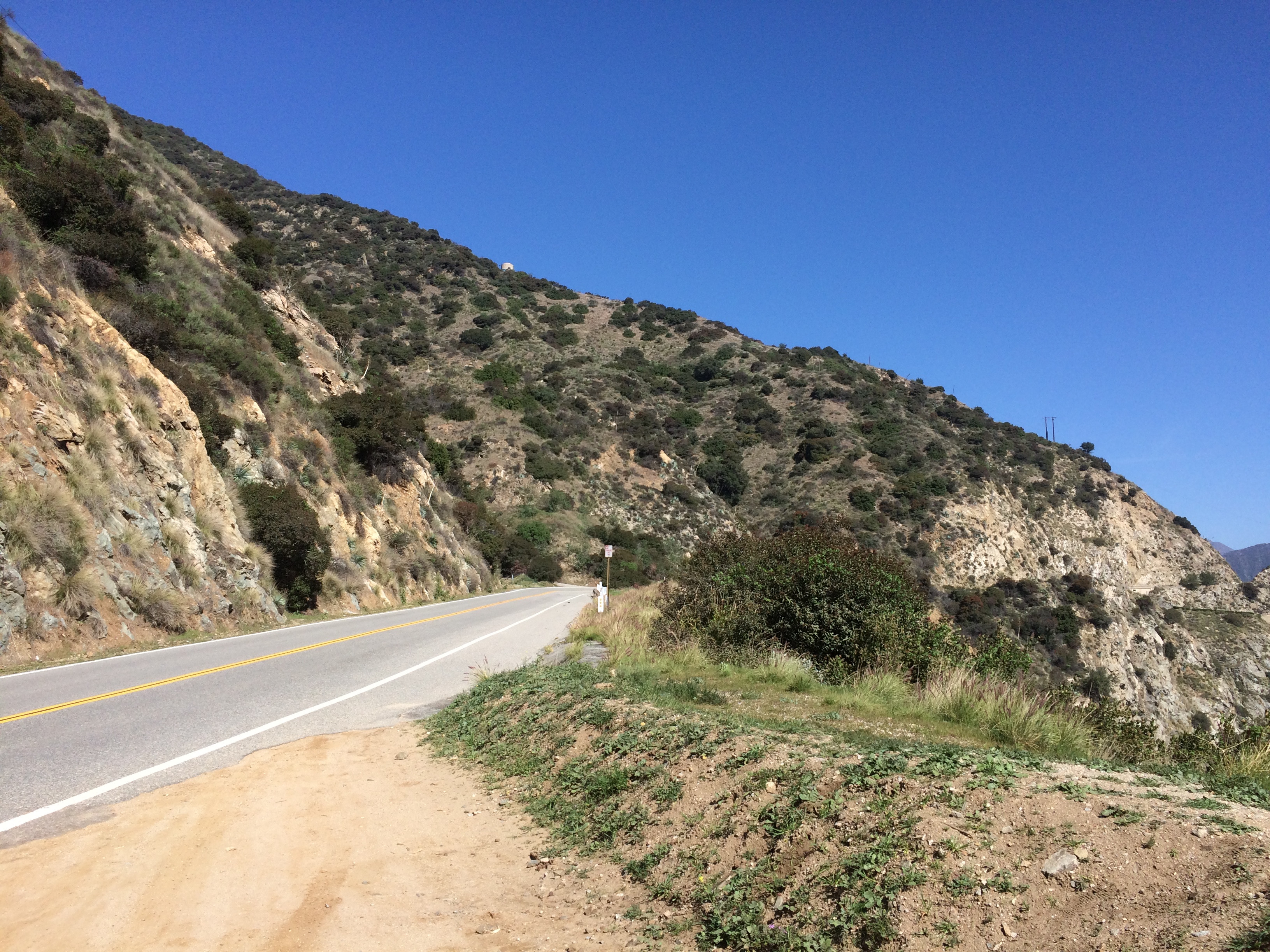
 Evidence of an unfortunate accident.
Evidence of an unfortunate accident.
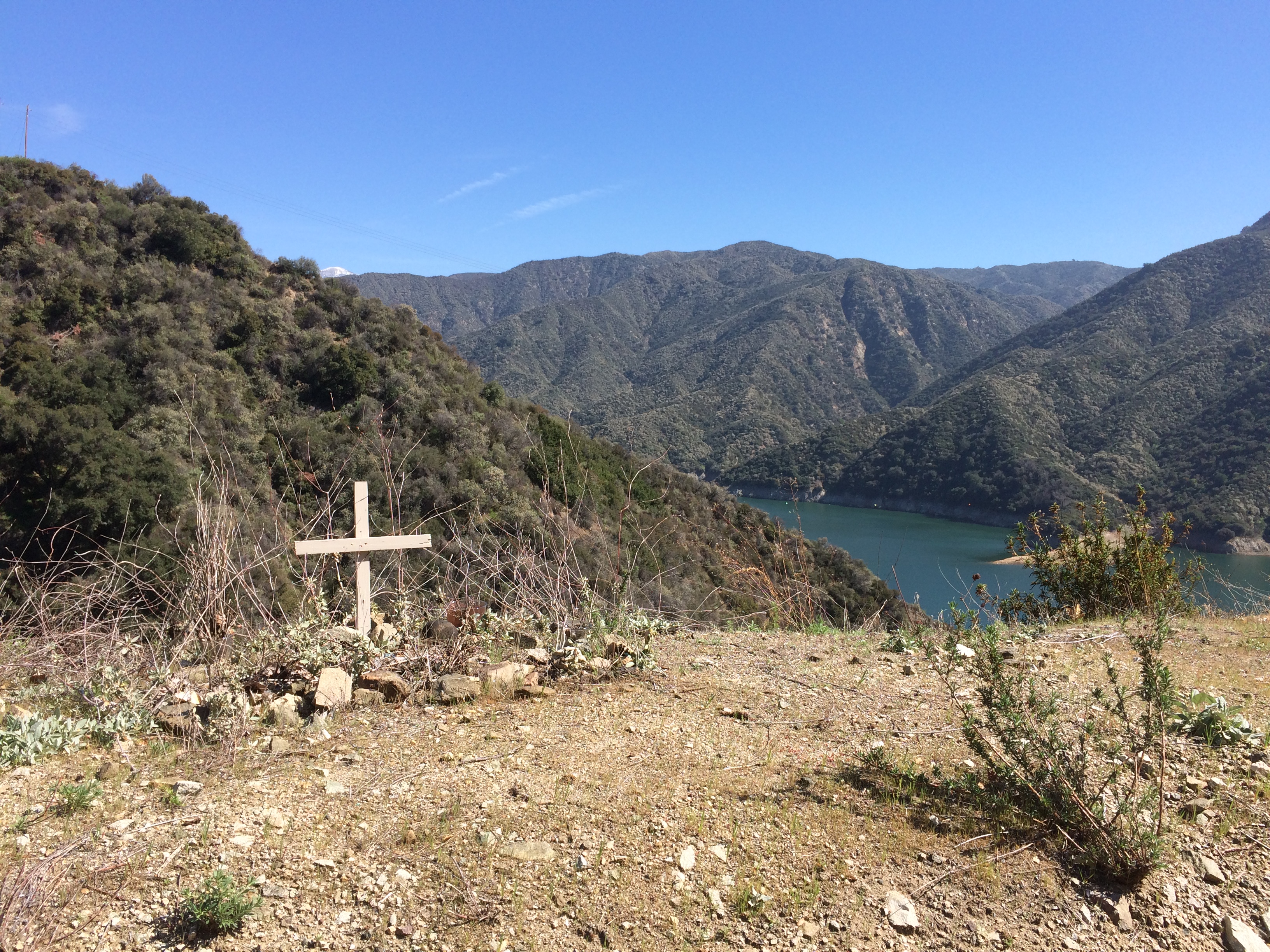 No name or date, though. No maudlin twaddle on the airwaves, either. The world is quiet when most people die.
No name or date, though. No maudlin twaddle on the airwaves, either. The world is quiet when most people die.
I spent the next hour or so driving east through the Foothill communities, including Rancho Cucamonga, along the former US 66. Of course I wanted to drive through Rancho Cucamonga.
The Foothills are naturally more suburban in character than Santa Monica Blvd. Except for the mountains looming off to the left, in fact, and the palm trees, not so different than my usual suburban haunts. I even stopped for gas at a Costco before getting back on the freeway to Palm Springs.
Didn’t drive in Palm Springs on Tuesday; Steve took me around. On Wednesday, I left town and drove to Joshua Tree National Park, whose roads are either small and paved, or small and unpaved. I drove on both kinds. On the unpaved version, through a Joshua tree forest, traffic was extremely light. I was it. Just like driving in a car commercial. Happens occasionally.
Cathedral of Our Lady of the Angels &c
Another place that still under construction the last time I visited Los Angeles, in 2001: the Cathedral of Our Lady of the Angels, the seat of the Roman Catholic Archbishop of Los Angeles.
The 1994 Northridge earthquake so badly damaged the previous seat, the 1870s Cathedral of Saint Vibiana, that the archdiocese wanted to tear it down and build another cathedral on the site. Preservationists, led by the Los Angeles Conservancy, fought against that, and so eventually a deal was struck allowing the city to take possession of the former cathedral, and the archdiocese to build a new building on downtown land given to it by the city.
These days the former cathedral is an event center — which I didn’t see — and the new cathedral, completed in 2002, looks like this.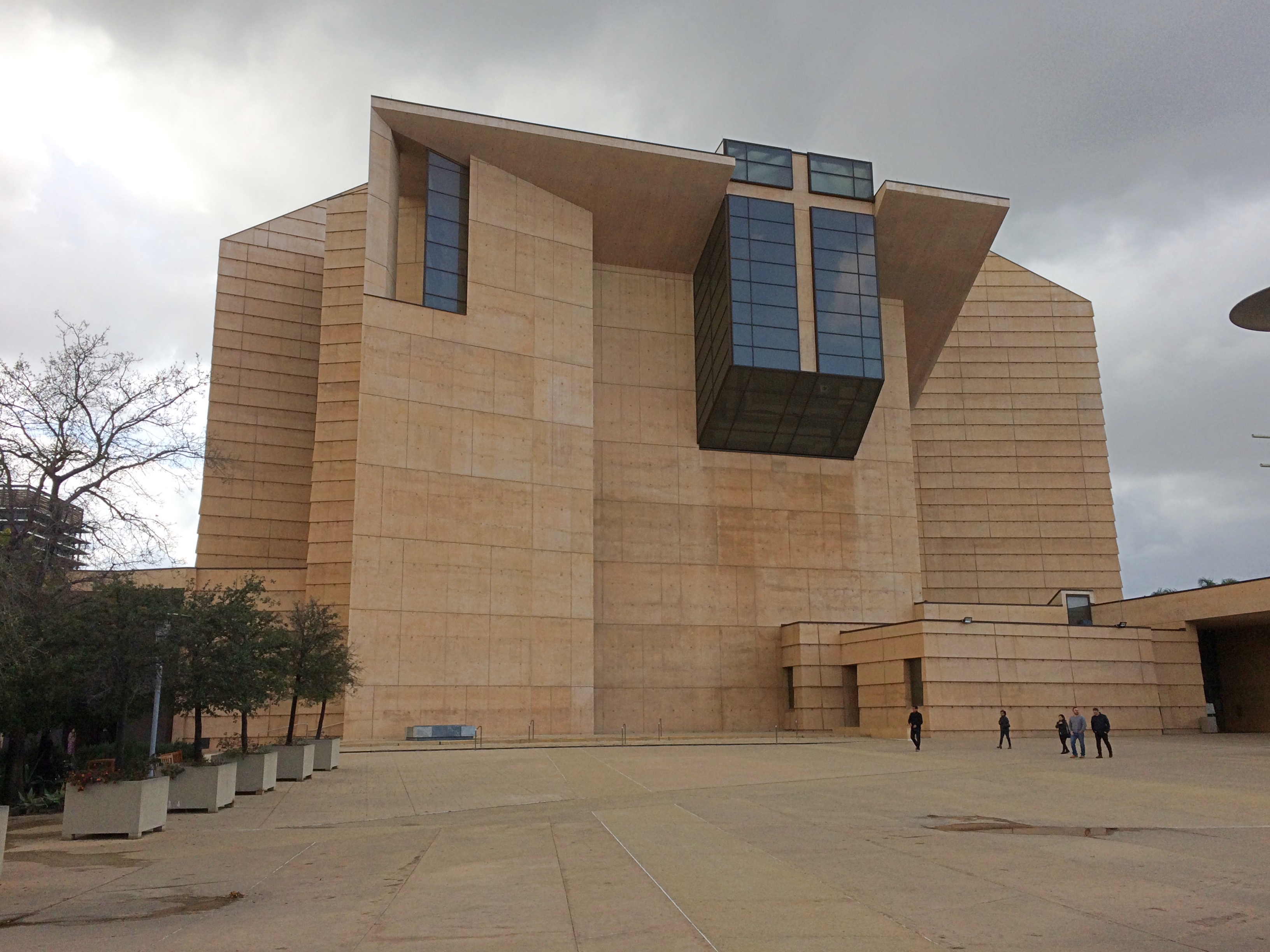 Not everyone loves the design by Rafael Moneo, which I’ve seen called deconstructivist or postmodern, but which looks pretty brutal to me. I wasn’t all that fond of it myself, though it is interesting.
Not everyone loves the design by Rafael Moneo, which I’ve seen called deconstructivist or postmodern, but which looks pretty brutal to me. I wasn’t all that fond of it myself, though it is interesting.
Does it say sacred space to me? Not particularly. You could argue that most of us have been conditioned by traditional forms to feel that way. Or you could argue that of course sacred space should be beautiful, not brutal. Take your pick. My goal when I’m somewhere is to see what’s there.
Besides, the interior is less brutal somehow.
 The light fixtures and the natural light help soften the space, I think. Also note that people use the space. While I lurked around the back of the cathedral, a couple named George and Florence were getting married up front. People probably get married there every Saturday except during lent.
The light fixtures and the natural light help soften the space, I think. Also note that people use the space. While I lurked around the back of the cathedral, a couple named George and Florence were getting married up front. People probably get married there every Saturday except during lent.
At the back is the Ezcaray Reredos, an intricate work of carved black walnut.
 It dates from 17th-century Spain. More information about how it came to be in modern California is here, though I will say it left Spain during an impoverished period in the 20th century. The sign in front of the reredos is incorrect, however, when it says that the chapel attached to Saint Philip Neri at Ezcaray, original home of the work, “was dismantled in 1925 after being damaged in the Spanish Civil War…”
It dates from 17th-century Spain. More information about how it came to be in modern California is here, though I will say it left Spain during an impoverished period in the 20th century. The sign in front of the reredos is incorrect, however, when it says that the chapel attached to Saint Philip Neri at Ezcaray, original home of the work, “was dismantled in 1925 after being damaged in the Spanish Civil War…”
On the cathedral’s lower level is a mausoleum.
 Most of the spaces are yet to be occupied. I later read that Gregory Peck is interred there, but I didn’t see him. I did spot California Chief Justice Malcom Millar Lucas (d. 2016), who had the distinction earlier in his judicial career of presiding over the trial of Charles Manson.
Most of the spaces are yet to be occupied. I later read that Gregory Peck is interred there, but I didn’t see him. I did spot California Chief Justice Malcom Millar Lucas (d. 2016), who had the distinction earlier in his judicial career of presiding over the trial of Charles Manson.
The relics of Saint Vibiana are in the mausoleum as well. She was a 3rd-century martyr.
 Atlas Obscura: “Her time in the public eye began in 1853 when her tomb was excavated from the catacombs of San Sisto in Rome. Unlike many of the so-called ‘catacomb saints’ who didn’t even have names, the inscription on Vibiana’s tomb gave her name, the day of her death (August 31), the symbolic laurel wreath of martyrdom, and indicated she was ‘innocent and pure.’
Atlas Obscura: “Her time in the public eye began in 1853 when her tomb was excavated from the catacombs of San Sisto in Rome. Unlike many of the so-called ‘catacomb saints’ who didn’t even have names, the inscription on Vibiana’s tomb gave her name, the day of her death (August 31), the symbolic laurel wreath of martyrdom, and indicated she was ‘innocent and pure.’
“The following year Bl. Pope Pius IX gave her relics — blood, tomb inscription, and body — to Thaddeus Amat, the newly appointed Bishop of Monterrey, California….”
After a time in Santa Barbara, and then many years at the former cathedral in Los Angeles, Vibiana eventually came to where she is now. Interesting that a saint migrated to California like everyone else.
The cathedral isn’t the only church I managed to visit in Los Angeles. Not far away is Our Lady Queen of Angels Catholic Church, an historic parish church.
 I rested a while inside. The name really should be rendered as La Iglesia de Nuestra Señora la Reina de los Ángeles, since all of its masses are in Spanish. The historic marker outside, in English and Spanish, says (in English) that the church “was dedicated on December 8, 1822 during California’s Mexican era. Originally known as La Iglesia de Nuestra Senora de Los Angeles, the church was the only Catholic church for the pueblo. Today it primarily serves the Hispanic population of Los Angeles.”
I rested a while inside. The name really should be rendered as La Iglesia de Nuestra Señora la Reina de los Ángeles, since all of its masses are in Spanish. The historic marker outside, in English and Spanish, says (in English) that the church “was dedicated on December 8, 1822 during California’s Mexican era. Originally known as La Iglesia de Nuestra Senora de Los Angeles, the church was the only Catholic church for the pueblo. Today it primarily serves the Hispanic population of Los Angeles.”
On Sunday morning, as I headed through Koreatown, I spotted St. James’ Episcopal Church, or St. James’ in-the-City, on Wilshire Blvd.
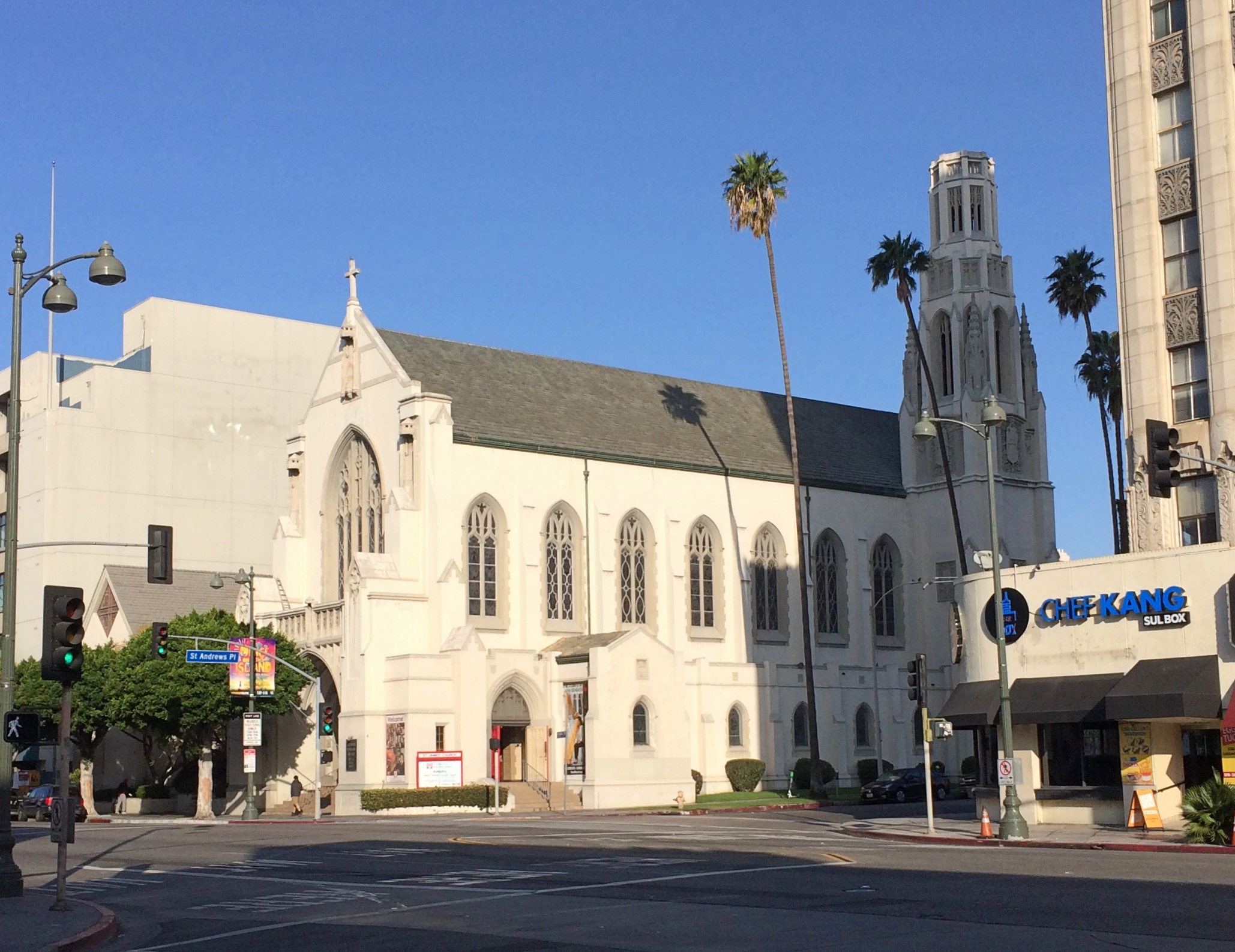 I attended part of the service that was going on at the time. The church dates from the 1920s, done in a more traditional Gothic Revival by a San Francisco architect, Benjamin McDougall. Most notable about the design: a lot of fine stained glass.
I attended part of the service that was going on at the time. The church dates from the 1920s, done in a more traditional Gothic Revival by a San Francisco architect, Benjamin McDougall. Most notable about the design: a lot of fine stained glass.
Immanuel Presbyterian Church isn’t far away on Wilshire Blvd.

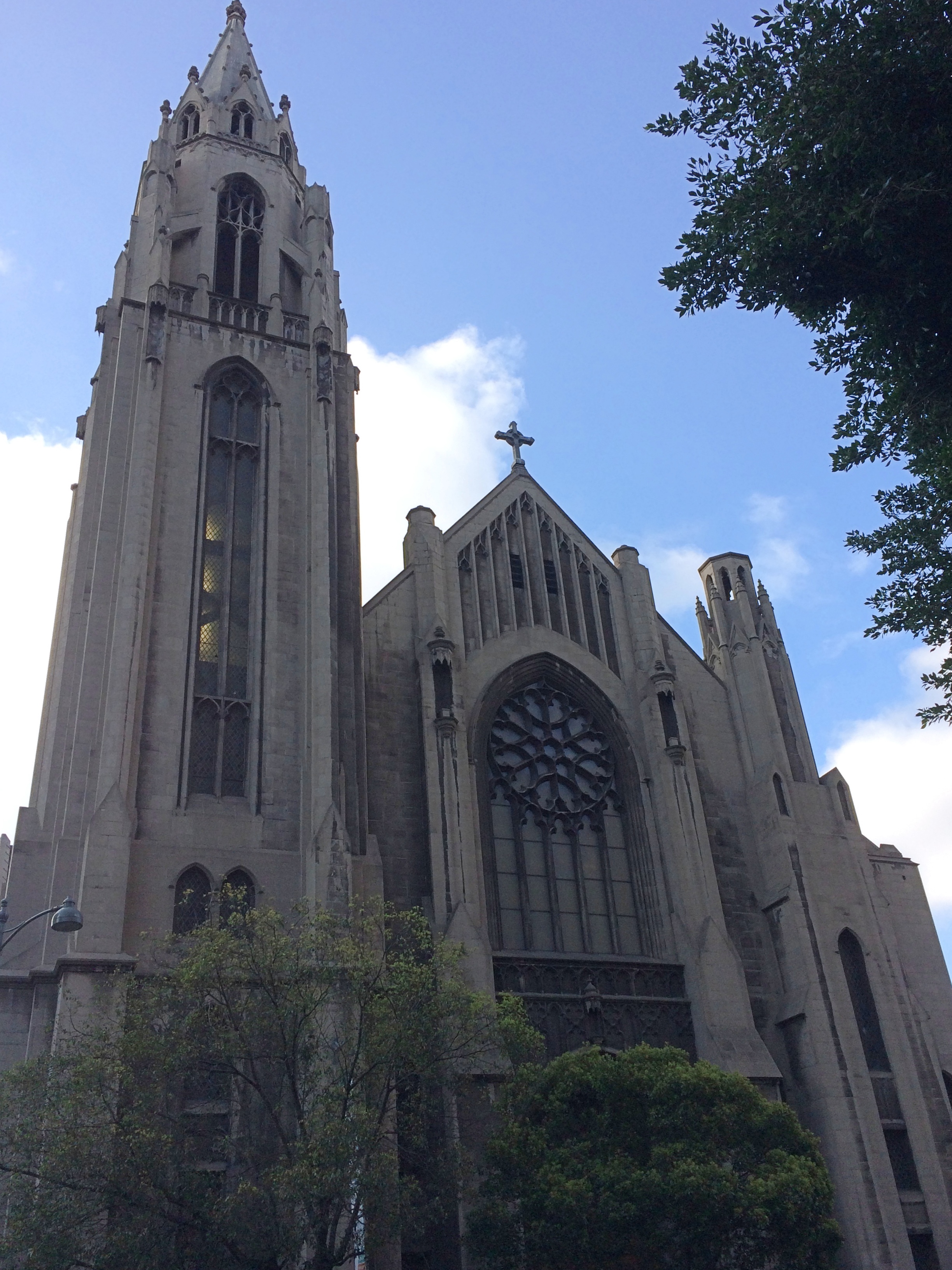 Unlike St. James’, it wasn’t open when I came by. Still, I got a good look from the across the street.
Unlike St. James’, it wasn’t open when I came by. Still, I got a good look from the across the street.
